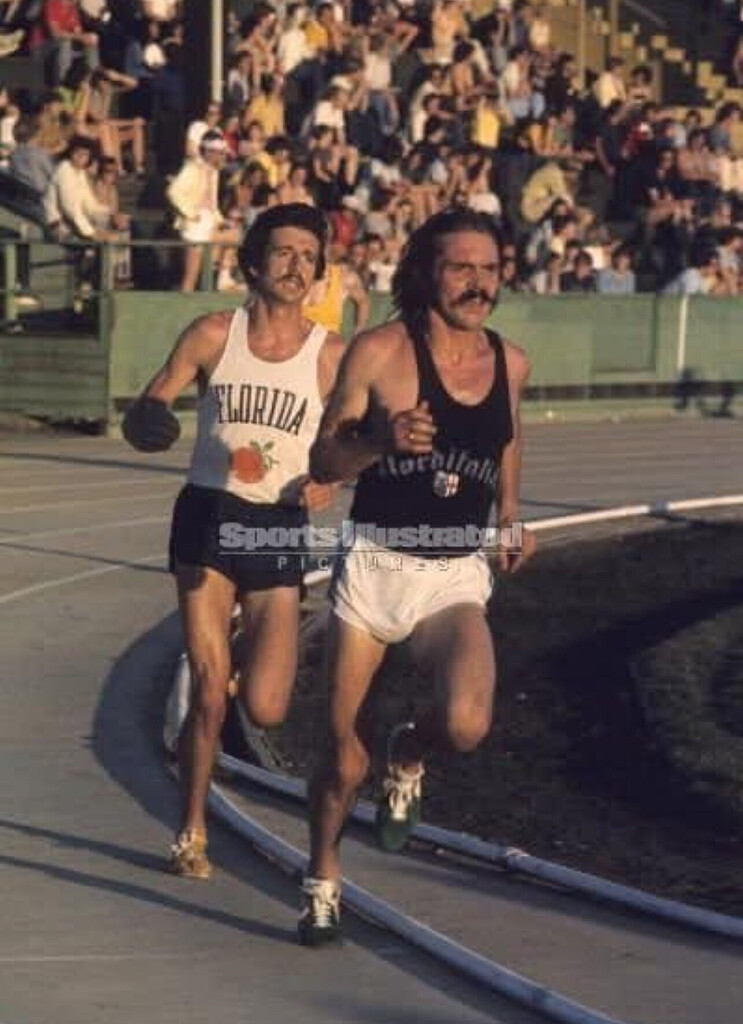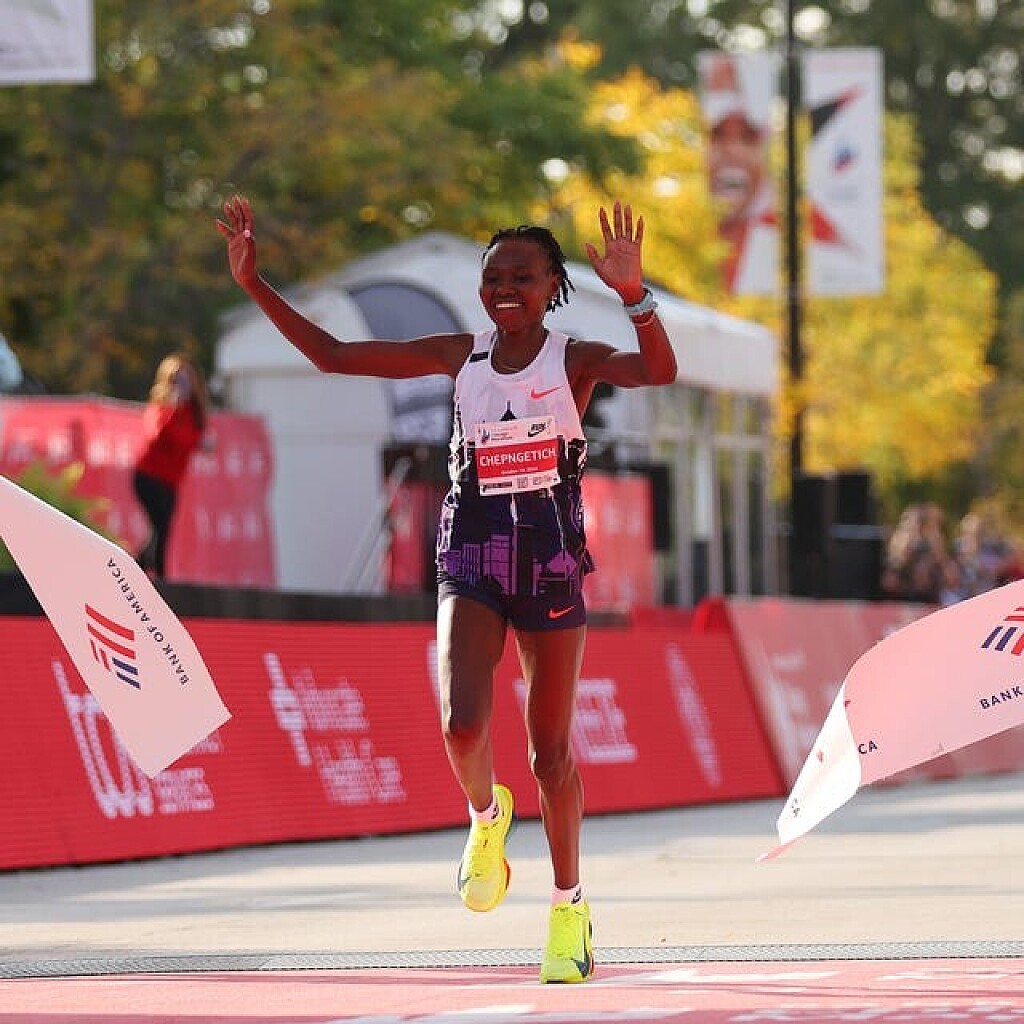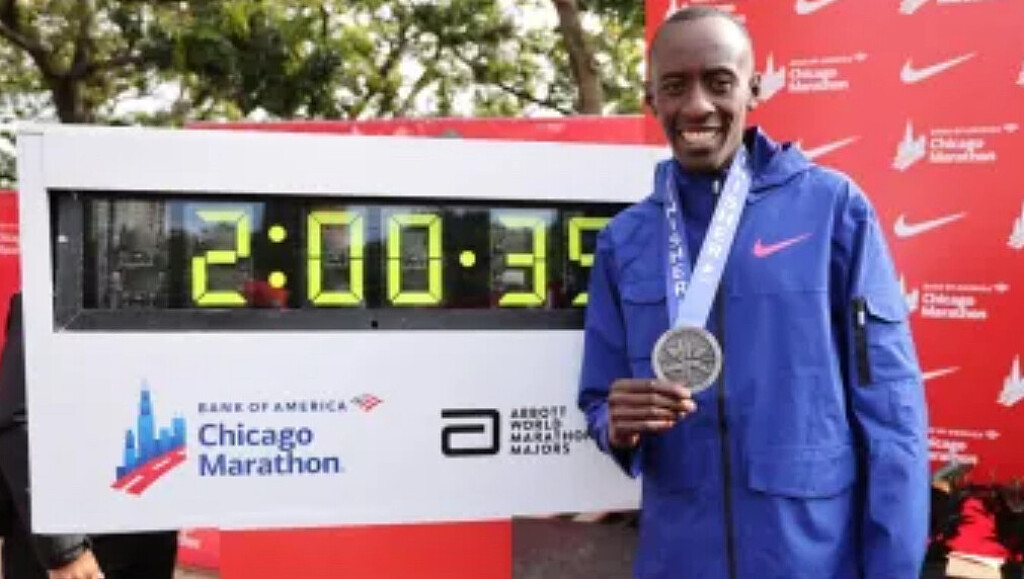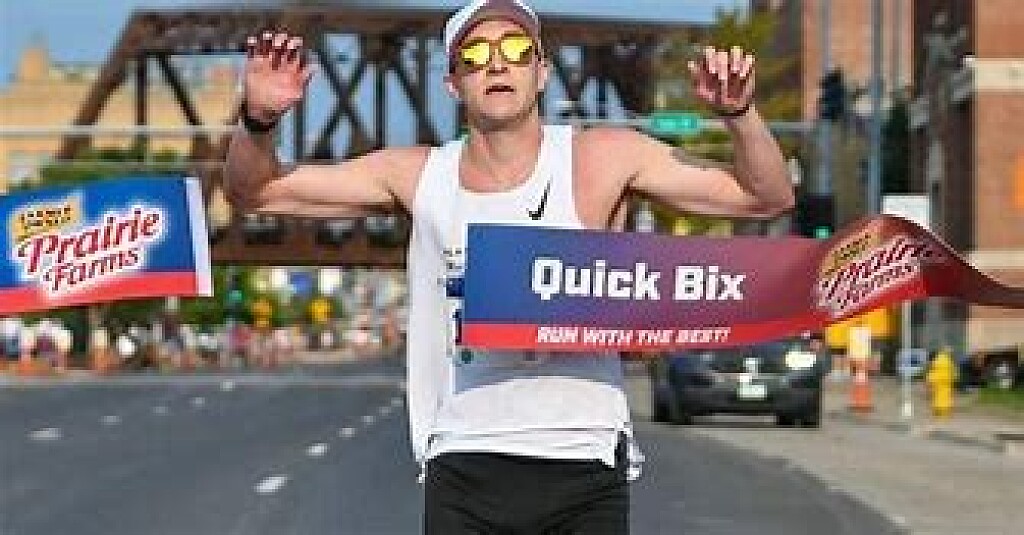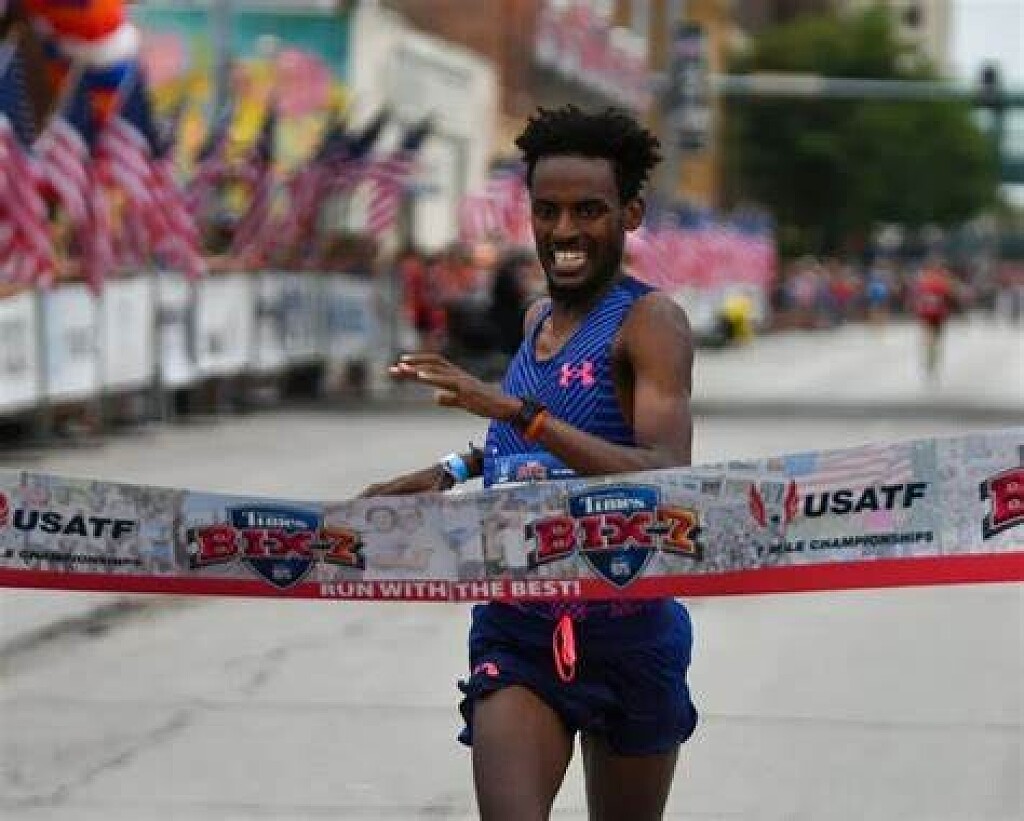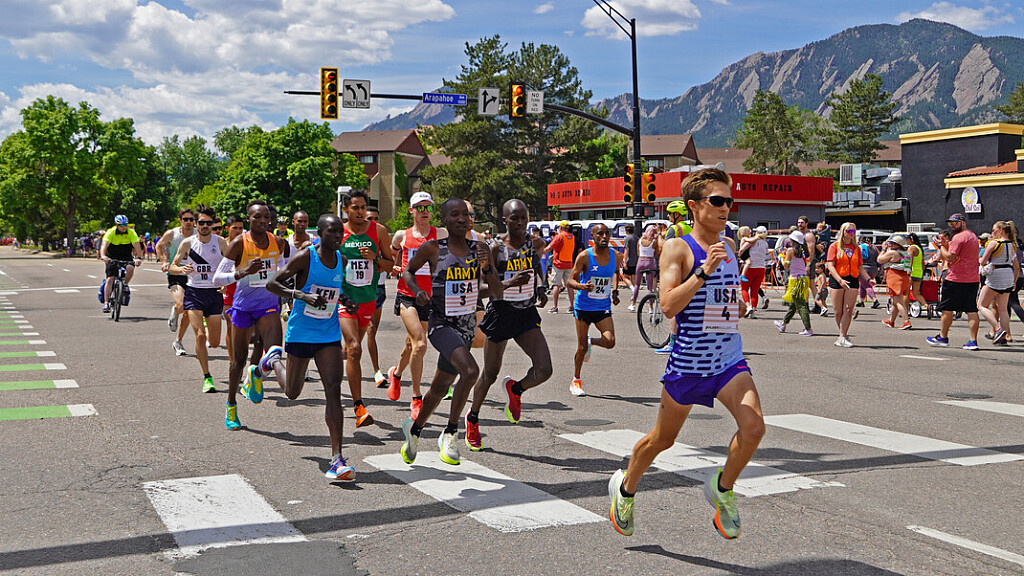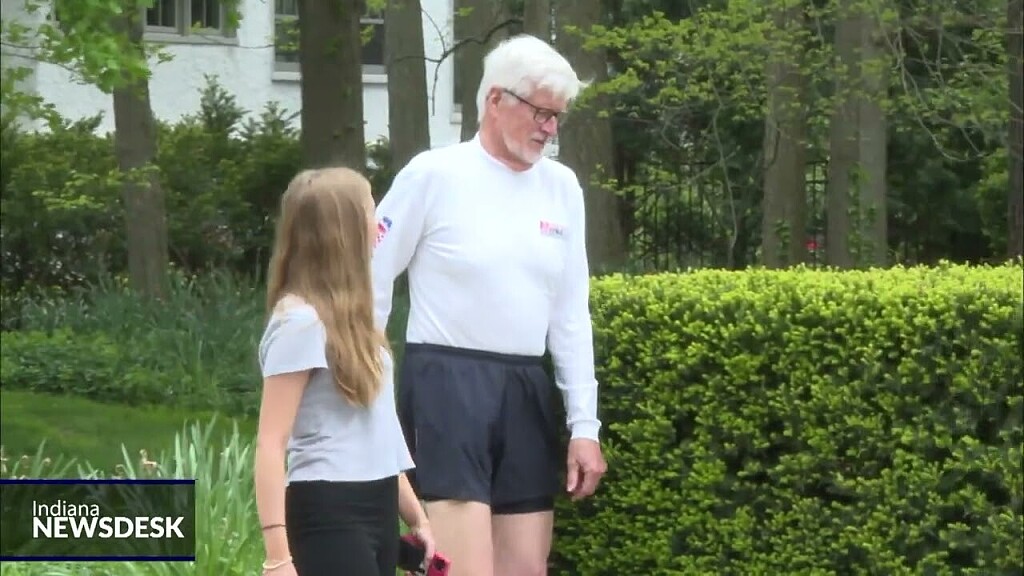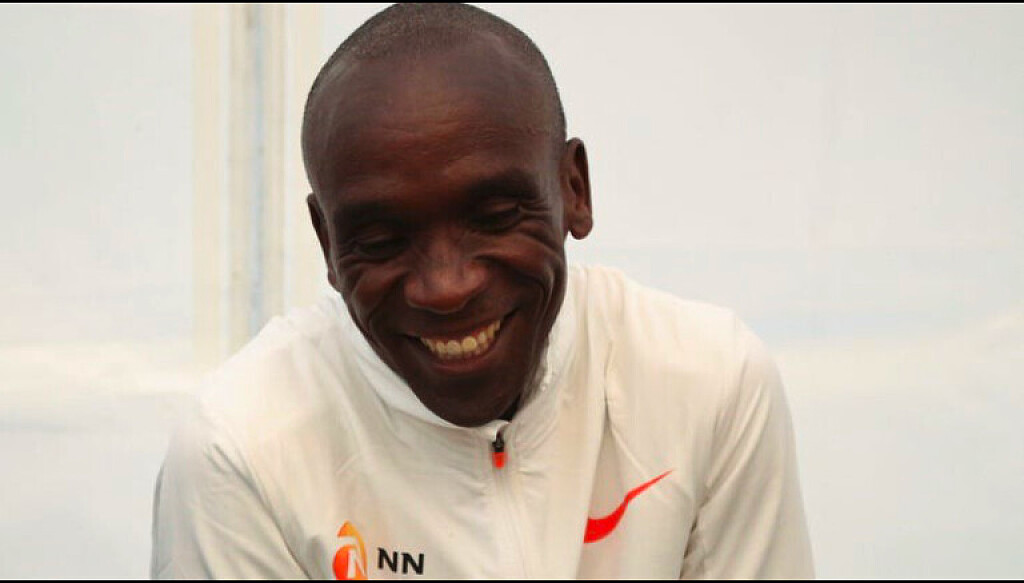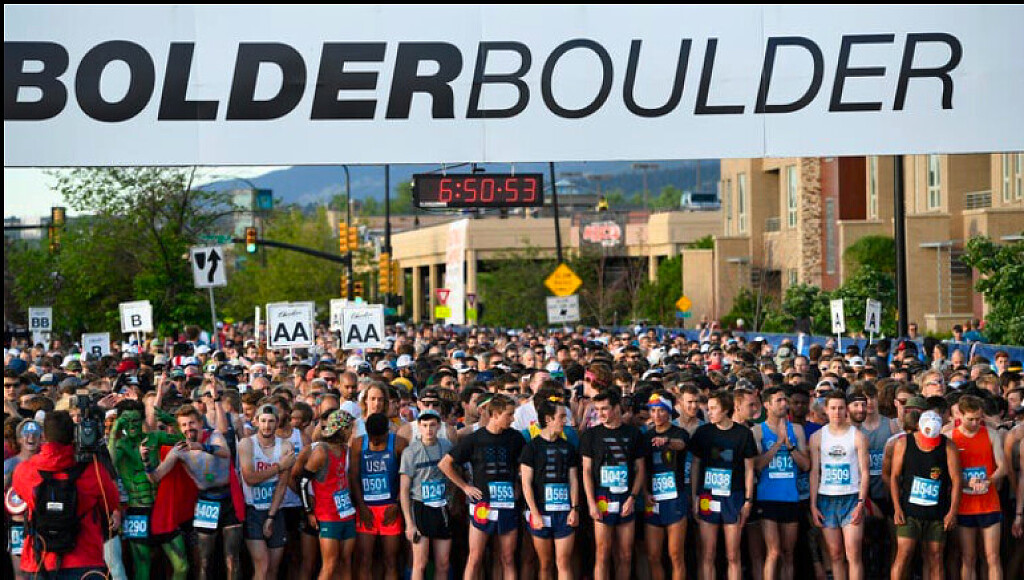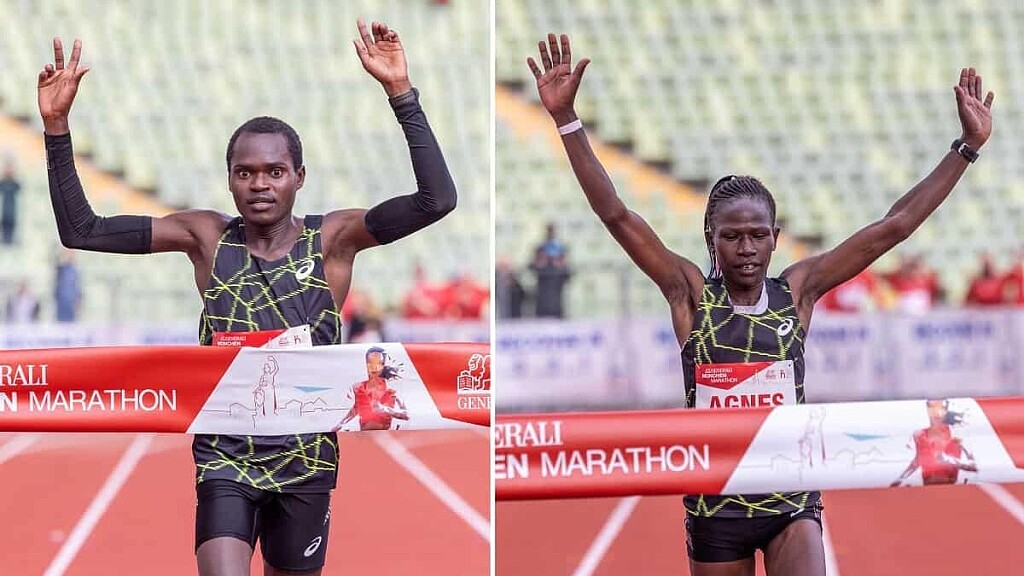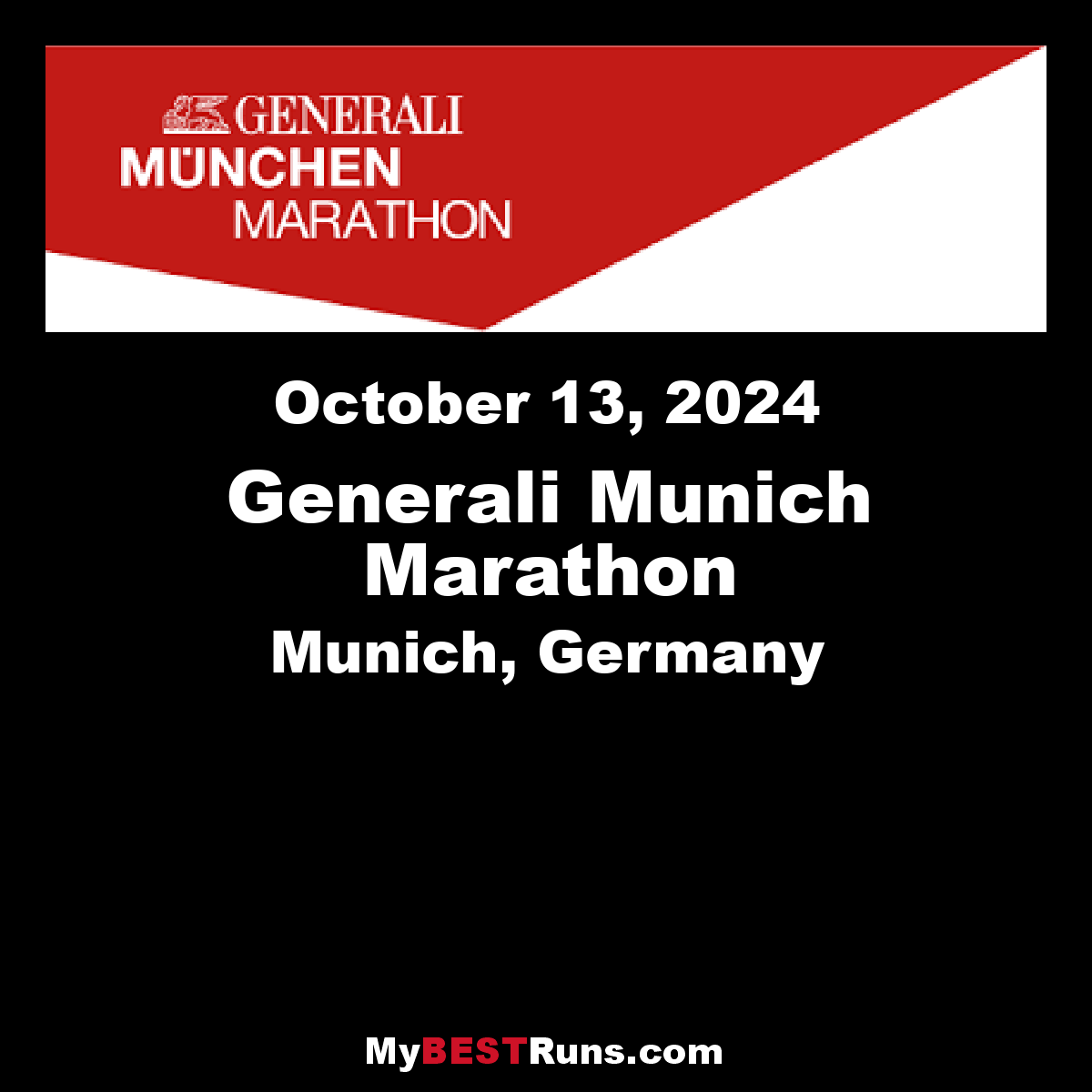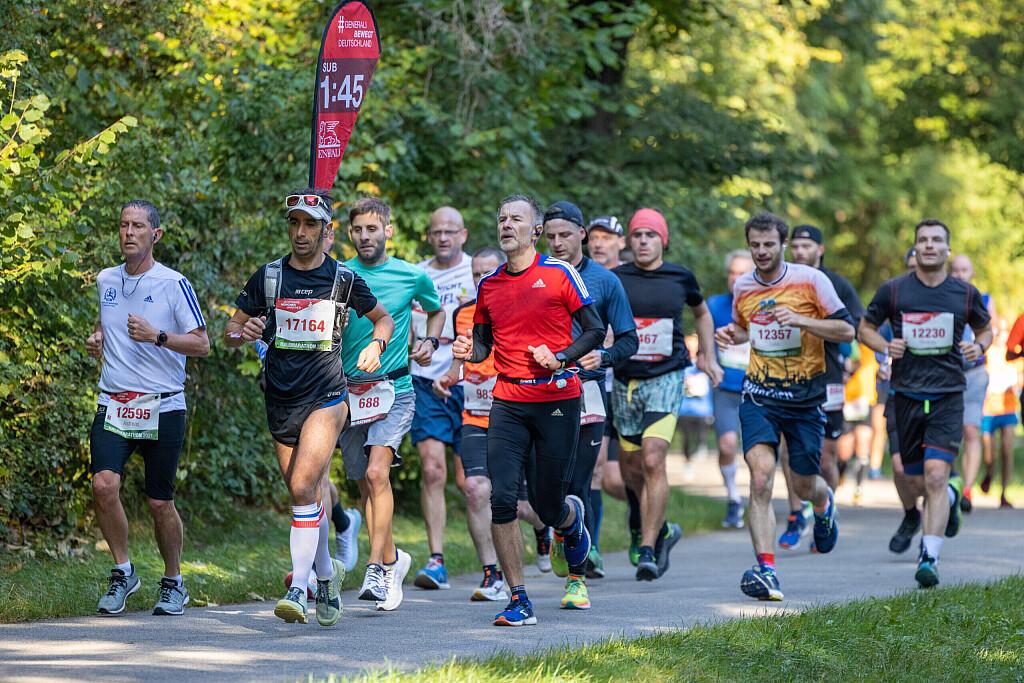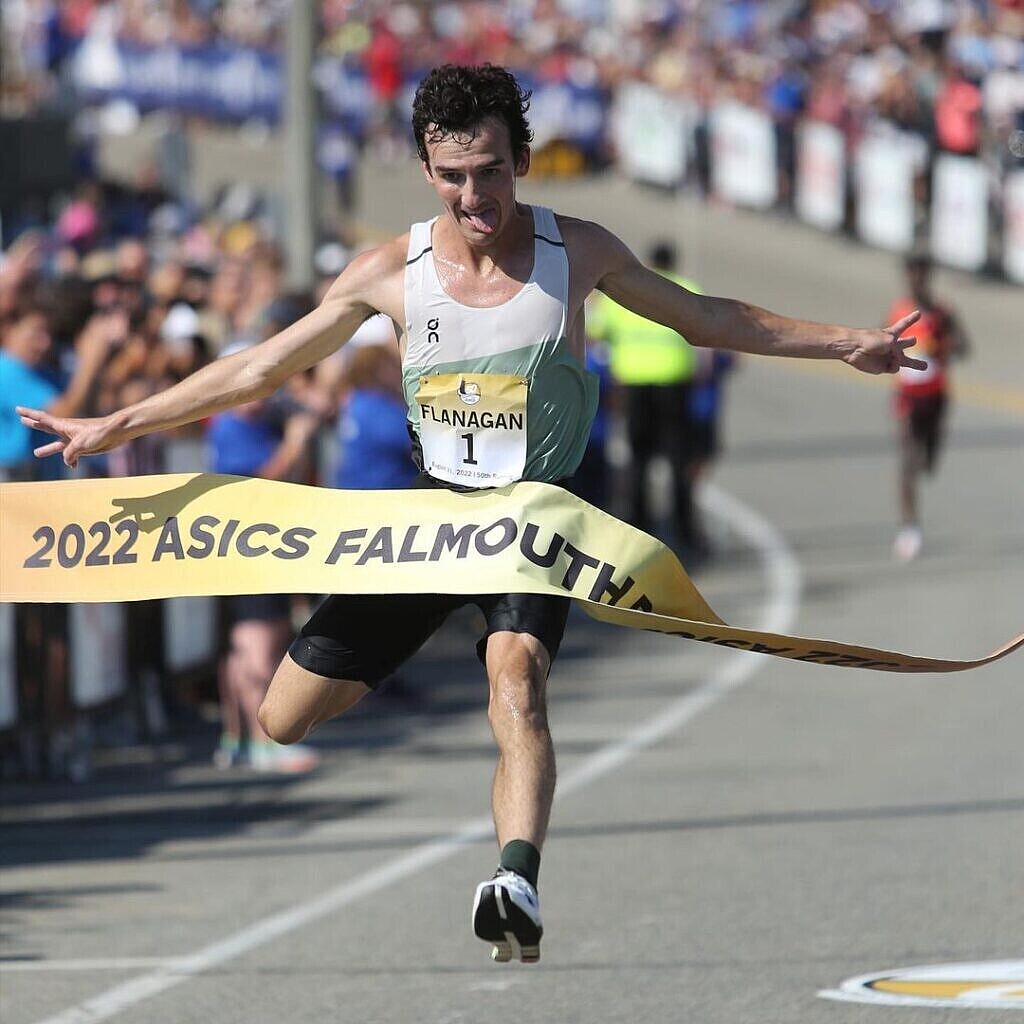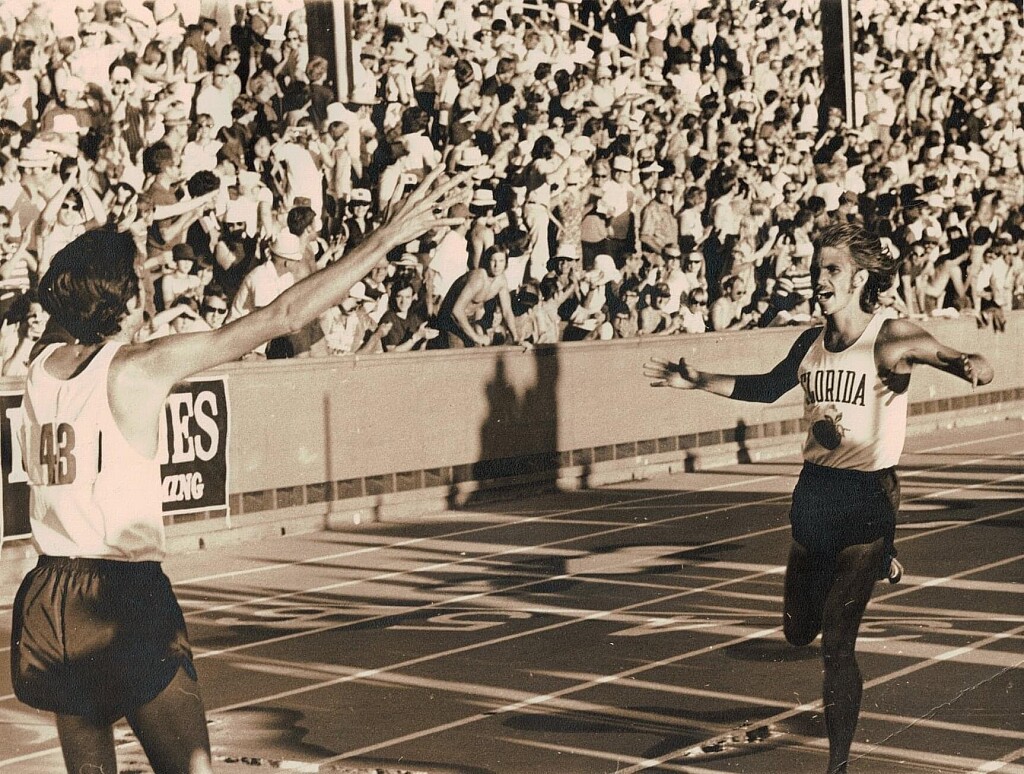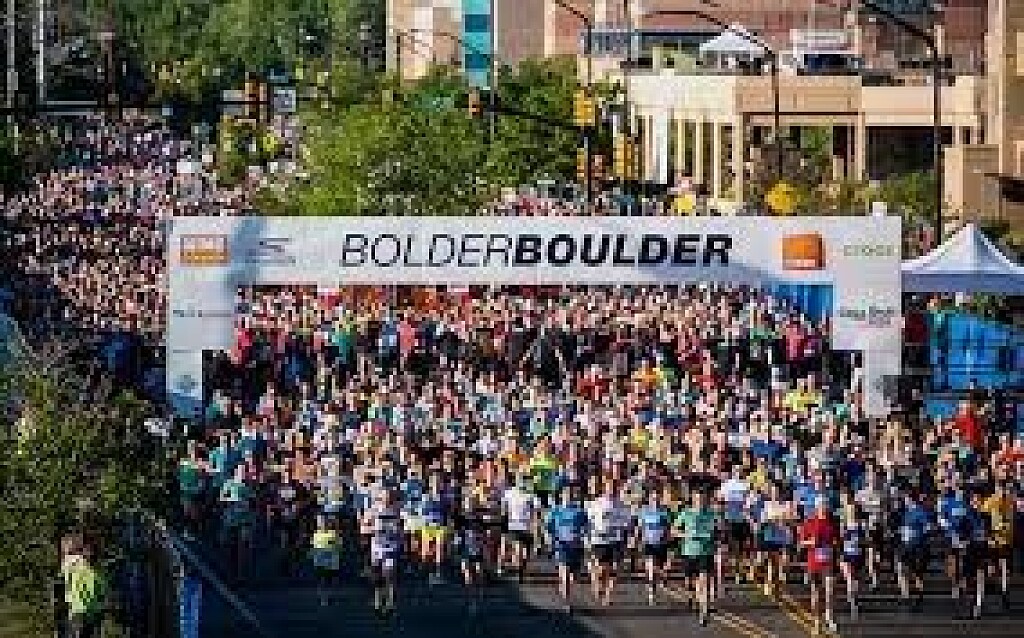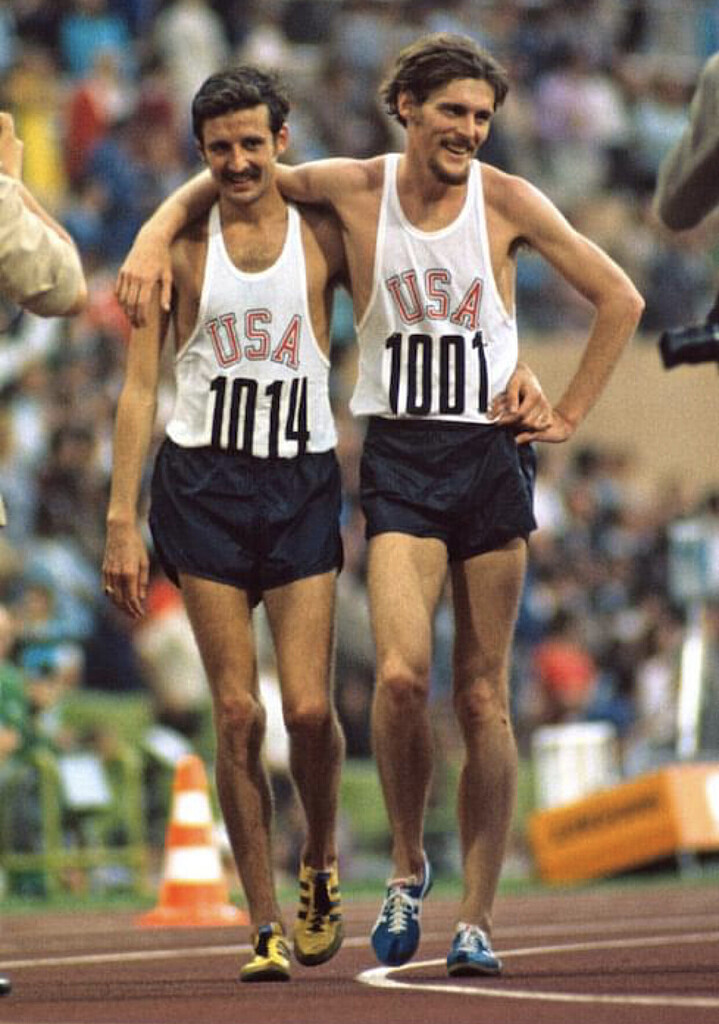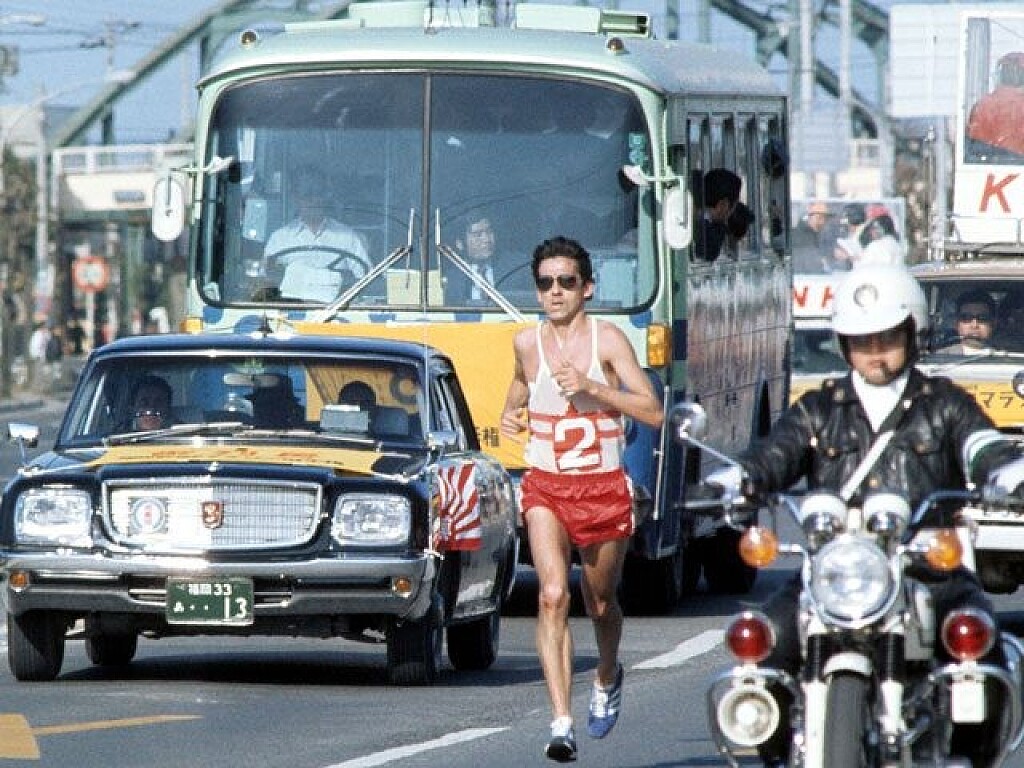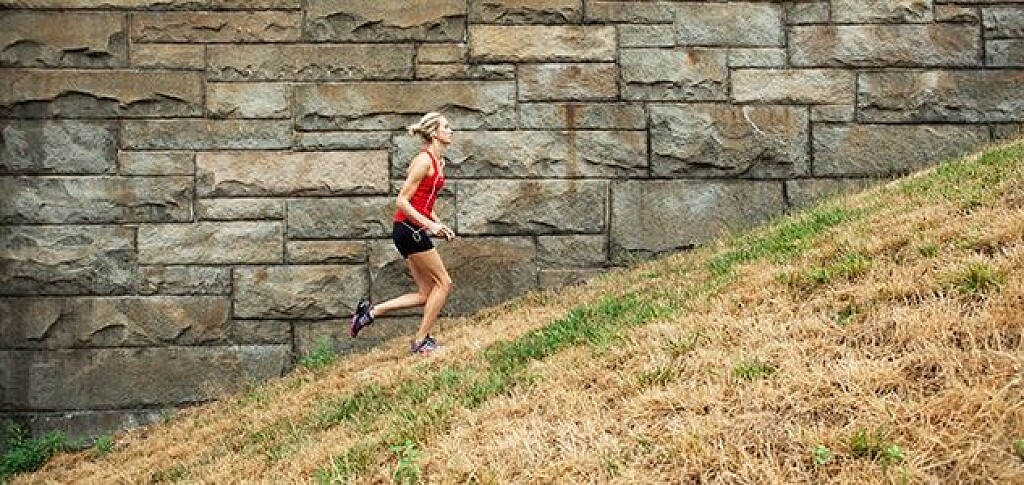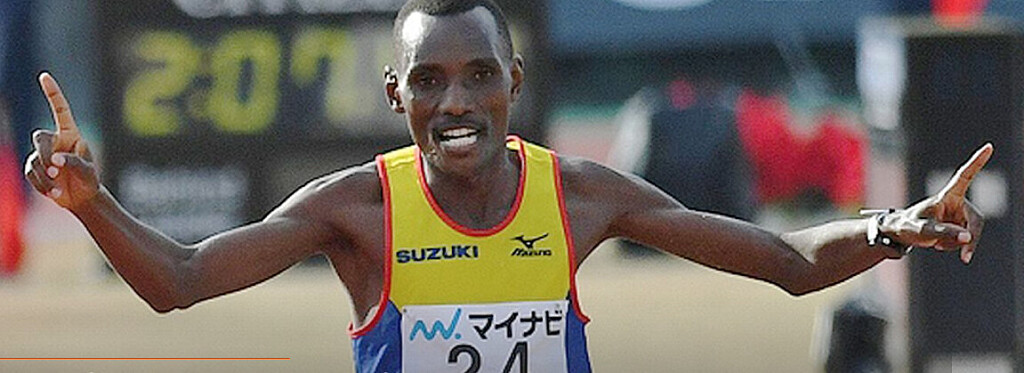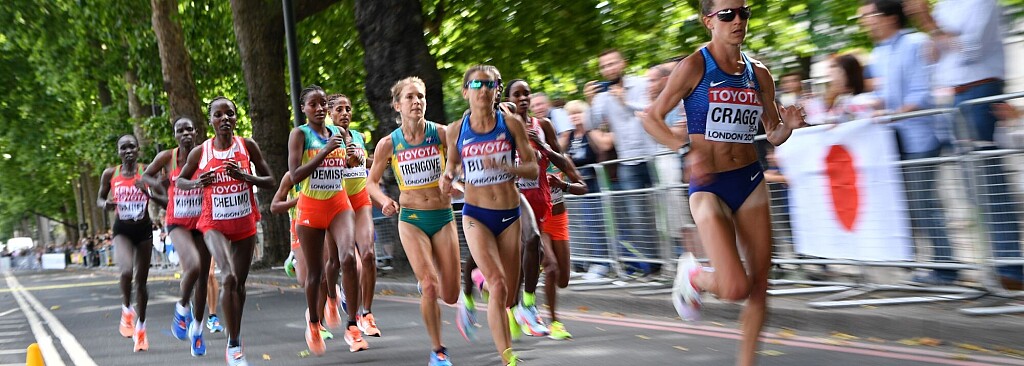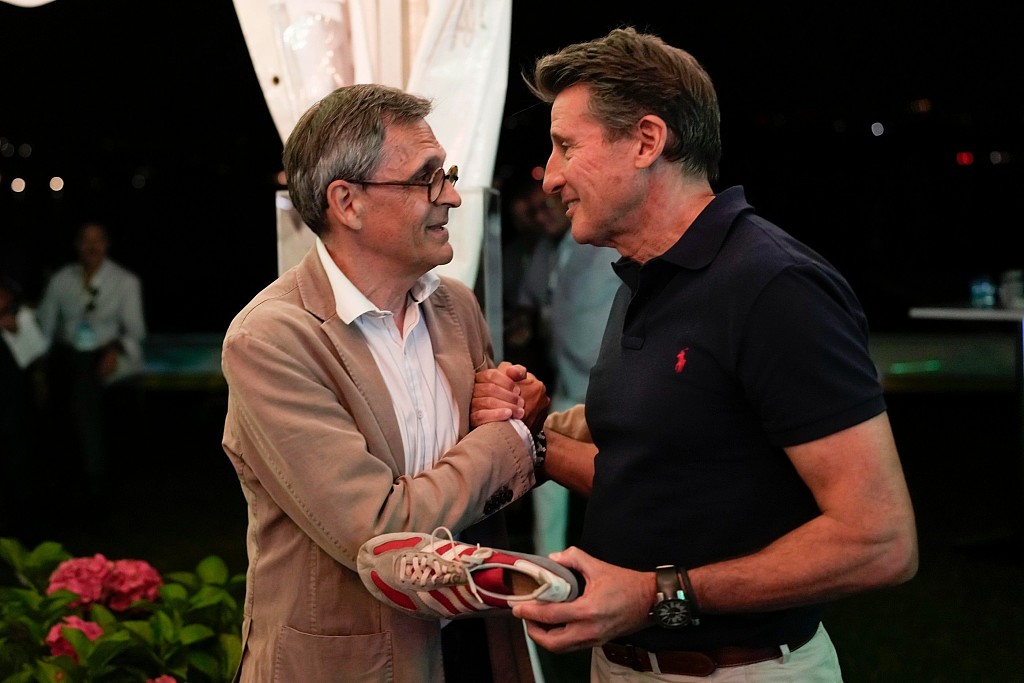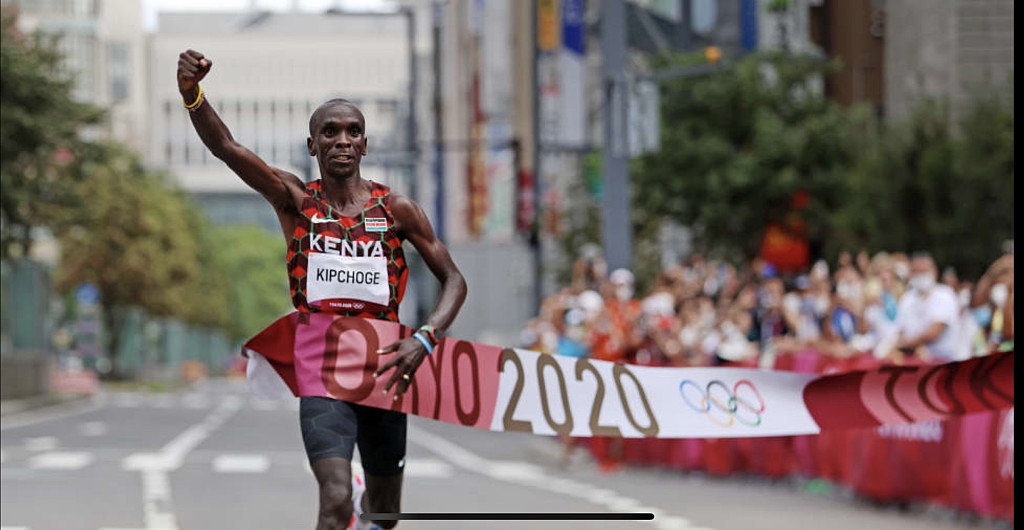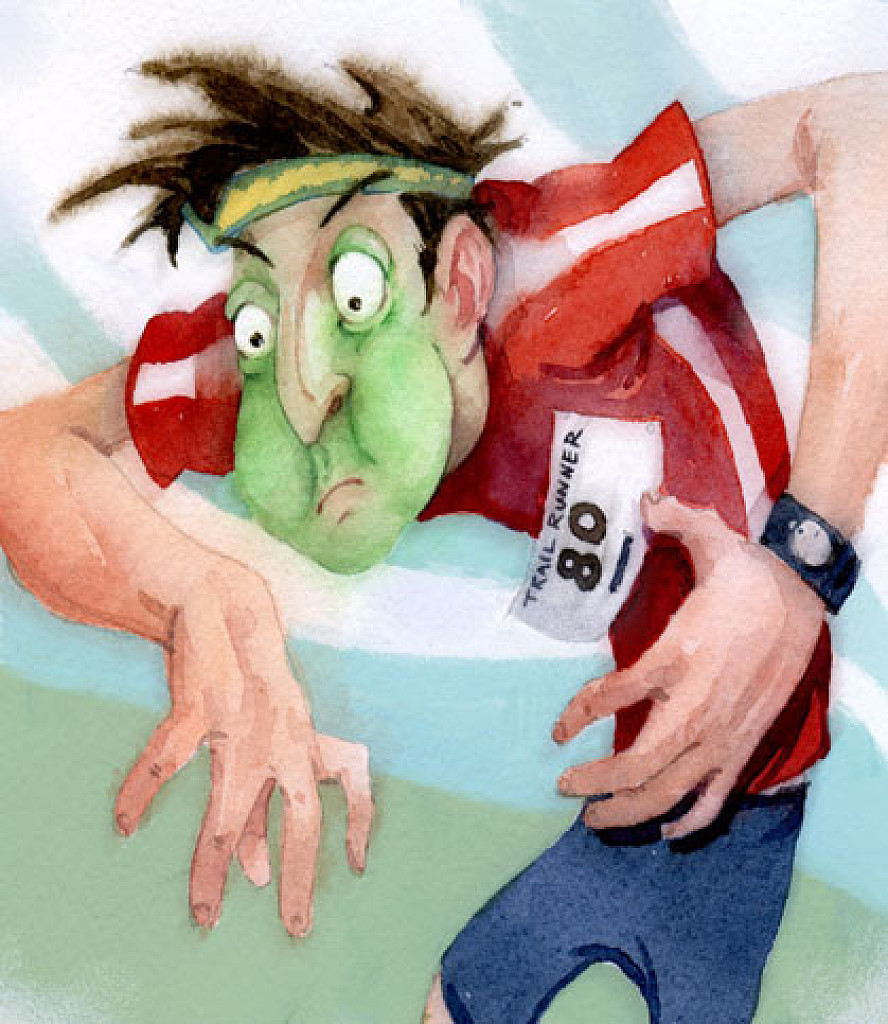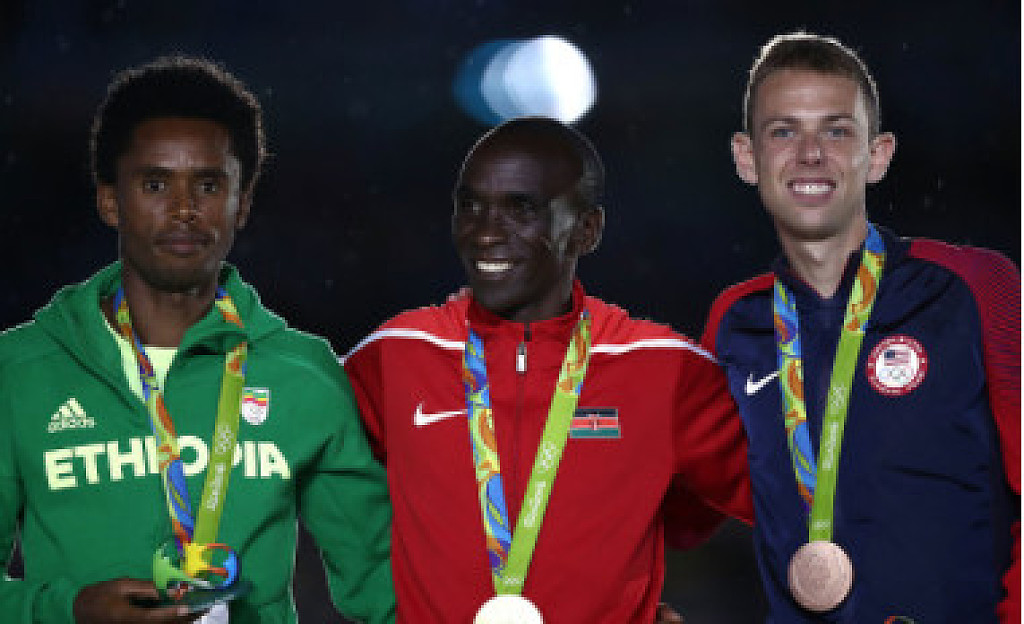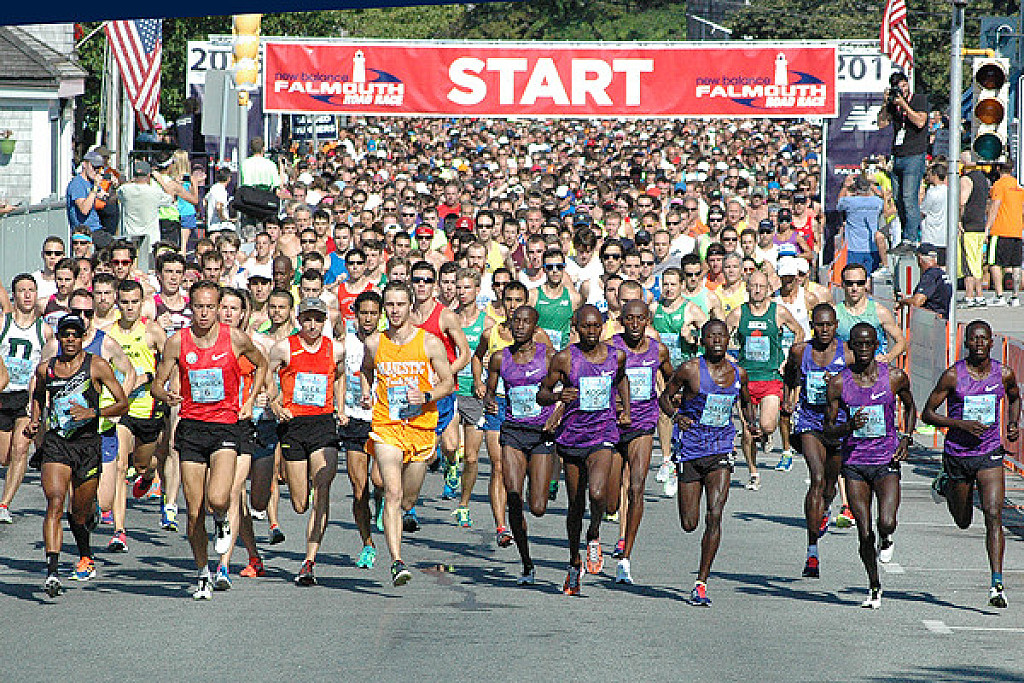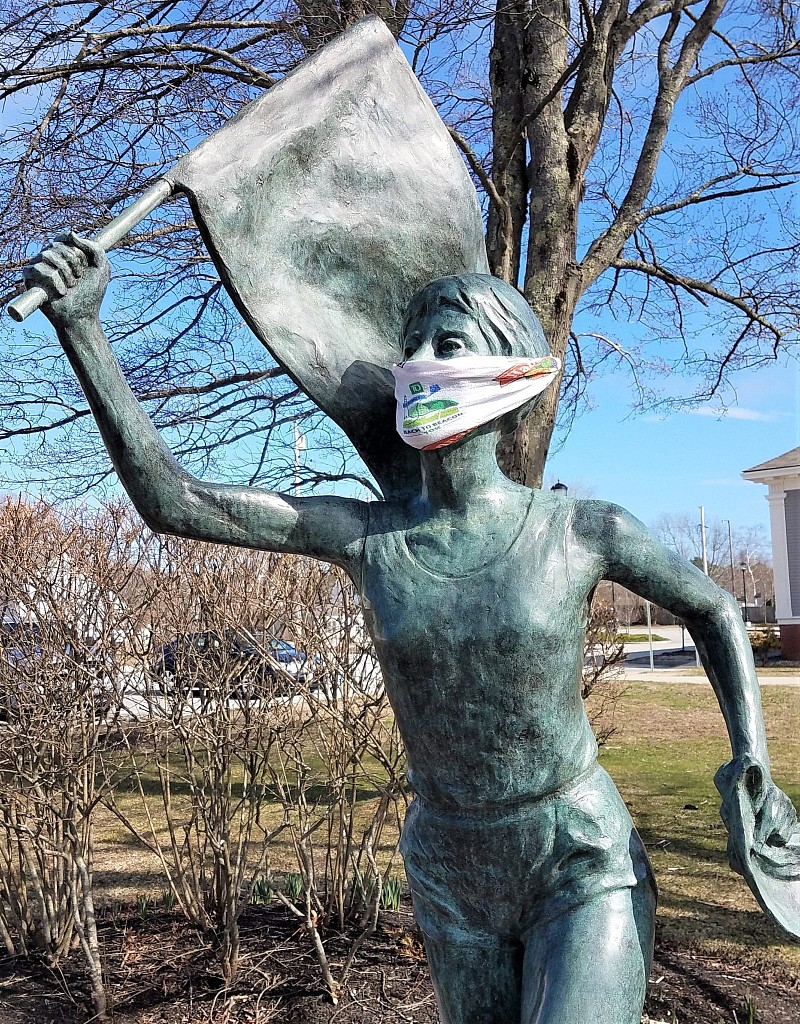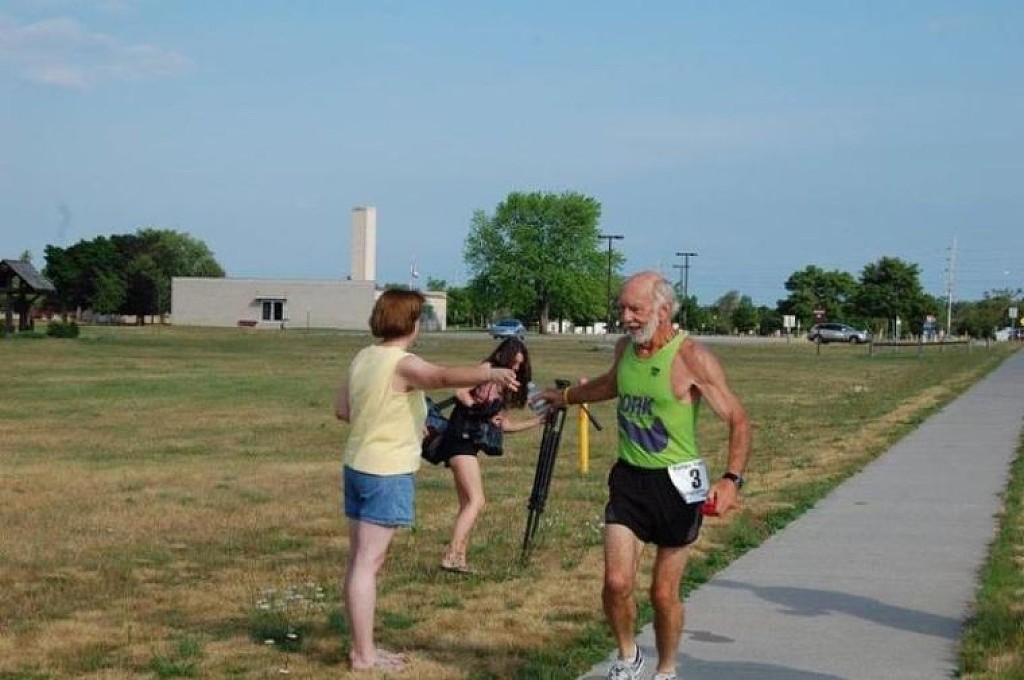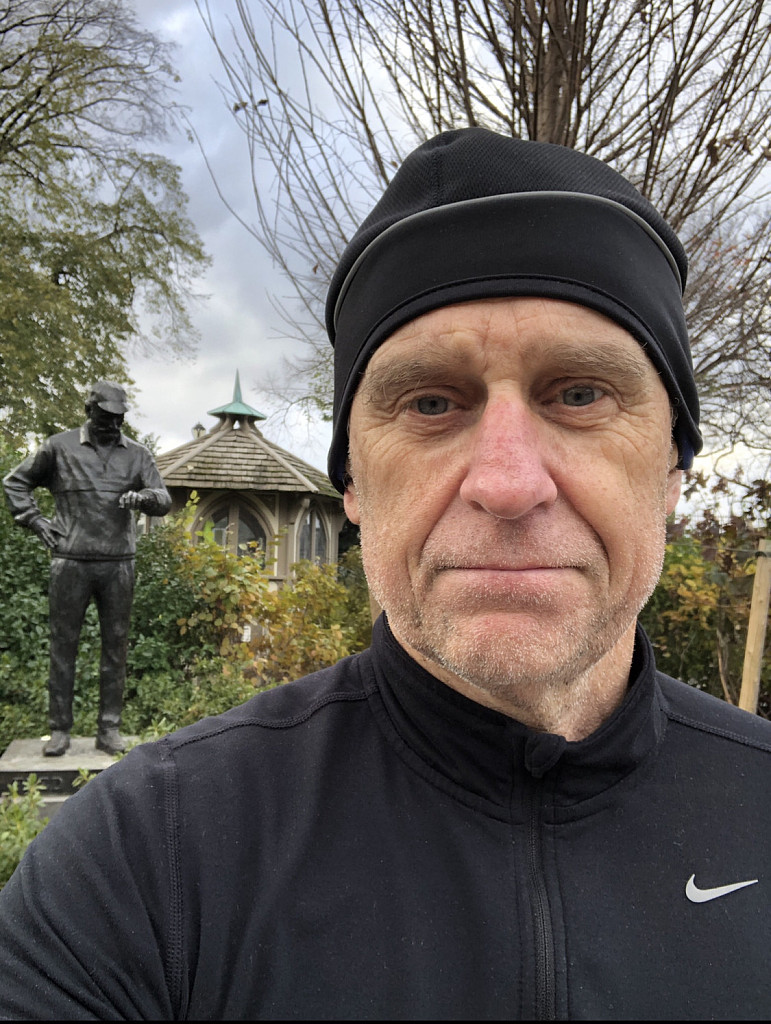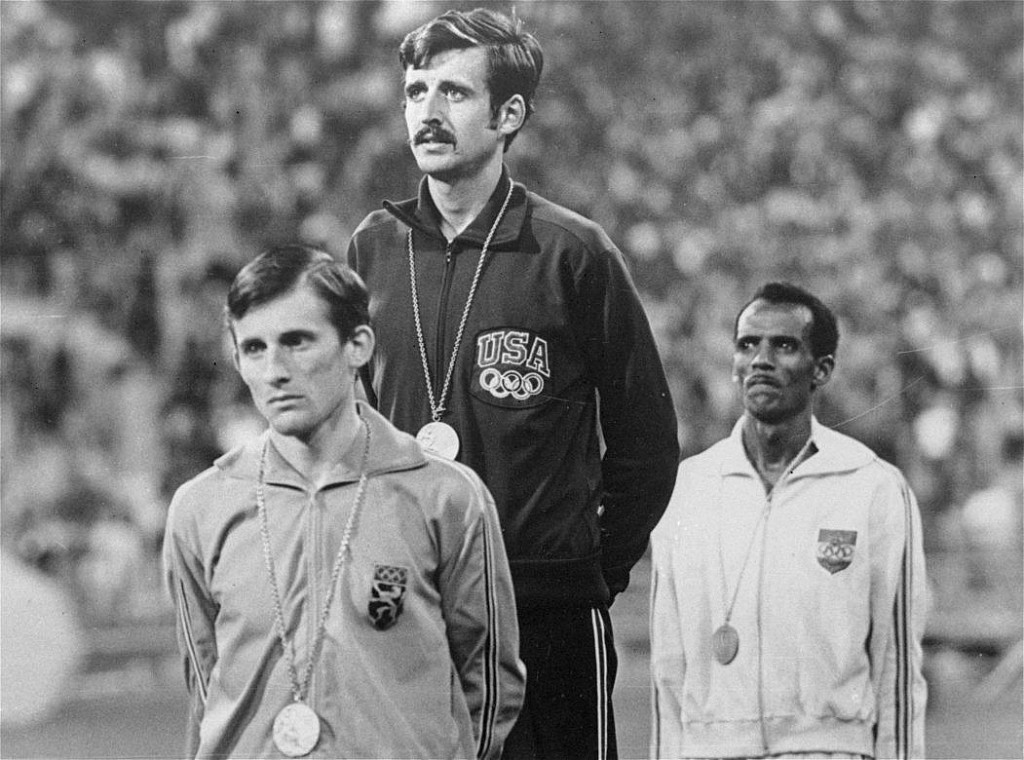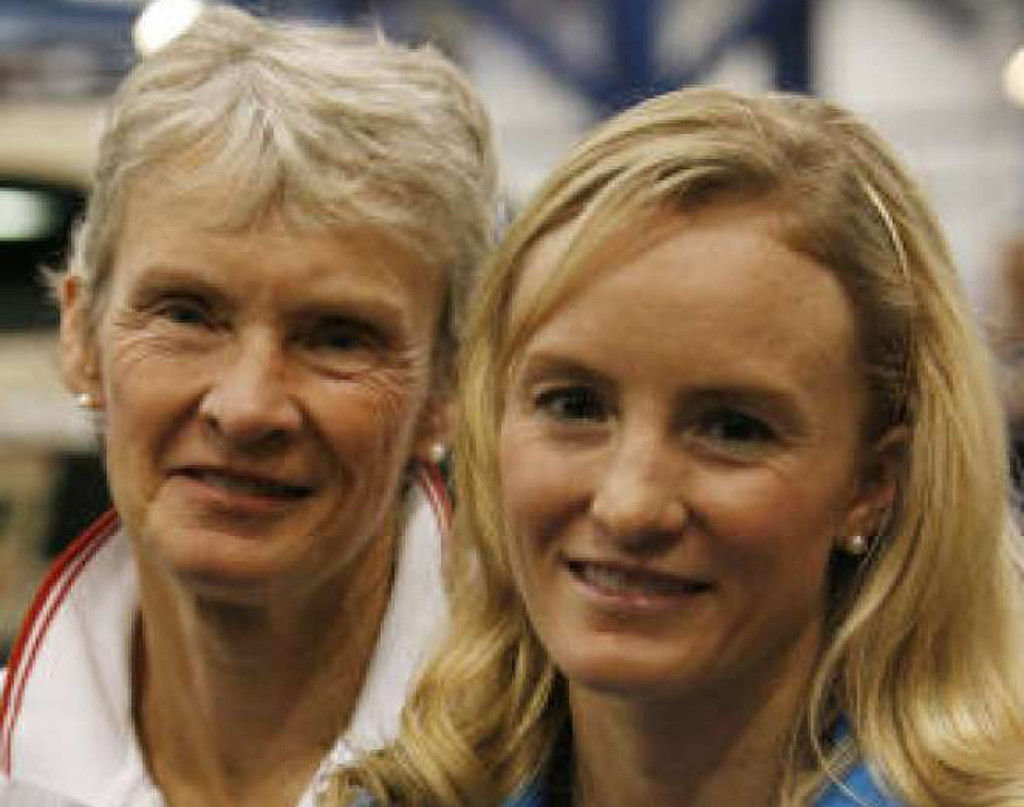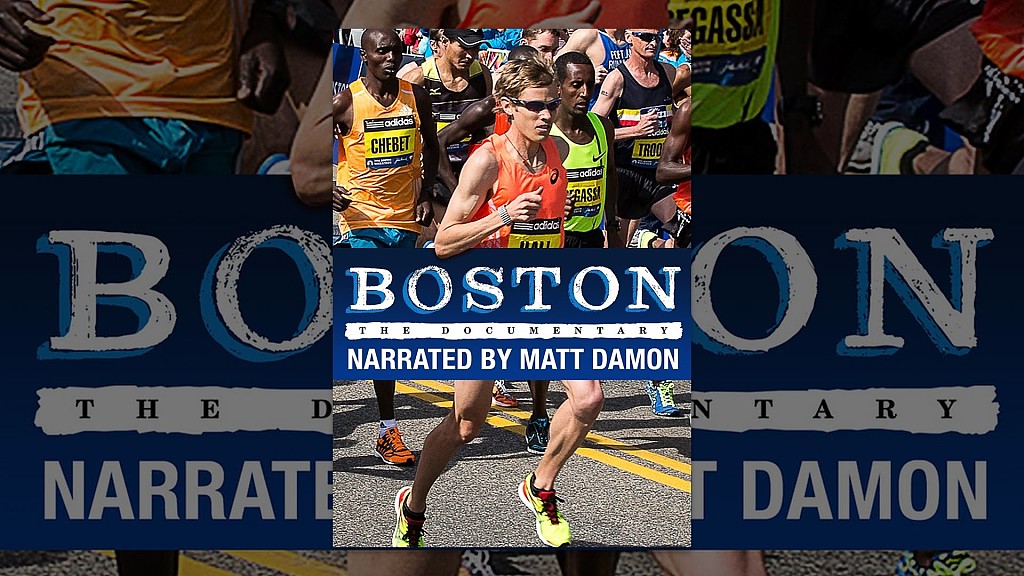Running News Daily
Running News Daily is edited by Bob Anderson. Send your news items to bob@mybestruns.com Advertising opportunities available. Train the Kenyan Way at KATA Kenya and Portugal owned and operated by Bob Anderson. Be sure to catch our movie A Long Run the movie KATA Running Camps and KATA Potato Farms - 31 now open in Kenya! https://kata.ke/
Index to Daily Posts · Sign Up For Updates · Run The World Feed
Articles tagged #Frank Shorter
Today's Running News
Steve Prefontaine’s Final Race: A Victory Etched in History
On May 30, 1975, under the golden light of an Oregon evening, Steve Prefontaine ran what would become the final race of his life. The setting was Hayward Field in Eugene, Oregon—his home track and the spiritual center of American distance running.
In the 5,000 meters that evening, Pre surged past Olympic champion Frank Shorter in the final laps, delivering a trademark gutsy performance. He crossed the finish line first in 13:25, cheered on by a passionate home crowd. It was a classic Prefontaine finish: fearless, front-running, and fiercely competitive.
Tragically, just hours later, Prefontaine died in a car crash driving his MGB, ending the life and career of one of America’s most iconic runners at just 24 years old.
This powerful image—captured by Sports Illustrated—shows Pre in command, moments before his final victory. It remains a poignant reminder of the passion he brought to the sport and the legacy he left behind.
Special thanks to Eric Giacoletto for remembering and sharing this historic moment.
by Boris Baron
Login to leave a comment
MARATHON GROUNDBREAKERS
Since Australia’s Derek Clayton ran history’s first sub—2:10 marathon in Fukuoka, Japan, on 3 December 1967, there have been a total of 4538 sub—2:10 marathons (as of 30 October 2024), 4537 by men, one by a woman.
As with any new ground-breaking performance, Ruth Chepngetich’s 2:09:56 in Chicago on 13 October has forced us to reassess all our past assumptions, or, like many, to doubt the validity of the performance itself. But no matter how we got here, to whatever you want to ascribe it, this is where we are now, 2:09:56 by a woman.
In this new reality, until proven otherwise, Ruth Chepngetich is the new Paula Radcliffe, just as Paula was the new Grete Waitz, one ground-breaker to the next, 1978 to 2003 to 2024.
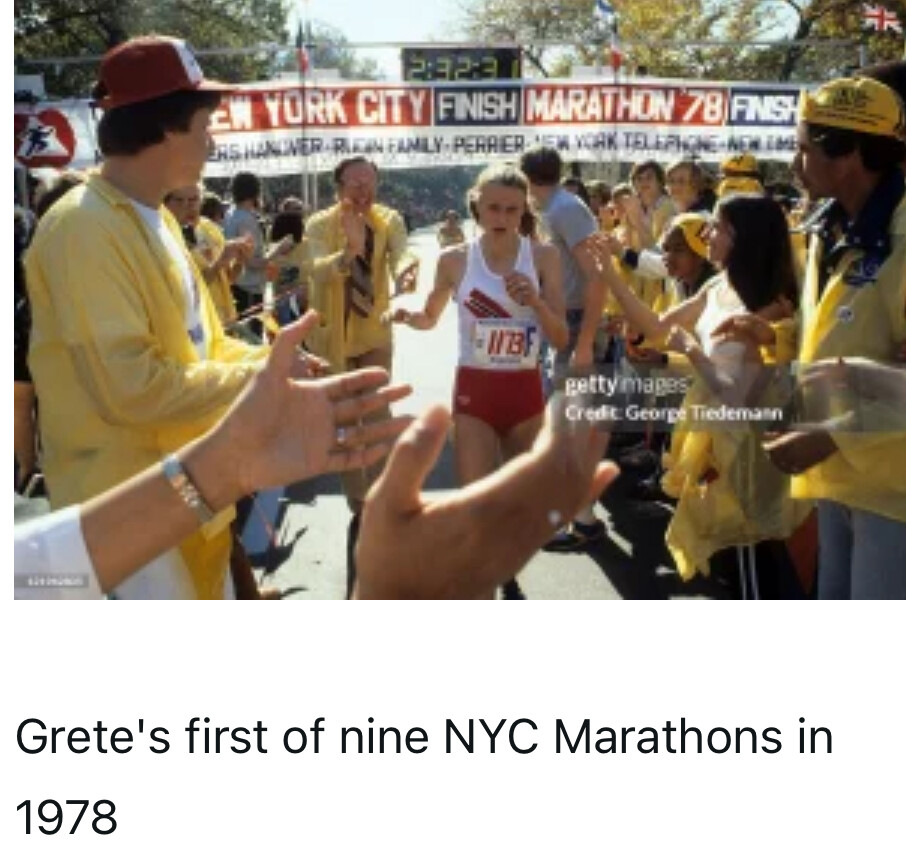
There have been many talented women champions through the years besides those three, including all the pioneers who had to overcome centuries of gender bias that restricted women from even showing their stuff.
But in terms of pure ground-breaking, the 1978 New York City Marathon drew a bright line between what once was and what would be.
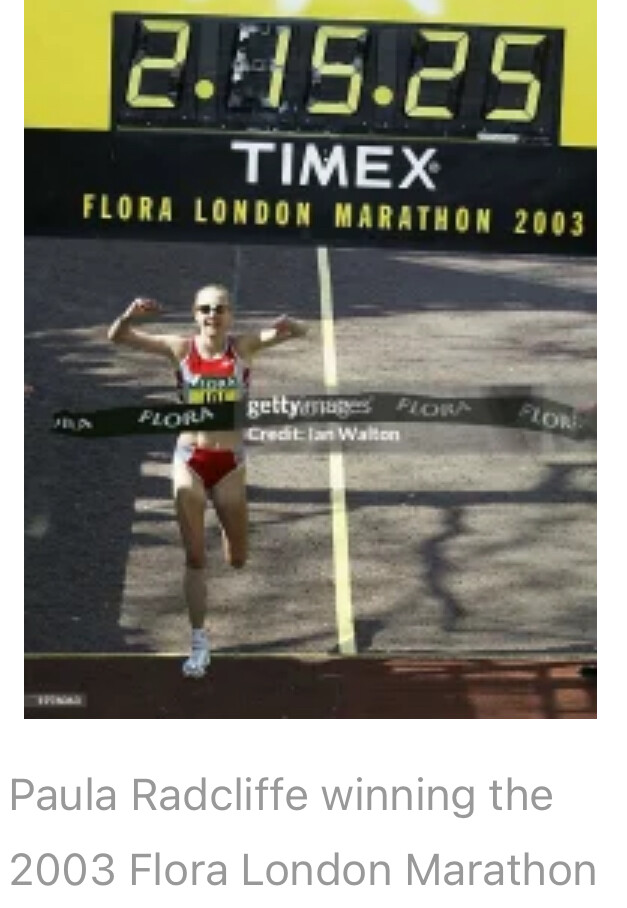
On 22 October 1978, Norway’s track and cross-country star Grete Waitz participated in the marathon for the first time, almost on a whim, as the trip was more of a honeymoon for her and husband Jack after the long track season.
The 2:32:30 world record Grete ran that day was totally unexpected by both the public and Grete herself. She wore bib #1173, wasn’t included on the list of elite women, and came with no specific marathon preparation (not a single run over 13 miles). In fact, she was so upset with husband, Jack, for suggesting she come run the marathon that she threw her shoes at him in the hotel room following her victory.
Still, like almost all debuting marathoners, after a short period of recovery and reflection, Grete concluded she could probably improve next time.
Thus, in New York 1979, following a more careful preparation, Grete ripped nearly five full minutes off her 1978 mark to record history’s first sub—2:30 by a woman at 2:27:33. Her margin of victory over England’s Gillian Adams was 11 minutes (2:38:33). The combination of the mild-mannered former geography teacher from Oslo and the raucous New York City crowds proved transformative, elevating women’s running to heights previously unimagined.
Though Japan’s Naoko Takahashi broke the 2:20 barrier for women in Berlin 2001, after Norway’s Ingrid Kristiansen (2:21:15, London ‘85), America’s Joan Benoit Samuelson (2:21:21, Chicago’85), and Kenyan Tegla Loroupe (2:20:43, Berlin ‘99) all challenged the barrier in the 1980s and ‘90s, it was England’s Paula Radcliffe who established new headlands in the marathon in London 2003 with her 2:15:25.
Nearly two minutes faster than her own 2:17:18 record from Chicago the year before, her 2:15 arced away from Catherine Ndereba’s 2:18:47 from Chicago 2001, completed just one week after Takahashi’s first sub-2:20 in Berlin.
The quality of Paula’s 2:15 can be seen in the 16 years and an entire shoe technology revolution that developed before Kenya’s Brigid Kosgei did Paula one better in Chicago 2019 at 2:14:04. That performance plowed new ground again. And now we have Ruth Chepngetich in Chicago 2024 with history’s first sub-2:10, just a year after Ethiopia’s Tigst Assefa’s first sub—2:12 in Berlin `23 (2:11:53).
Twice before, Chepngetich had come to Chicago with world record intentions. In 2022, she won the race in 2:14:18, just 14 seconds off Kosgei’s record. In 2023 she finished second in 2:15:37. On both occasions she flew through halfway under 66 minutes, only to falter in the second half. Perhaps she was a close reader of Malcolm X.
“There is no better teacher than adversity. Every defeat, every heartbreak, every loss, contains its own seed, its own lesson on how to improve your performance the next time.” – Malcolm x
In simple terms, making innovative strides in athletics requires time, experimentation, and reviewing, similar to how new scientific theories are examined before full acceptance. But women just haven’t been at the marathon game long enough to produce a large enough sample size to define their outer limits with any accuracy. They are barely two generations in since 1978.
Men have been competing for a much longer time with a much larger sample size.
Though Eliud Kipchoge surpassed the two-hour barrier in Vienna in 2019, that was accomplished as an exhibition, not a sanctioned race. In that sense, we are still awaiting the next barrier breaker on the men’s side in the Marathon.
Looking back, England’s Jim Peters stands as the first modern barrier breaker with his 2:18:40 win at the 1953 Polytechnic Marathon between Windsor and Chiswick in West London, England, history’s first sub—2:20.
Next was Ethiopia’s Abebe Bikila, the legendary double Olympic victor in Rome 1960 and Tokyo 1964. His 2:15:17 in Rome still stands as the barefoot marathon world record.
Next came Australia’s Derek Clayton, the first man under both 2:10 and 2:09. His 2:08:34 from Antwerp 1969 lasted for 12 years, holding off challenges throughout the entire Running Boom era headed by Americans Frank Shorter and Bill Rodgers.
Though never world record holders, the two Americans dominated the 1970s boom era, Shorter through the first half, Rodgers the second.
The Eighties were the last decade of international marathon champions: American (Al Salazar, Greg Meyer); European (Steve Jones, Carlos Lopes); Japanese (Toshihiko Seko and the Soh brothers); and Australian (Rob de Castella). Kenya’s Joe Nzau won Chicago in 1983 in a thrilling duel with England’s Hugh Jones when Chi-town was still developing its reputation as a world class event.
Ibrahim Hussein set new records in Honolulu and kick-started the Kenyan marathon revolution
The full East African deluge didn’t begin until 1987 and ‘88 when Kenya’s Ibrahim Hussein (already a two-time and soon to be three-time Honolulu Marathon champion) became Africa’s first New York City and Boston Marathon winner and Ethiopia’s Belayneh Dinsamo set the world record, 2:06:50, in Rotterdam 1988 that lasted over a decade.
The list of marathon stars from other nations scaled back markedly in the 1990s. Mexico had its turn at the top via greats like Dionicio Cerón (1994-`96 London champion), and back-to-back New York Ciy winner German Silva (1994 & 1995).
Moroccan-born American Khalid Khannouchi twice ran a world marathon record, first in Chicago 1999 (2:05:42), then three years later in London 2002 (2:05:38). And who could forget the personable Brazilian, Marílson Gomes dos Santos, who won New York City twice in 2006 & 2008, or Meb in NYC `09 and Boston 2014??
But the United Nations pickings get rather meager after that as East African athletes have had a stranglehold on the sport of marathoning, most dominatingly by Kenya’s Eliud Kipchoge. His run of sustained excellence over 42.2 kilometers was, and is, unprecedented in its longevity, including double gold in Rio 2016 and London 2020. And his last world record of 2:01:09 in Berlin 2022.
Sadly, the current record holder, Kelvin Kiptum, died in a car accident in February 2024 after establishing the 2:00:35 world record in Chicago 2023.
With the 2024 TCS New York City Marathon scheduled this weekend, we don’t expect to see any record performances. Yet, all the above is why we follow the game, isn’t it, to witness the arc of improvement over time, while hoping to discover a new name to remember? It’s as valid a focus as any other in this life.
And despite its many flaws and corruptions, the sport of marathoning retains an innate dignity that many endeavors do not. People may have bruised, battered, and tarnished it in the name of glory and money. But it survives, nonetheless, as a simple reflection of the human drive to achieve more in the quest to discover our best.
Doesn’t always turn out that way, but I don’t think we are done with it quite yet. Onward!
by Toni Reavis
Login to leave a comment
The Chicago Marathon has a strong history
First run in 1977, this Sunday, Chicago hosts its 46th marathon (it lost 2020 to the Covid-19 pandemic; 1987 to sponsorship issues). One of the six Abbott World Marathon Majors, the history of the BofA Chicago Marathon has been one of rising, falling, and rising again.
In 2023, it witnessed its third men’s marathon world record, 2:00:35, gloriously produced by the late Kenyan star, Kelvin Kiptum, who tragically died in a car accident on February 11, 2024 (age 24 years), in Kaptagat, Kenya.
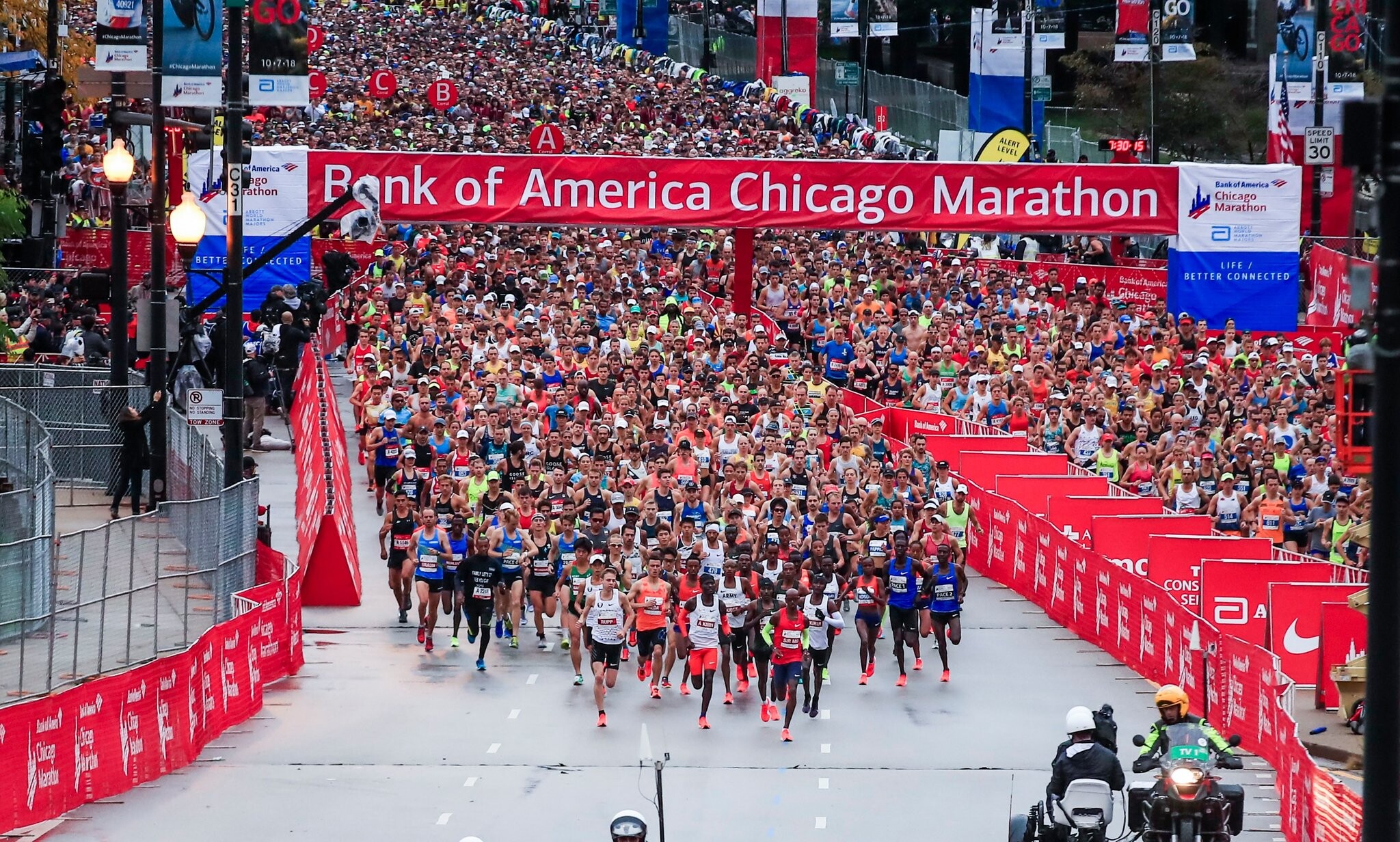
But the roots of the modern Bank of America Chicago Marathon traces back to 1982 when, in its sixth year, known as America’s Marathon/Chicago, the event rebooted, much as New York City 1976 was a reordering for the Big Apple 26-miler.
In America’s bicentennial year, the New York Road Runners expanded their event from four laps of Central Park to all five boroughs. It was a gamble. But in one fell swoop, the event grabbed the public’s attention, took on international importance, and ushered in a new era of urban marathons, even though they had run six previous marathons under the same banner.
In 1982, Chicago’s move from a regional marathon to the big time came about because of two things: one, the $600,000 budget put up by race sponsor, Beatrice Foods, and the hiring of one Robert Bright III of Far Hills, New Jersey to serve as athlete recruiter.
Bob Bright (left) at the Litchfield Hills Road Race in Connecticut with Nike east coast promo man, Todd Miller.
Recommended to the event by Olympians Frank Shorter and Garry Bjorlund, Bright had successfully elevated a modest 15K road race in Far Hills, New Jersey, called the Midland Run, to international prominence in 1980. So loaded was the Midland Run elite field, Sports Illustrated sent a reporter and photographer to cover the event.
What Bright brought to Chicago was zeal and a vision. Before Bright, there had been very little orchestration of competitive marathon racing. The Bright idea was simple: actively recruit a field of international athletes who came ready to run, so elite competition would become the hallmark of the event.
First, a brief history. For many decades, Boston dominated the marathon scene as essentially the only game in town. Yes, there was the Yonkers Marathonin New York, first contested in 1907; the Polytechnic Harriers’ Marathon for the Sporting Life trophy in England, which began in 1909. The Košice Peace Marathon in Slovakia joined the club in October 1924; Enschede and Fukuoka in 1947; Beppu in ’52.
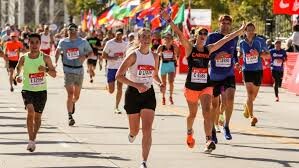
But the Boston Athlettic Association’s attitude from its marathon’s inception in 1897 up to the mid-1980s remained, “We’re running our race on Patriots’ Day starting in Hopkinton, Massachusetts at noon. It will cost you three bucks to enter. See you at the bus line for the ride out to the start.” No bells, no whistles, no invitations.
When New York City debuted in 1970, it spun four laps of Central Park to total its 26.2 miles. But in 1976, with the city in a major financial difficulty amidst America’s Bicentennial, the New York Road Runners boldly took its marathon from the confines of Central Park and expanded it through all five boroughs hoping to attract more tourists.
Race Director Fred Lebow recruited a few big guns upfront to entice press coverage, Olympic gold and silver medalist Frank Shorter along with Shorter’s rival, American record holder from Boston 1975, fellow Olympian, Bill Rodgers. Everyone else filled in from behind, with the City of New York being the true star attraction.
First considered a onetime gimmick, the five-borough experience proved so successful, the NYRRs embraced it as the path forward. Still, the actual races in NYC were never very competitive. Rodgers won by three minutes over Shorter in ‘76, 2:10:10 to 2:13:12. Then dominated for the next three years, as well.
Chicago 1982 would be the first, full–blown, orchestrated marathon race, as Bright had a specific recruitment strategy.
“We wanted six guys who thought coming in that they had a chance to win,” said Bright. “Then we wanted six more behind them who figured they had a shot at the top 10. So, right away we didn’t go after a guy like Alberto Salazar (who was ranked number one in the world after wins in New York City in 1980, a short-course world record in ‘81, and a Boston title in 1982.)
“And if you figure that a top race has a main pack of 10 to 15 athletes, you’re going to double that number in invitations. That guarantees that even if two of every five don’t run well for one reason or another, you still have a big group ready to race.”
Redundancy was the key, the money, the magnet. The total amount taken home by runners from Chicago in 1982 was $130,000.
This was when Boston was still embracing its amateur roots, stiff-arming the new breed of runners looking to get paid for their craft. In New York, Lebow had to keep his payments under the table in order to avoid being billed for city services on race day.
Chicago put up $48,000 in prize money for the men in 1982, with $12,000 going to the winner, 600 for 15th place. The women’s split was $30,000, with $10,000 awarded for the win through $500 for 10th. The remaining $52,000 represented the grease in upfront, under-the-table appearance fees.
“We wanted the money to be respectable, but not overwhelming the first year,“ explained Bright, whose history as a dog sled racer and thoroughbred horse trainer made him one of the best judges of the running animal. “We didn’t want it to appear like the race was store-bought, like the Atlantic City pro race a few years ago, where the money was good, but no one took the race seriously.
“So, we put up $78,000 in prize money, which, to the public, doesn’t sound like all that much. But when you added on the appearance money, it represented as much as any other race handed out.“
For the money on offer, and the prestige of doing well against a field of that caliber – as good as the group assembled at the 1980 Moscow Olympics, according to Sweden’s Kjell Eric Stahl – what came down in Chicago 1982 was a new course record by University of Michigan grad Greg Meyer (2:10:59), along with 22 more sub -2:220s, and nine personal bests out of the first 11 finishers.
The top five women followed suit, led by Northampton, Massachusetts’s Nancy Conz, whose 2:33:33 also represented a new course record for Chicago, some 12 minutes faster than the old mark.
The event treated the athletes well; offered a new opportunity in the fall, competing with New York City; Chicago witnessed its first truly world-class marathon; the sponsor, Beatrice Foods, received enormous visibility for its dollars; and a new professionalism attended the art of marathon orchestration. Chicago was now the new kid on the block, with toys to match anyone’s.
But now the pressure was on, not just to maintain its pace, but to top itself in 1983. The story continues.
by Toni Reavis
Login to leave a comment
Bank of America Chicago
Running the Bank of America Chicago Marathon is the pinnacle of achievement for elite athletes and everyday runners alike. On race day, runners from all 50 states and more than 100 countries will set out to accomplish a personal dream by reaching the finish line in Grant Park. The Bank of America Chicago Marathon is known for its flat and...
more...Bix 7 Notebook: Samuelson, Keflezighi collect more Bix hardware
The four legendary runners who appeared at various Quad-City Times Bix 7 events this week all made it through the grand 50th-anniversary race just fine.
In fact, two of them came away with awards.
Joan Samuelson, who has won four Bix 7 women’s championships and 15 masters titles, was the winner of the women’s 65-69 age group and she did it in record time — 50 minutes, 47 seconds. She now holds the women’s course record in four age groups — 50-54, 55-59, 60-64 and 65-69.
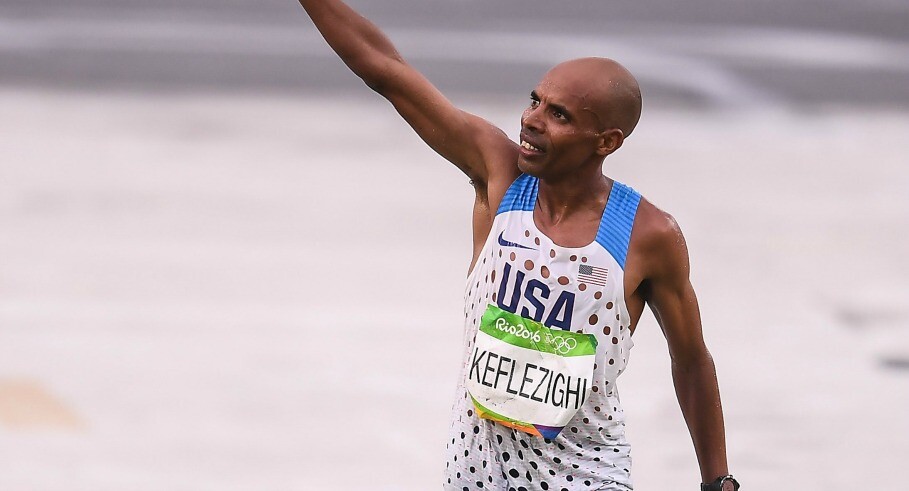
Meanwhile, two-time Bix 7 champion Meb Keflezighi added the men’s 45-49 age group championship to his resume on Saturday.
Keflezighi said he wasn’t really sure he was going to push himself in the race, but with the crowd cheering and urging him on, he couldn’t help himself. He covered the course in 41:37.
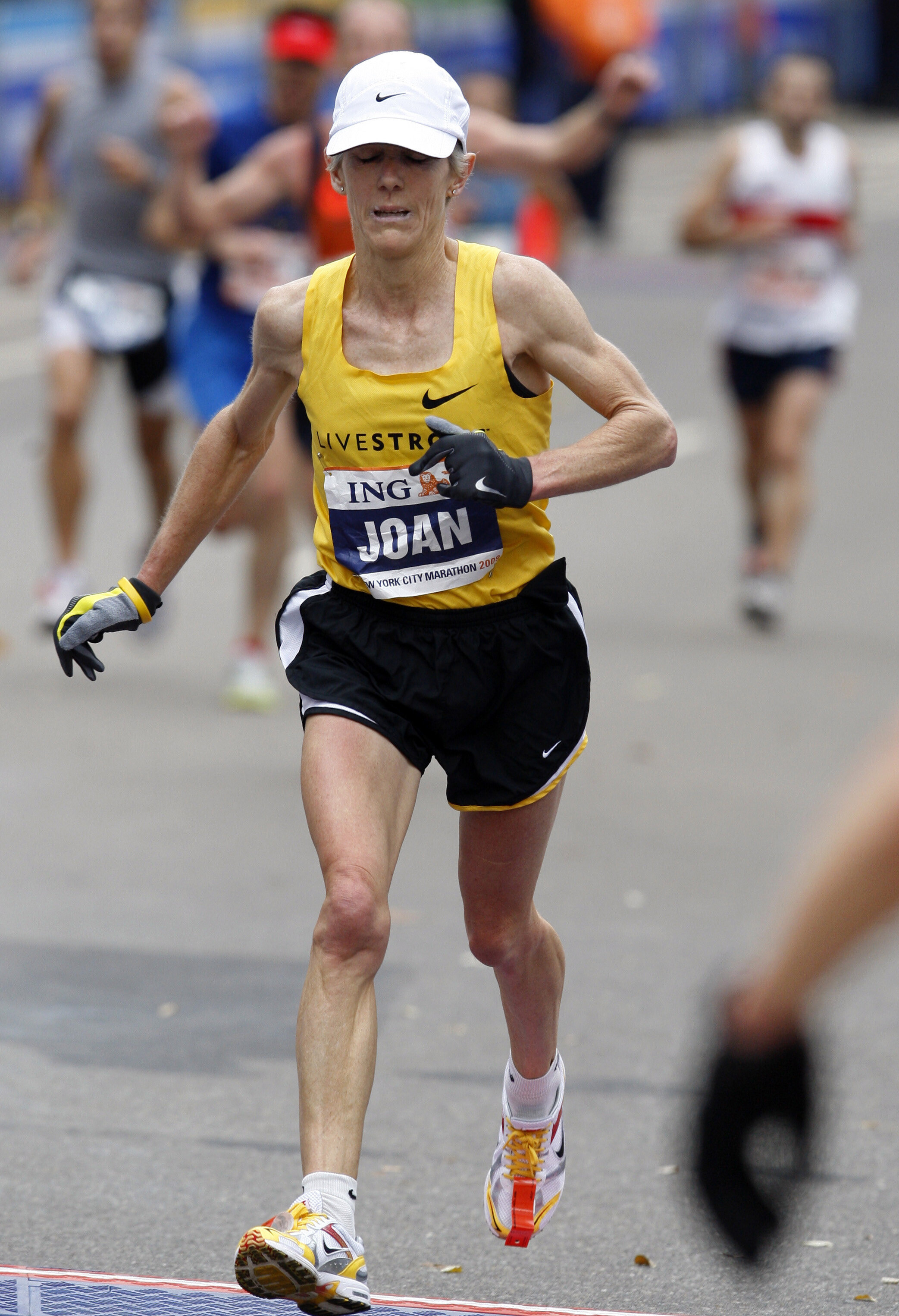
At one point, Keflezighi encountered a man who told him he’d had dreams of running the race with him.
“Then he took off, but I caught up with him and said ‘Let’s make your dreams come true,’’’ Keflezighi said.
Bill Rodgers, who won the Bix in 1980 and 1981 and has run it every year since, finished Saturday's run in a time of 1:19:46.
Two-time Olympic medalist Frank Shorter, who like Rodgers is 76, did the two-mile Quick Bix. But he said he still had a great time, marveling at how many times little kids breezed past him along the way.
At one point, a mother with a small daughter who Shorter estimated to be 5 or 6, came up alongside him. The mom told the girl to just go ahead and take off if she wanted. She’d see her at the finish line. The girl turned on the jets and took off.
“You could almost see the vapor trail,’’ Shorter joked.
Age-group records: Samuelson wasn’t the only person to set a course record for their age group.
It also was accomplished by Lucas Hollingshead of Elkhart, Ind., in the men’s 15-under division (37:41) and Richard Kutzner of Clear Lake, Iowa, in the men’s 80-84 (1:04:10).
And for the first time, the Bix 7 had 85-over divisions so the winners there obviously established records. The winners were Dave Zimmer of Long Grove, Iowa, and Norma Mullins of Moline.
Another Hird win: The first runner across the finish line in the Prairie Farms Quick Bix was a familiar face.
Zach Hird, a former Alleman High School runner who now lives in Naperville, Ill., won the Bix 7’s two-mile alternative in a time of 9 minutes, 48 seconds.
Hird won the Gregg Newell Trophy as the top local finisher in the seven-mile race in both 2018 and 2019.
The first female finisher in the Quick Bix on Saturday was Jennifer Douglass of Assumption, Ill.
Unbreakable Glass: Bryan Glass knows his Bix history well. Already a five-time master's champion, Glass put his name in the same breath as one of the Bix legends with a strong race Saturday.
At the age of 50, Glass finished the seven miles in 38 minutes, 21 seconds, becoming just the second runner 50 or older to run the race in under 40 minutes. The first? Bill Rodgers.
Glass was only 11 seconds off the 50+ record set by Rodgers — who ran 38:10 back in 1998.
"It was my goal for the last year, knowing that I could do it, I knew I could. Now, I ran faster than I ever thought I could do today, but I think it was just God giving me the ability to be prepared today, and I went for it."
Glass has a long history of running. He was a state champ at Geneseo and went to Southern Illinois University Edwardsville. He's also a member of the Springfield Road Runners Club Hall of Fame.
This is another accolade Glass has to be proud of.
"It's emotional because you work so hard for so many years," Glass said. "I never thought I'd get to the point where I'd have a chance to put my name up with Bill Rodgers. Now I know he's above anything I would ever beat, but to know that I'm in that same class in some sense in my home area, makes me so proud."
A rare Bix triple: Credit to recent Bettendorf High School graduate Maya Williams for giving it her all during the 50th QCT Bix 7 week. The standout sprinter pulled off a rare double on Thursday, running two races in the Brady Street Sprints — winning the open women's race and anchoring the Bulldogs' relay team to the high school girls' title.
Just for good measure, she figured she would jump into Saturday's 7-miler. Making that decision Friday evening didn't give her much recovery time. She posted a 1:18.21 clocking on Saturday.
RRCA honors: The Bix 7 served as the national championship race for the Road Runners Club of America on Saturday, which meant a little additional hardware for some runners.
In addition to men’s champion Wesley Kiptoo and women’s champion Raechel Chebet, Samuelson was honored as the women’s 60-over champion and Glass as the men’s 50-over champ.
Other honorees were Artur Mueller of Davenport, men 40-over; Jess Hruska of Dubuque, women 40-over; Kate Maurer of Urbandale, Iowa, women 50-over; and Rick Torres of Elizabethtown, Ky., men 60-64.
Weather vane: Saturday's weather for the race was nearly perfect. At race time, it was 68 degrees with a manageable 81% humidity. It was just the 18th time in 50 events that the race started with a temperature under 70 degrees.
Making her mark: Paityn Noe, last year’s Bix 7 high school girls’ top finisher, came back this year and had another solid race.
The University of Arkansas freshman from Huxley, Iowa (Ballard High School), was the seventh women’s finisher, clocking a time of 38 minutes, 34 seconds, just 2:13 behind winner Rachael Chebet.
In May, she finished second in the SEC Championships 10,000-meter run, clocking a 33:57.35. She also finished fifth last fall in the SEC cross country meet, running 19:43.7 for the 6,000-meter race.
Enjoy the day: Maggie Montoya, who was the third female overall finisher in Saturday’s Bix 7, enjoyed her first run through the streets of Davenport with 16,586 other people.
“When you’re surrounded by this mass of people, it brings you back to racing a marathon and being around people,” she said after finishing in 37:13. “It was nice to be back in that atmosphere.
“… There’s something about being surrounded by so many people that really adds to the event. It was fun being back out on the roads again.”
13-minute start: How long does it take for 16,587 to cross the starting line? The group of runners dressed as Elvis Presley, who almost always bring up the rear of the pack, finally got to the starting line when the race was 13 minutes old.
by TJ Johnson
Login to leave a comment
Bix 7 miler
This race attracts the greatest long distance runners in the world competing to win thousands of dollars in prize money. It is said to be the highest purse of any non-marathon race. Tremendous spectator support, entertainment and post party. Come and try to conquer this challenging course along with over 15,000 other participants, as you "Run With The Best." In...
more...Defending champions return to Bix
Kellyn Taylor and Biya Simbassa each ran the Quad-City Times Bix 7 for the first time last year.
They clearly loved the course, the atmosphere and just about everything about the annual race through the streets of Davenport.
Both Taylor and Simbassa held off late challenges from other runners, both ran the sixth best Bix 7 times ever by a U.S. athlete of their gender and both plan to return to defend their championships when the race is held for the 50th time on July 27.
It marks the first time in 12 years that both the men’s and women’s champions are returning to defend their Bix titles.
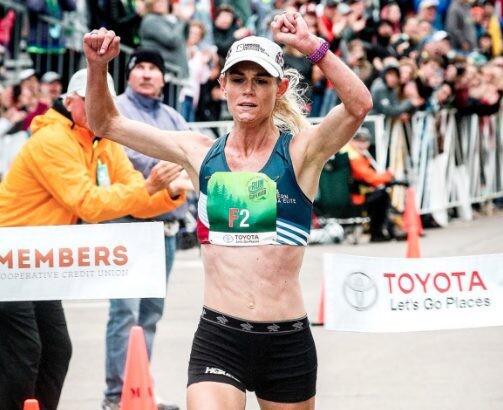
Simbassa admitted he wasn’t really sure how he felt about the Bix 7 course last year when he first saw the endless array of ups and downs in the course. But after holding off Olympian Clayton Young to win, he liked it.
“I mean, now I do,’’ he said after his victory. “It’s a course that’s all about strength and I train for this."
Taylor went through a similar transformation.
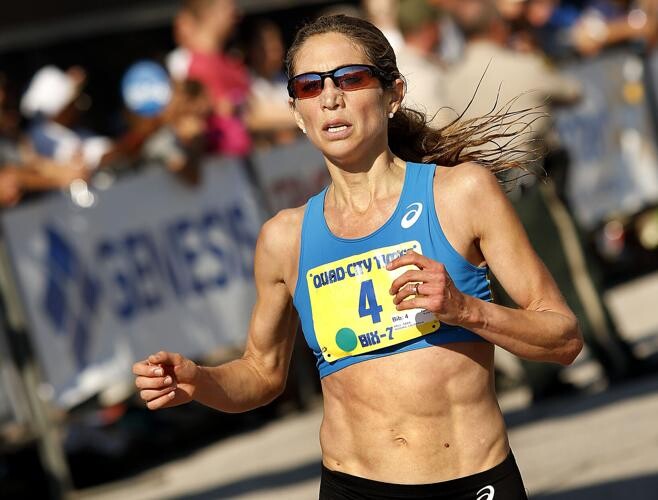
“When I saw the course, I was like, ‘Oh, no. What did I get myself into?’ ” she said. “That’s a super substantial hill right at the beginning and then it rolls all the way through. It’s certainly not easy by any means. I think that works to my favor since I’m more of a strength runner.”
Taylor appreciated more than just the hills.
“The crowds were amazing,” she said. “It’s not what I expected at all — the streets were completely lined, and a race that isn’t a huge marathon, I don’t feel like you see that that often. The crowds were incredible.”
Taylor and Simbassa will be bidding to repeat as Bix 7 champions, something that has been done only seven times in the race’s history, four times by men, three times by women.
Both runners failed to land berths on the U.S. Olympic team, which would have precluded a return to Bix, but they’ve still used their 2023 victories as a springboard to additional success.
Taylor briefly led the New York City Marathon last November before placing eighth, making her the top American finisher in the race. It was the third time she has been in the top eight at New York.
The Wisconsin native, who will turn 38 a few days before the Bix 7, then focused her attention on making the U.S. Olympic team and made a respectable showing in the trials in the marathon, finishing 15th, and the 10,000 meters, placing sixth.
Simbassa, a 31-year-old native of Ethiopia who now lives in Flagstaff, Arizona, attempted to earn an Olympic spot in the marathon but placed 11th in the trials.
However, he has followed that with an ambitious schedule on the U.S. road racing circuit, recording top-five finishes in the Bolder Boulder 10k (5th), Cherry Blossom 10-miler (5th), Gate River 15k (4th), Amway River Bank 25k (3rd) and Houston Half-marathon (4th).
Also included in the field are four former Olympians and nine other runners who have placed in the top 10 at the Bix 7 in the past. Elite athlete coordinator John Tope said even more top runners could be added between now and race day.
Among the top men’s entries are two former Iowa State University standouts.
Wesley Kiptoo of Kenya was the 2021 NCAA indoor 5,000-meter champion and a seven-time All-American for the Cyclones. He was seventh in the Bix 7 two years ago and won the Cherry Blossom 10-miler earlier this year.
Hillary Bor, a Kenya native who is now an American citizen, also attended Iowa State before representing the U.S. in the 3,000-meter steeplechase at the Olympics in both 2016 and 2021. He also is the U.S. record-holder in the 10-mile run.
Other former Olympians in the field are Morocco’s Mohamed El Aaraby and Americans Jake Riley and Shadrack Kipchirchir. Riley and Araby both competed in the marathon in Tokyo in 2021 and Kipchirchir ran the 10,000 meters in 2016.
Riley also is a Bix 7 veteran along with Kenya’s Reuben Mosip and Americans Frank Lara, Andrew Colley and Isai Rodriguez. Lara was second in the Bix 7 in 2021 and eighth a year ago.
Rounding out the men’s field are Raymond Magut of Kenya; Tsegay Tuemay and Tesfu Tewelde of Eritrea; and Americans Nathan Martin, Ryan Ford, JP Trojan, Merga Gemeda and Titus Winders.
The most recognizable name in the women’s field is 41-year-old Sara Hall, the wife of two-time Olympian, U.S. half-marathon record-holder and 2010 Bix champion Ryan Hall. Sara Hall was fifth in the U.S. Olympic marathon trials earlier this year and has two strong Bix 7 efforts on her resume, placing second in 2014 and third in 2017.
She and Taylor will be challenged by three up-and-coming runners from Kenya — Emmaculate Anyango Achol, Grace Loibach Nawowuna and Sarah Naibei. Achol has run the second fastest women’s 10k ever (28:57) and Naibei won the Lilac Bloomsday 12k in May.
Also in the field are Bix 7 veterans Kassie Parker, Jessa Hanson, Carrie Verdon and Tristin Van Ord along with Americans Annmarie Tuxbury and Stephanie Sherman, Ethiopia’s Mahlet Mulugeta and Kenya's Veronicah Wanjiru.
The elite field also includes four legendary runners who have helped build the Bix 7 into the international event that it is. Two-time champion Bill Rodgers, who has run the Bix 7 43 times, will be joined by four-time women’s champion and 1984 Olympic gold medalist Joan Samuelson, two-time Olympic medalist Frank Shorter and Meb Keflezighi, who has two Bix titles and an Olympic silver medal on his resume.
by Don Doxsie
Login to leave a comment
Bix 7 miler
This race attracts the greatest long distance runners in the world competing to win thousands of dollars in prize money. It is said to be the highest purse of any non-marathon race. Tremendous spectator support, entertainment and post party. Come and try to conquer this challenging course along with over 15,000 other participants, as you "Run With The Best." In...
more...U.S. Olympic Marathoners Will Race the Bolder Boulder 10K as a Pre-Paris Tune-Up
Conner Mantz, Clayton Young, and Leonard Korir will run in the International Pro Team Challenge on May 27.
Memorial Day is always an exceptional celebration for runners in Boulder, Colorado, but this year, it will have some extra special Olympic flair.
On Monday, May 27, more than 40,000 runners will run through the city that’s known for the iconic Flatirons rock formations, the Pearl Street pedestrian mall, and an exceptionally active population in the annual Bolder Boulder 10K. Now in its 44th year, it’s been one of the top road running races in the U.S. since its inception, and this year will serve as one of the final tune-ups for the men’s U.S. Olympic marathon squad before racing in the Paris Olympics later this summer.
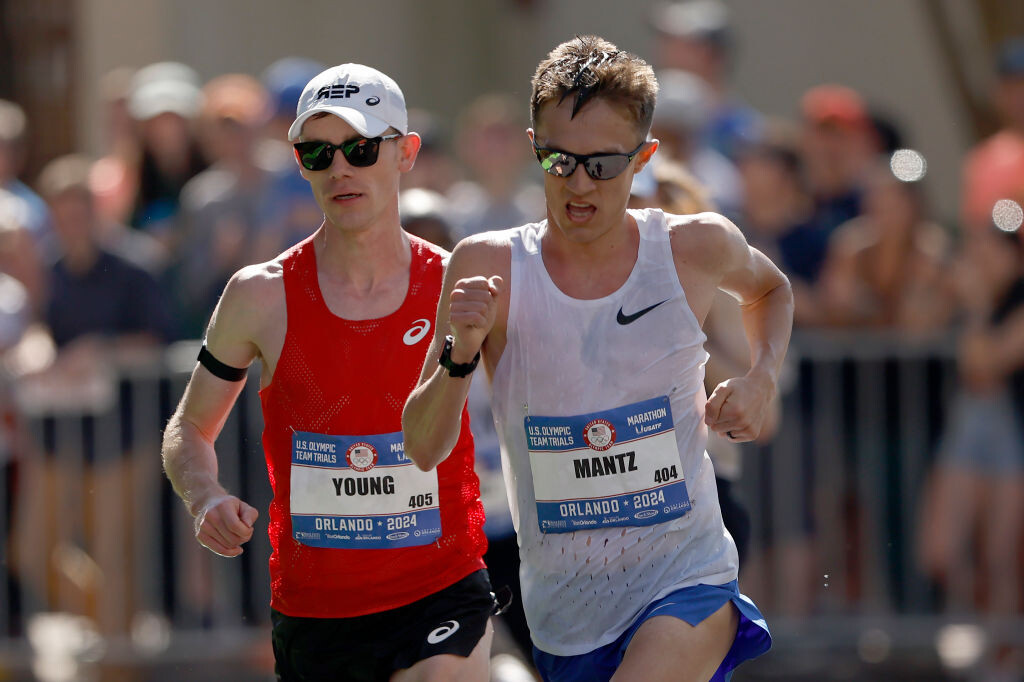
Conner Mantz, Clayton Young, and Leonard Korir, the top three finishers in the 2024 U.S. Olympic Trials who will be racing the marathon in the Paris Olympics on August 10, will be competing as Team USA Red in the Bolder Boulder’s International Pro Team Challenge that follows the citizen’s races. (Korir is expected to officially be named to the U.S. team in early May based on final pre-Olympic international rankings.)
The pro race, which has a prize purse of $83,700 before potential bonuses, is one of the things that makes the Bolder Boulder so unique. After all the runners in 98 citizen waves have completed the race, professional men’s and women’s international teams from more than a dozen countries compete on the same course for team and individual titles. The races feature a staggered start, with women beginning 15 minutes before the men so the winners of each race will finish about 10 minutes apart inside the University of Colorado’s Folsom Field football stadium.
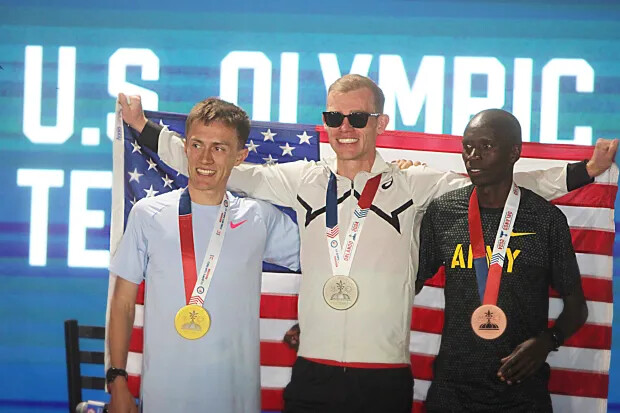
The finishing moments are among the thrilling spectacles in American running. By that point, the stadium is filled with a near-capacity crowd of roaring runners, family, and friends who have been watching the action play out on the massive video screens.
“The finish in the full stadium is like nothing else in the sport,” says Mantz, 27, who won the men’s race last year in 29:08 with a thrilling late-race surge to pass Kenya’s Alex Masai in the final 200 meters before the finish. “It was pretty electric. It took away all the pain you’re feeling mid-race. I was like, ‘Just race as hard as you can.’”
Team USA Red will have plenty of competition, from Team USA White, the secondary American team of Jared Ward, Futsum Zienasellassie, and Sam Chelanga, as well as teams from Kenya, Ethiopia, Mexico, and Rwanda. Teams are scored like a cross country race, with points awarded on the basis of finishing place, which means the team with the lowest combined score for all three runners is the winner. Ties are decided by the positions of the third-place finishers.
The women’s Team USA Red team will be led by defending champion Emily Durgin, along with Sara Hall and Boulder native Nell Rojas. Durgin finished ninth at the U.S. Olympic Trials in February and won the USATF 10 Mile Championships on April 7 in Washington D.C. At last year’s Bolder Boulder, she stormed to victory in 33:24, winning by 24 seconds over Kenya’s Daisy Kimeli.
Hall placed fifth in the U.S. Olympic Trials Marathon on February 3 in a U.S. master’s record (2:26:06) and 15th in the Boston Marathon on April 15. The women’s Team USA White roster will be composed of an all-University of Colorado alumnae squad—Makena Morley, Sara Vaughn, and Carrie Verdon.
“I can’t wait to be back in Boulder for the best day of the year,” says Durgin, 29, who will compete in the U.S. Olympic Trials 10,000 meters on the track in late June with the hopes of making the U.S. Olympic team. “Competing with Nell and Sara will make the experience even better.”
The women’s U.S. Olympic marathon team of Fionna O’Keefe, Emily Sisson, and Dakotah Lindwurm were invited to race in the Bolder Boulder but each runner declined, citing scheduling timing conflicts or a disinterest in racing at Boulder’s lofty altitude (5,430 feet). All of the runners who are racing for the U.S. teams in Boulder live at 4,500 feet or higher.
An Olympic Legacy
Boulder is known as one of the top running meccas in the U.S., in part because elite-level American and international runners have made it their training base since Olympic gold medalist Frank Shorter arrived in the early 1970s. Emma Coburn, Jenny Simpson, Yared Nuguse, Joe Klecker, Jake Riley, Hellen Obiri, and Edna Kiplagat are among the many top-level runners who are currently training in Boulder. Shorter, the 1972 marathon gold medalist, was a co-founder of Bolder Boulder 10K in 1979, and helped it grow into one of the country’s largest races.
Since then, numerous U.S. Olympians have raced in the Bolder Boulder, including Deena Kastor (a three-time women’s champion), Aliphine Tuliamuk (the 2022 women’s winner), Alan Culpepper, Elva Dyer, Ryan Hall, Abdi Abdirahman, Jorge Torres, Shalane Flanagan, Amy Cragg, Magdalena Boulet, and Libby Hickman, as well as Korir (who won it in 2022), and Ward (who was fourth in 2022).
Thanks to Boulder’s robust running community and the prestige of the race, the Bolder Boulder has also always featured fast sub-elite runners competing in the early citizen waves. Yet, the race has also celebrated dedicated middle-of-the-pack runners, as well as the first-time runners and walkers in the later waves. It was one of the first races to have bands playing along the course (as well as belly dancers and other entertainers), runners dressed up in costumes, elite wheelchair races, and in recent years, it has been known for a mid-race slip-and-slide and unofficial bacon aid station.
For the past 25 years, the Bolder Boulder has organized a special Memorial Day tribute—one of the largest in the country—that honors military veterans and new cadets.
The U.S. men’s Olympic marathon team competing in this year’s Bolder Boulder will be a legacy moment for the race, says Bolder Boulder race director Cliff Bosley.
“Having the three men that will represent our country in the marathon at this summer’s Paris Olympic Games is something we are extremely proud of,” Bosley says. “All three ran here last year, and to have them back is just incredible for the race, the city of Boulder, and the sport of running.”
by Brian Metzler
Login to leave a comment
Meet the 85-year-old man who’s run every OneAmerica 500 Festival Mini-Marathon
For most people, running just one marathon is a big achievement.
But for 85-year-old Eugene Lausch, running in his 48th mini-marathon Saturday will be just another accomplishment.
The retired lawyer has run more OneAmerica 500 Festival Mini Marathons than nearly everyone in the field. Of the approximate 200,000 runners, Lausch is one of only six who have participated every year since the marathon’s start in 1977.
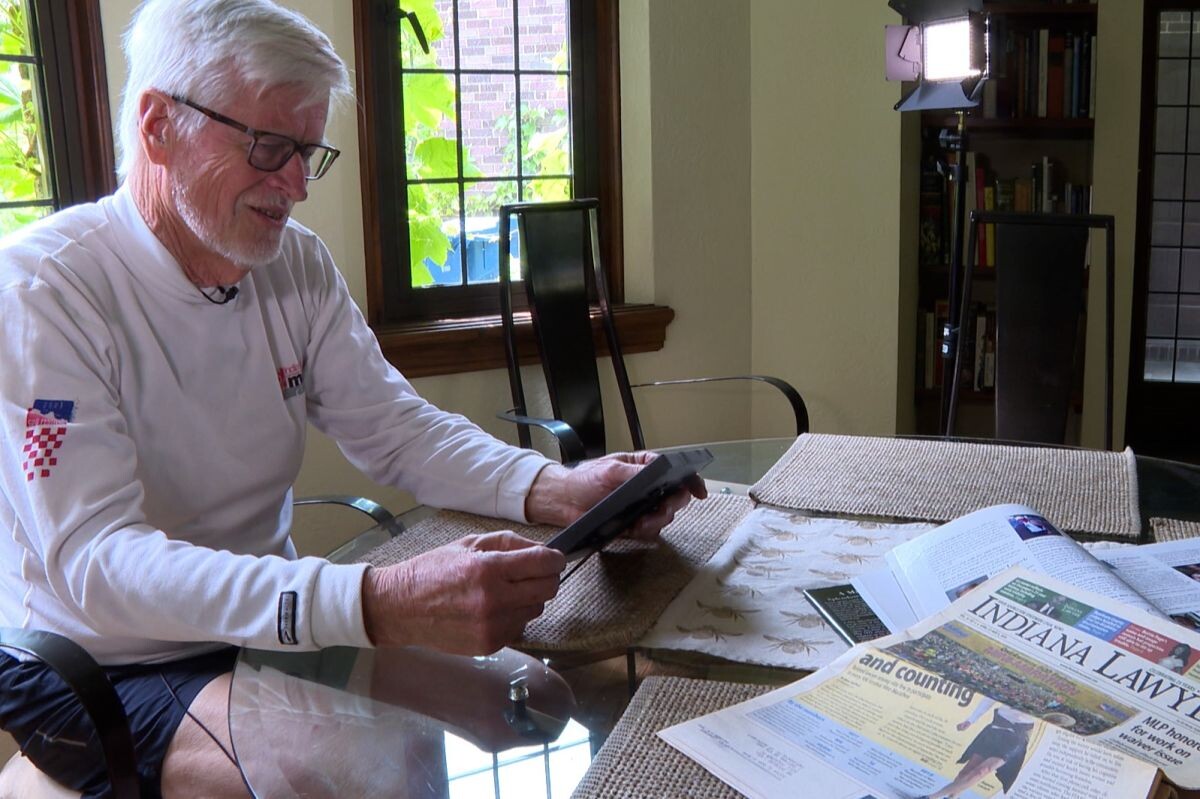
It’s a hobby that came to him almost by accident.
“I desperately wanted to be an athlete when I was a boy and, like every Hoosier lad, I wanted to be a basketball player, but I don't have good hand-eye coordination,” Lausch said.
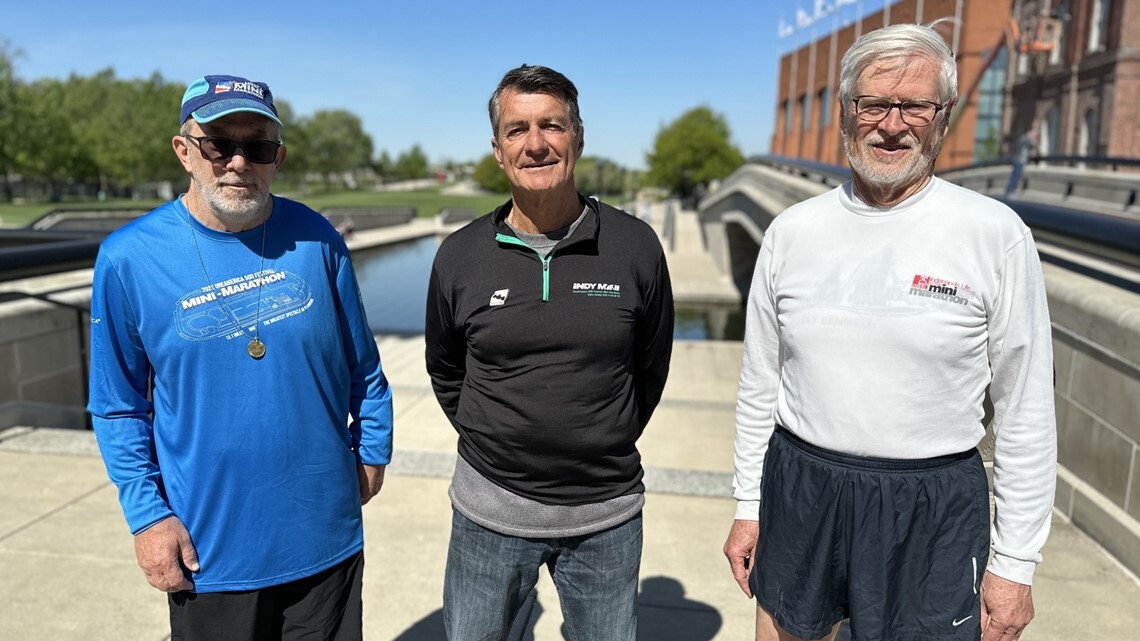
And since basketball requires a great deal of hand-eye coordination, he settled on running.
And, obviously, the hobby has stuck around.
As a student at Indiana Central University, now known as the University of Indianapolis, Lausch ran track. He went on to compete in the Indianapolis-Scarborough Peace Games and later coached track at the St. Richard Episcopal School in Indianapolis.
But his passion for marathons began in 1977, after being inspired by Olympian Frank Shorter. In the early seventies, Shorter became the first American runner in decades to win the Olympic marathon.
“That was an inspiration for a lot of people, including me,” Lausch said.
And 48 years later, he’s still going.
To keep fit, his regime is simple.
“I walk 23 miles a week,” he said. “Also, I do a considerable amount of outside activity and gardening that I think helps keep me fit.”
And even though Lausch is in better shape than most 85-year-olds, it hasn't always been easy.
In 2019, Laush was hit by a car while crossing the street.
“A car, which I never saw, knocked me down and broke my left hip,” Lausch said. “It was determined pretty quickly that my hip was fractured.”
The doctors told Lausch what he was already expecting, that he couldn't participate in the mini-marathon.
His ongoing streak would have been ruined if it were not for community members, including his granddaughter Claudia.
Several of the runners from St. Richard Episcopal School and Claudia pushed Lausch in a homemade cart for a portion of the mini-marathon that year.
“I must say that it's a bummer to have to be hit by a car and have your hip broken, but I was really buoyed up by the outpouring support,” Lausch said. “I think I really figured out what the Mini was all about.
“I don't think I really understood it before that it is less about winning. It's more about taking the assets you have and making the best of your circumstances.”
What was once a disaster turned into one of Lausch’s fondest memories associated with the marathon.
Lausch’s wife, Carolyn, and their two sons used to join him during the marathon. But now, Lausch runs by himself.
“I'm really happy about being able to continue to run, but I ended up not knowing very many people now who run the mini,” he said.
But even though he may not know everyone, people seem to know him. After his accident in 2019, several people came up to him to wish him well, he said.
“That was very heartening. I appreciated it a great deal,” Lausch said.
For now, Lausch will be walking the mini-marathon. He plans to continue to do it until he reaches 50 straight races in 2026.
by Grace Marocco
Login to leave a comment
OneAmerica 500 Festival Mini-Marathon
The mission of the 500 Festival is to produce life-enriching events and programs while celebrating the spirit and legacy of the Indianapolis 500 and fostering positive impact on the city of Indianapolis and state of Indiana. As an organization providing multiple events and programs, many of which are free to attend and impact over 500,000 people annually, our mission to...
more...When Will Eliud Kipchoge Slow Down?
What we can learn from the world’s greatest distance runner of all-time while he’s still in his prime
Eliud Kipchoge has expanded the universe of what’s humanly possible in the marathon, and he will forever remain a legend in the sport of long-distance running.
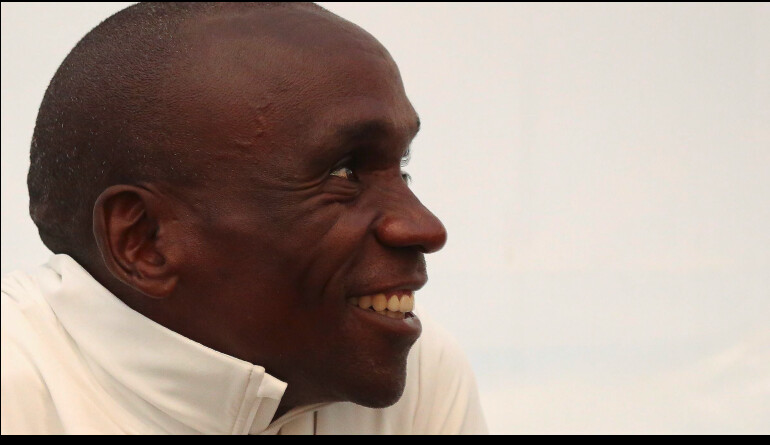
Not only for himself, but especially for those who have come after him. That includes everyone, both elite and recreational runners, who are preparing a marathon this fall or some distant point in the future. His current 2:01:09 world record and his barrier-breaking 1:59:40 time-trial effort in 2019 are legendary feats, both for the current generation of runners and for all time.
The 38-year-old Kenyan marathoner is a once-in-a-lifetime athlete, but time waits for no one, and especially not a long-distance runner. Like all elite athletes, his time at the top is limited, but fortunately, there is still time to immerse in the inspirational examples he’s providing.
Kipchoge recently announced he’ll return to the Berlin Marathon on September 24, where, last year, he won the race for the fourth time and lowered the world record for the second time. It is most likely what will be the beginning of a grand denouement as he goes for another gold medal at the 2024 Olympics next summer in Paris.
Given that he won his first global medal in the City of Light—when, at the age of 18, he outran Moroccan legend Hicham El Guerrouj and Ethiopian legend-in-the-making Kenenisa Bekele to win the 5,000-meter run at the 2003 world championships—it would certainly be one of the greatest stories ever told if he could win the Olympic marathon there next year when he’s nearly 40.
Certainly he’ll run a few more races after the Olympics—and maybe through the 2028 Olympics in Los Angeles—but, realistically, it is the start of a farewell tour for a runner who will never be forgotten.
Don’t get me wrong: I’m not at all writing Kipchoge off. In fact, I am excited to see him run in Berlin and can’t wait to watch next year’s Olympic marathon unfold. But just as we’ve watched Michael Jordan, Tiger Woods, Serena Williams, Shalane Flanagan, Usain Bolt, Allyson Felix, and other elite athletes succumb to the sunsetting of their peak performance level, so too will Kipchoge eventually suffer the same fate.
What I’m saying here is that we still have time to watch and appreciate Kipchoge eloquently working his magic and continue to be inspired in our own running and other pursuits in life. Remember how we marveled at Michael Jordan’s greatest in “The Last Dance” more than 20 years after his heyday? This is the start of the last dance for Kipchoge, who, like Jordan, is much, much more than a generational talent; he’s an all-time great whose legacy will transcend time.
Running has seen many extraordinary stars in the past 50 years who have become iconic figures— Frank Shorter, Joan Benoit Samuelson, Ted Corbitt, Carl Lewis, Steve Jones, Paul Tergat, Catherine Ndereba, Paula Radcliffe, Haile Gebrselassie, Kenenisa Bekele, Mary Keitany, Brigid Kosgei, and Kilian Jornet, to name a few—but none have come close to the body of work and global influence of Kipchoge.
Not only is Kipchoge one of the first African athletes to become a household name and truly command a global audience, but he’s done more than other running champions because of he’s been able to take advantage of this advanced age of digital media to deliberately push positive messages and inspiring content to anyone who is willing to receive it.
Kipchoge has won two Olympic gold medals, set two world records, and won 17 of the 19 marathons he entered, but he’s so much less about the stats and bling and more sharing—to runners and non-runners alike—that “no human is limited” and also that, despite our differences, we’re all human beings faced with a lot of the same challenges in life and, ultimately, hard work and kindness are what put us on the path to success.
How can an average runner who works a nine-to-five job and juggles dozens of other things in daily life be inspired by an elite aerobic machine like Kipchoge?
He is supremely talented, no doubt, but many elite runners have a similar aerobic capacity to allow them to compete on the world stage. What Kipchoge uniquely possesses—and why he’s become the greatest of all-time—is the awareness and ability to be relentless in his pursuit of excellence, and the presence and good will of how beneficial it is to share it.
If you haven’t been following Kipchoge or heard him speak at press conferences or sponsor events, he’s full of genuine wisdom and encouragement that can inspire you in your own running or challenging situation in life. His words come across much more powerfully than most other elite athletes or run-of-the-mill social media influencers, not only because he’s achieved at a higher level than anyone ever has, but because of his genuine interest in sharing the notion that it’s the simplest values—discipline, hard work, consistency, and selflessness—that make the difference in any endeavor.
This is not a suggestion to idolize Kipchoge, but instead to apply his wisdom and determination into the things that challenge you.
“If you want to break through, your mind should be able to control your body. Your mind should be a part of your fitness.”
“Only the disciplined ones in life are free. If you are undisciplined, you are a slave to your moods and your passions.”
“If you believe in something and put it in your mind and heart, it can be realized.”
“The best time to plant a tree was 25 years ago. The second-best time to plant a tree is today.”
Those are among the many simple messages that Kipchoge has lived by, but he also openly professess to giving himself grace to take time for mental and physical rest and recovery. It’s a simple recipe to follow, if you’re chasing your first or fastest marathon, or any tall task in life.
Kipchoge seems to defy age, but his sixth-place finish in the Boston Marathon in April proved he’s human. As much as it was painful to watch him falter, it was oddly refreshing and relatable to see him be something less than exceptional, and especially now that he’s tuning up for Berlin. He has nothing left to prove—to himself, to runners, to the world—but he’s bound to keep doing so just by following the same simple, undaunted regimen he always has.
There will be other young runners who will rise and run faster than Kipchoge and probably very soon. Fellow Kenyan Kelvin Kiptum—who has run 2:01:53 (Valencia) and 2:01:25 (London) in his first two marathons since December—seems to be next in line for Kipchoge’s throne of the world’s greatest runner. But even after that happens, Kipchoge’s name will go down in history alongside the likes of Paavo Nurmi, Abebe Bikila, Emil Zátopek, Grete Waitz, Shorter and Samuelson because of how he changed running and how he gave us a lens to view running without limits.
Berlin is definitely not the end of Kipchoge’s amazing career as the world’s greatest long-distance runner. I fully expect him to win again in an unfathomable time. But the sunset is imminent and, no matter if you are or have ever been an aspiring elite athlete at any level, a committed recreational runner, or just an occasional jogger trying to reap the fruits of consistent exercise, his example is still very tangible and something to behold.
by Outside Online
Login to leave a comment
How the Bolder Boulder 10K Became One of the World’s Most Cherished Road Races
5,000 runners are expected to run this year’s Memorial Day 10K on May 29
At bedtime last week, legendary American distance runner Melody Fairchild regaled her 7-year-old son Dakota with tales of the Bolder Boulder 10K he plans to run this year.
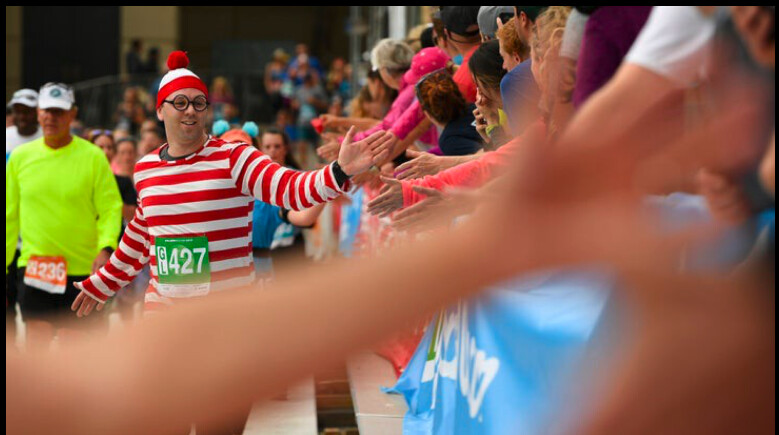
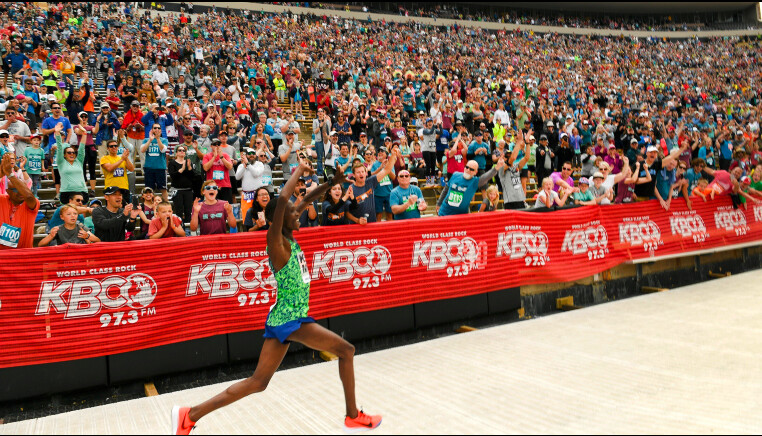
One of the biggest road races in the world for the past several decades, the race sends 40,000 runners through the streets of Boulder, Colorado, on a point-to-point race that ends at the University of Colorado (CU) football stadium, full of cheering spectators and fellow runners.
“I told him it’s an amazing feeling to run into that stadium,” Fairchild says. “When you hit the field, the whole crowd is cheering for everybody. You feel like they’re cheering for you. He had this huge smile on his face.”
And if 50,000 people cheering isn’t enough, there’s also the famous slip-n-slide, numerous bands playing on the course, runners and spectators wearing outrageous costumes, and the military jet flyover by the Colorado Air National Guard you can feel in your bones. Named America’s All-Time Best 10K, it’s likely to be one of the biggest parties you’ll ever attend.
Fairchild recounted for Dakota her experience as the U.S. captain for the Bolder Boulder’s first International Team Challenge professional race in 1998.
“I remember looking out the window and seeing the stadium full. I was so nervous, I thought I was gonna vomit all over the floor,” she says. “When I walked out and they introduced me as the local hometown girl, the whole crowd roared.”
Fairchild ran her first Bolder Boulder at age eight. She went on to win the citizens’ race three times (1989, 1990, 1991) when she was a record-setting high schooler, became an All-American and NCAA champion at the University of Oregon, and then qualified for the U.S. Olympic Trials in the 10,000-meter run and marathon as a professional runner. But the Bolder Boulder has always held a special place in her heart, which is why she has continued to run it through the years and why she’s so eager to introduce Dakota to it.
The idea for the Bolder Boulder germinated in the mind of a father watching his five children participate in all-day track meets. It was the summer of 1978 at the upswing of the original American running boom, and runner and local businessman Steve Bosley had grown frustrated with the disorganized events and parents berating their children for not running fast enough.
Bosley, then 37, reached out to his friend, Boulder resident and international running icon Frank Shorter, a two-time Olympic medalist in the marathon, for help designing a race that would serve their community and promote the sport of running. The race would not only become a Colorado icon, it set a gold standard for road races around the world and helped elevate women’s running in unprecedented ways.
During the spring of 1979, Cliff Bosley, the current race director, went door to door with his Boy Scout troop, passing out posters to encourage neighbors to run his dad’s inaugural race. The poster announced a 4,000-participant cap and enticed Boulderites to “Run with Frank Shorter and Ric Rojas!” for a mere $6.50 entry fee. (Rojas was another local elite athlete who would go on to win the inaugural race in 1979. His daughter, Nell Rojas, a current professional runner, won the women’s citizen’s race 40 years later in 2019.)
Bosley recalls giving a man in his front yard a poster who threw it back in his face in disbelief. “‘Yeah right, 4,000!’ the man scoffed. “I was just a 12-year-old kid. You believe everything your parents tell you. I thought, ‘Dad says it could happen—why won’t it?!’”
The inaugural race saw 2,700 registrations. The next year, it doubled in size and live entertainment was added to the celebration. Participation continued to soar in the ensuing years and decades, eventually reaching 50,421 in 2010. With an average of 45,000 finishers over the past 10 years, it’s now the seventh-largest road race in the nation and the largest Memorial Day celebration in the U.S.
From its inception, the Bolder Boulder 10K offered equal prize money for the female and male winners. In 1984, it created a separate elite race from the citizens’ race. There was also a deliberate split in the women’s and men’s elite race so that both races could be showcased equally and covered live on the local TV broadcast. Today, it offers one of the largest non-marathon prize purses in the U.S., but this did not come without a lot of work.
Initially road races were precluded from paying prize money to athletes because it changed their amateur athlete status, preventing them from competing in the Olympics. In the early 1980s, Steve Bosley, then the president of the Bank of Boulder, worked with two local attorneys, Frank Shorter, and TAC (The Athletics Congress which was then the name of the national governing body for the sport; now it’s known as USATF), to create a mechanism using trust accounts for athletes to earn prize money. It was then paid into athletes’ individual trust accounts so they could draw living and training expenses. At the time these accounts were called TACTRUST Accounts, and the Bank of Boulder was the steward of 95 percent of all of these accounts on behalf of both American and international athletes from around the world.
One of the most circulated photos of the Bolder Boulder 10K is that of Shorter, the 1972 Olympic marathon champion, winning the 1981 race— the first time the race finished in the University of Colorado’s Folsom Stadium. But that same year, Ellen Hart, then 23, won the women’s race—although she says there was no finish line tape for the female winner.
“It was the most exciting thing I had ever seen,” she recalls. “Since I was a little girl, I had wanted to go to the Olympics. I thought, Oh my god. This is like the Olympics! I traveled to races all over the world and the BB was my favorite race.”
Hart would move to Boulder in 1982, and then win the race again in 1983 before the four-year reign of Portugal Olympian Rosa Mota. In many ways, Hart says, her success in the Bolder Boulder launched her career as a professional athlete.
She went on to place 11th at the inaugural women’s U.S. Olympic Trials Marathon in 1984, set an American record in the 30K, and won 18 world championship titles in triathlon and duathlon racing. “In terms of women’s sports, the Bolder Boulder was certainly more forward-thinking than any other race I ever attended,” Hart says.
The race organization was also ahead of its time when it began the Women’s High Altitude Training Camp, something it did not offer for men, in 1989. The 100-day program was designed to bring five talented post-collegiate female runners to Boulder to train prior to racing Bolder Boulder. Runners were placed in volunteer host families, provided an elite coordinator and a trail guide, and given access to a local gym and the university’s track to train.
New Jersey runner Inge Schuurmans McClory was a member of the 1990 team.
“I really didn’t feel worthy of national attention, but I applied for the program not even thinking I was going to get in,” she says. She was not only accepted, but she fell in love with Boulder and stayed.
“I went to graduate school here. I met my husband here. I coached cross country and track at CU. It sort of was the launching pad for the rest of my life, and I owe it to the Bolder Boulder and that high-altitude training camp,” says McClory, now a physician’s assistant who has trained cardiac patients—the Brave Hearts—for the Bolder Boulder since 2000.
Since 1996, there have consistently been more women (average 53-54 percent) than men completing the race. Cliff Bosley attributes this to his mom creating a walking division in 1984 so that her father, diagnosed with prostate cancer, could participate.
“We kind of look at it as a placeholder,” says Bosley, “You come in as a walker and now you’re on the continuum. Let’s help you become a jogger. Let’s help you become a racer.” This exemplifies the Bolder Boulder’s rallying cry, “Oh Yes You Can!” that it established in 1979.
The Bolder Boulder has always been defined by its strong community involvement, which includes an eager network of volunteers, aid stations staffed by local running groups, and the thousands of spectators who line the streets and fill the stadium. Historically, the race donates more than $100,000 to local nonprofits and community groups that volunteer. Even during the pandemic, the race still found a way to contribute.
“Knowing we could not stage the Bolder Boulder in-person, we created a virtual event called the VirtuALL 10K and offered it at no cost,” Bosley says. Thousands of T-shirts, designed for the 2020 race that went unused, were donated to shelters.
Another Bolder Boulder program that supports the community is the BB Racers Club. Created in 1996, the program prepares children for the race, so their experience is a positive one. Initially started as a middle school program, this club now includes elementary schools. Children who are signed up are given a special training program, coach, and starting wave. Fairchild’s Boulder Mountain Warriors club, of which her son Dakota is a participant, is training a large number of BB Racers this year.
Bosley is prepared for up to 45,000 participants at this year’s race on May 29. And just as they did 44 years ago, race organizers will serve participants a sack lunch and send them a postcard in the mail with their finishing place, pace, time, and ranking in their age group.
“I can still remember checking the mailbox every single day until it came,” says Fairchild. “It makes me emotional just thinking about how much attention to detail they’ve always given hundreds of thousands of people. They care so much. It’s not an accident that they are the best 10K in the world.”
by Outside
Login to leave a comment
Kenyans Philimon Kipchumba and Agnes Keino break Munich Marathon course records
Both course records were smashed during the comeback of international elite runners at the Generali Munich Marathon.
Kenyan debutant Philimon Kipchumba crossed the finish line in Munich’s Olympic Stadium in 2:07:28. Behind him the 23 year-old Mengistu Zelalem of Ethiopia and Eritrea’s Berhane Tesfaye followed in 2:07:56 and 2:08:10 respectively – times that were well faster than the previous course record of 2:09:46. Fourth placed German Sebastian Hendel ran a fine debut with 2:10:37.
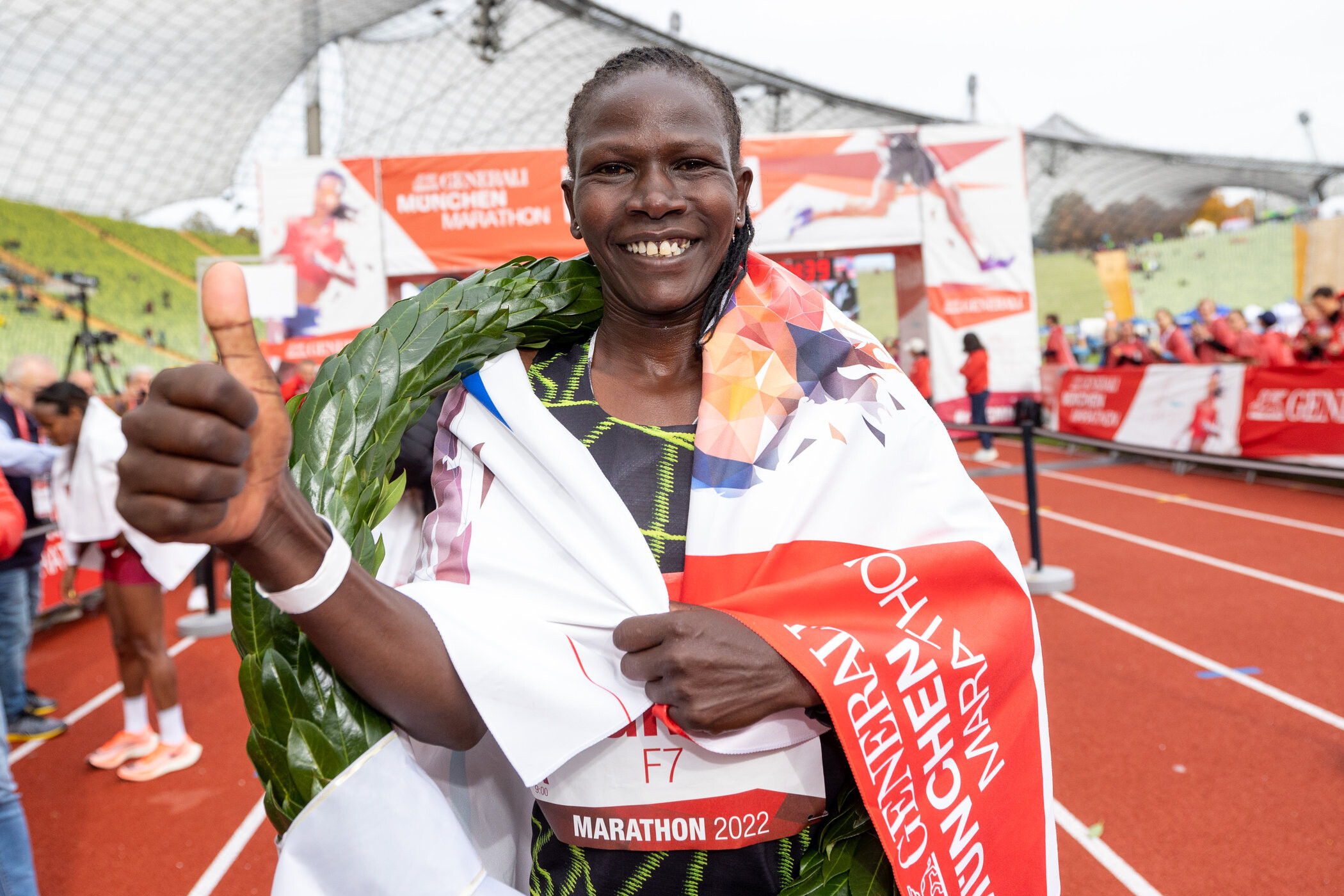
There was a triumph for Kenya in the women’s race as well: Agnes Keino clocked a personal best of 2:23:26, improving the course record by almost nine minutes. The 34 year-old was ahead of the 2015 marathon World Champion Mare Dibaba. The Ethiopian ran 2:24:12 while Souad Kambouchia of Morocco finished third with 2:27:35. Seven women were inside the former course record of 2:32:11.
A total of 18,322 athletes entered the 36th edition of the Generali Munich Marathon, which is a World Athletics Elite Label Road Race. 4,334 of them were marathon runners. The marathon was started by Frank Shorter, who won the Olympic marathon in Munich in 1972. The American had been invited as a guest of honor by the organizers.
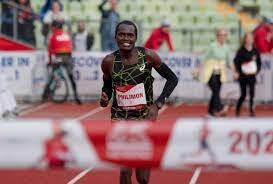
“This was a very special day for the Generali Munich Marathon. We are extremely happy with the great course records. We have reached new dimensions today and we intend to build on this success,“ said Race Director Gernot Weigl. It was the first time in over 20 years that organizers brought back a proper elite field. That was the reason why the long standing course records were smashed by several minutes on Sunday: Kenya’s Michael Kite was the former record holder with a time of 2:09:46 from 2000. Germany’s Susanne Hahn held the women’s mark with 2:32:11 from 2012 when she won the German Championships’ race.
In ideal weather conditions with temperatures of 9 Celsius at the start, hardly any wind and a cloudy sky a leading group of ten runners reached the half marathon mark in 63:41. However Tsegaye Mekonnen was no longer among them. The Ethiopian, who still holds the unofficial world junior record of 2:04:32 and was the fastest runner on the start list, had lost contact shortly before and later dropped out. But a compact group remained together in the lead until the late stages of the race. Five of them passed the 35k mark in 1:45:33. Once pacemaker Bonface Kiplimo of Kenya dropped out shortly afterwards a duel between Philimon Kipchumba and Mengistu Zelalem developed. The Kenyan was then able to put in a surge just before the 41st kilometer and dropped Zelalem. “I did not quite expect to run such a fast debut. But my training went very well and I just tried my best,“ said Philimon Kipchumba, who hopes to achieve times of 2:04 in the future.
In the women’s race Agnes Keino and Mare Dibaba were together in the lead, passing the half marathon point in 71:46 and then 30k in 1:42:01. With around eight kilometers to go Keino, who entered the race with a PB of 2:25:08, went ahead. Former world champion Dibaba, who was the fastest on the start list with her PB of 2:19:52, suffered of muscle problems and was not able to respond to the surge of her Kenyan rival. However Mare Dibaba finished second with 2:24:12, running her fastest time since 2019. “It was my big goal to run a personal best and I am really happy that I achieved it. Even more so since I also won the race,“ said Agnes Keino, who improved to 2:23:26.
by AIMS
Login to leave a comment
Generali Munich Marathon
The GENERALI MUNICH MARATHON has held the elite label of the WORLD ATHLETICS since 2020 and the marathon route is officially measured and recognized. The route runs from the Olympic Park and Schwabing to Leopoldstraße with the Siegestor, via Königsplatz and the Pinakotheken to the English Garden. From there past the Chinese Tower and Art Nouveau villas in Bogenhausen, through...
more...Generali Munich Marathon on Sunday is featuring the strongest field ever in its 36 year history
With the strongest field in its history the GENERALI MUNICH MARATHON will take place on Sunday. The unofficial world junior record holder Tsegaye Mekonnen and fellow Ethiopian Mare Dibaba, who was the marathon World Champion in 2015, head the start lists. Their personal bests of 2:04:32 and 2:19:52 respectively make them the fastest runners ever entered in the traditional Bavarian race.
For the first time in over 20 years an international elite field was assembled for the 36th edition of the GENERALI MUNICH MARATHON. Organisers hope that both course records will fall on Sunday.
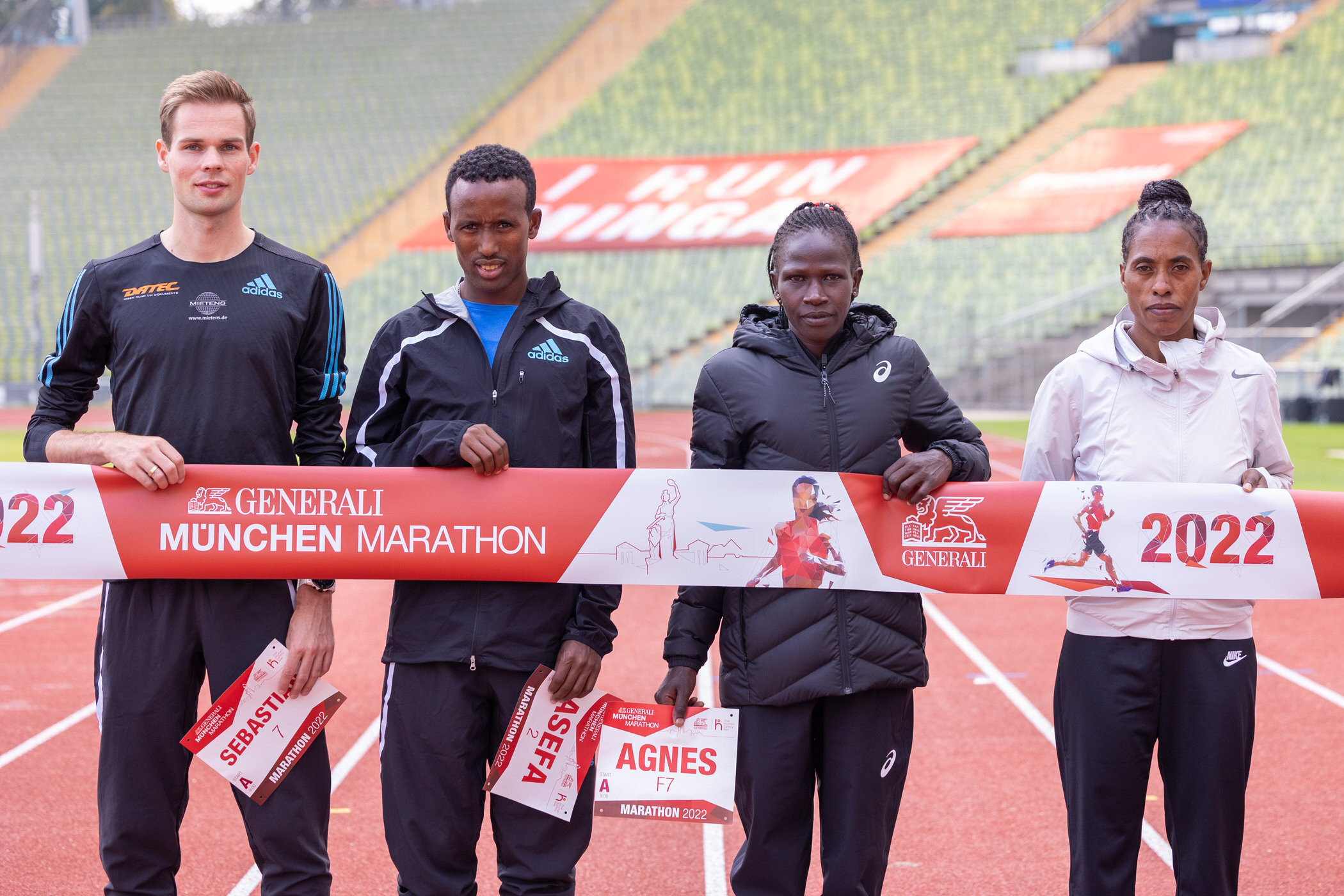
A total of around 18,500 runners are expected total part. About 5,000 of them will run the classic distance which starts and finishes inside the Olympic Stadium. The GENERALI MUNICH MARATHON is an Elite Label Road Race of the international athletics federation, World Athletics. The race will start at 9.00 am on Sunday and a live stream is available at: www.generalimuenchenmarathon.de
50 years after winning the Olympia marathon gold medal in Munich Frank Shorter is back in the city as a guest of honor. “I am very happy to have the opportunity to be back in Munich - the city where I was born in 1947 and where I celebrated my biggest career win in 1972,“ said 74 year-old Frank Shorter.
“We are looking forward to the strongest elite line-up in our history. With the former World Champion Mare Dibaba and the runner who holds the unofficial world junior record, Tsegaye Mekonnen, we managed to get two big names to Munich for the return of the elite fields. Since weather predictions are favourable we hope that both course records will be broken on Sunday,“ said Race Director Gernot Weigl.
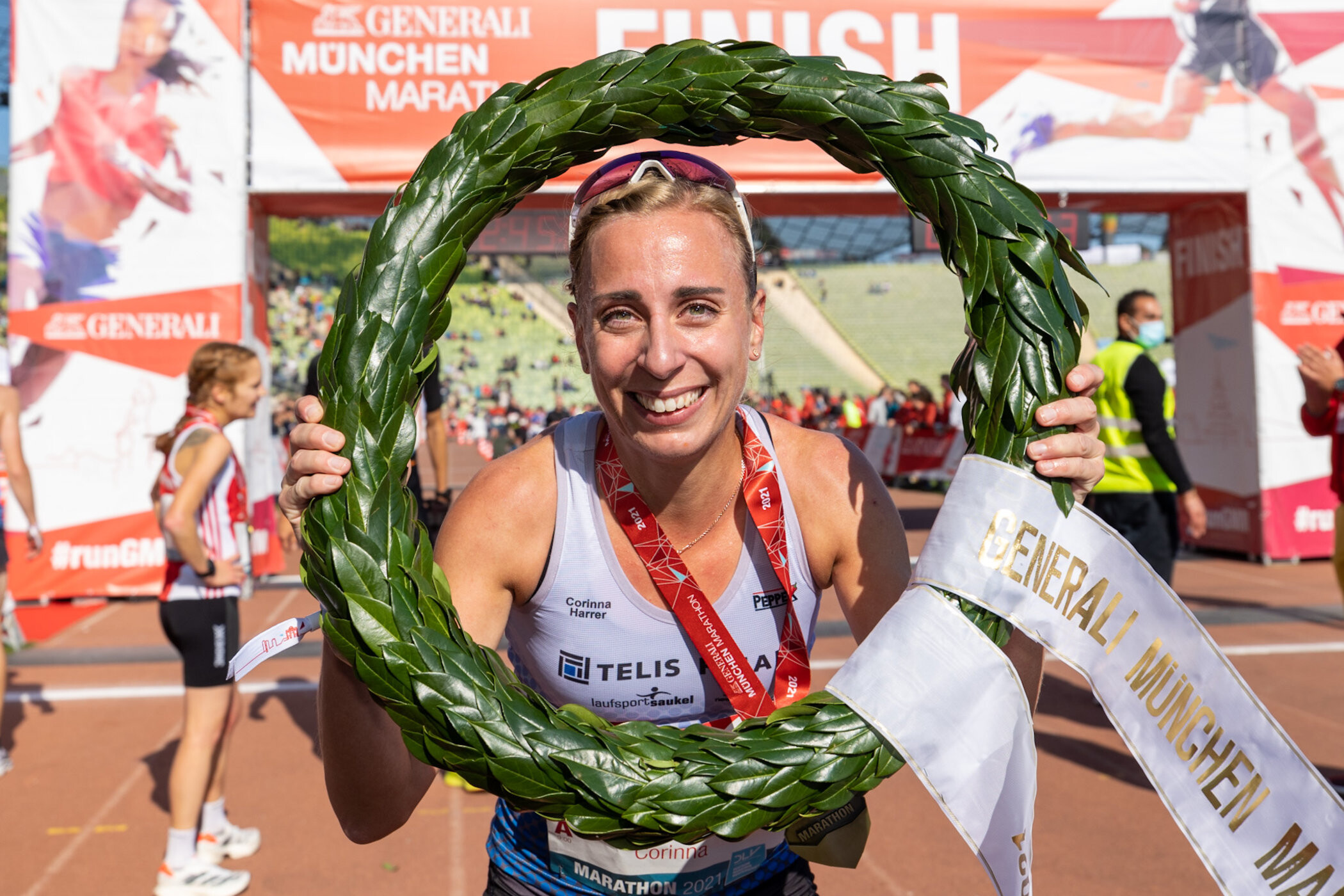
Tsegaye Mekonnen caused a major upset when he took the Dubai Marathon in 2014 aged just 19 years old. His time of 2:04:32 still stands as the unofficial world junior record (World Athletics does not ratify junior records in the marathon). In 2017 Mekonnen also won the Hamburg Marathon. Now 27 years old the Ethiopian has not competed over the classic distance since 2018 and now intends to come back with a strong performance in Munich. “I had injury problems and then the pandemic played its part as well, so I did not run a marathon for three years. Now my training has gone well and I intend to run a 2:06 on Sunday,“ said Tsegaye Mekonnen.
Two other runners are on the start list with personal bests of sub 2:10 and below the 2:09:46 course record: Ethiopia’s Mengistu Zelalem has a PB of 2:08:48 while Kenya’s Edwin Kimaiyo is in a similar range with 2:09:12. Current a half marathon split time of around 64:00 is targeted for the first group.
A big improvement of the course record seems possible for the women in Munich. Germany’s Susanne Hahn established the current mark of 2:32:11 ten years ago. Mara Dibaba heads the women’s field with a world-class personal best of 2:19:52. Besides the World Champion of 2015 and Olympic bronze medallist from 2016 there are two fellow-Ethiopians who have run under 2:25: Atsede Bayisa has a fine personal best of 2:22:03 and Aberu Zennebe has a PB of 2:24:30. “I have prepared for three months and my goal is to run a personal best“, said Aberu Zennebe. A winning time of sub 2:25might well be within reach on Sunday since it is planned that the first group reaches the half way mark in around 71:30. There are eight athletes on the start list who have run under 2:30.
Elite runners with personal bests:
Men:
Tsegaye Mekonnen ETH 2:04:32Mengistu Zelalem ETH 2:08:48 Edwin Kimaiyo KEN 2:09:12 Meshack Koech KEN 2:10:17 Emmanuel Sikuku KEN 2:11:05 Ngonidzashe Ncube ZIM 2:11:46 Justus Kangogo KEN 2:13:34 Berhane Tesfay ERI 2:14:42 Vincent Kiprotich KEN Debüt Philimon Kipchumba KEN Debüt Rodgers Keror KEN Debüt Sebastian Hendel GER Debüt
Women:
Mare Dibaba ETH 2:19:52 Atsede Bayisa ETH 2:22:03 Aberu Zennebe ETH 2:24:30 Agnes Keino KEN 2:25:08 Viola Yator KEN 2:26:51 Mercy Kwambai KEN 2:27:32 Souad Kambouchia MAR 2:27:49 Helen Jepkurgat KEN 2:29:10 Caroline Nahimana BUR 2:30:09
Second photo:showing German debutant Sebastian Hendel with Tsegaye Mekonnen, Agnes Keino und Aberu Zennebe
Login to leave a comment
Generali Munich Marathon
The GENERALI MUNICH MARATHON has held the elite label of the WORLD ATHLETICS since 2020 and the marathon route is officially measured and recognized. The route runs from the Olympic Park and Schwabing to Leopoldstraße with the Siegestor, via Königsplatz and the Pinakotheken to the English Garden. From there past the Chinese Tower and Art Nouveau villas in Bogenhausen, through...
more...Ben Flanagan wins his third Falmouth Road Race
Kitchener, Ont. native Ben Flanagan has done it again, winning his third Falmouth Road Race in four years. Flanagan finished the seven-mile (11.3 km) course in 32:25, outlasting runner-up Biya Simbassa (32:32) for a second straight year in Falmouth, Mass.
With two Falmouth victories to Flanagan’s name, and his partner, Hannah, growing up in Falmouth, he was the race favourite heading in and was keen to defend his 2021 title. In a pre-race interview, Flanagan chatted about his familiarity with the course and how he was already dreaming of his celebration when he won his third.
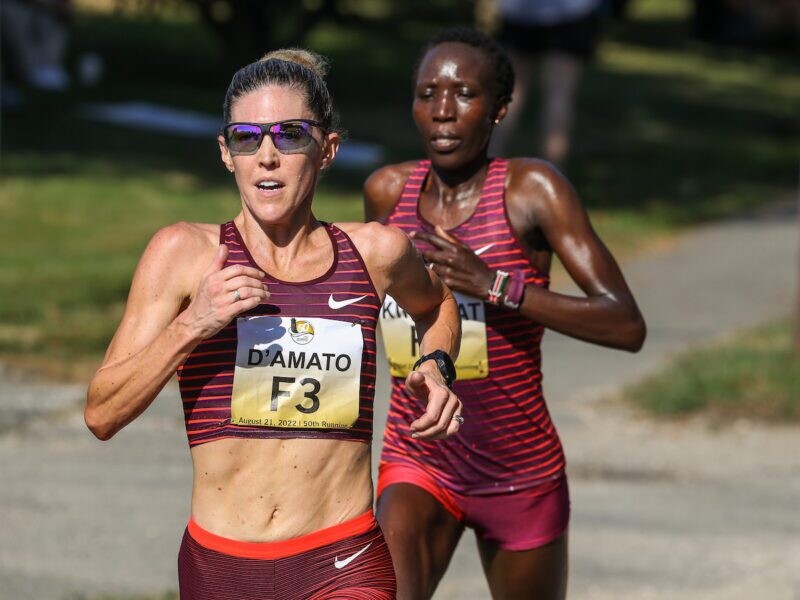
Like in previous years, the 27-year-old broke the tape by jumping into it, holding up the “number three” with his hand.
Flanagan again made his attack at the top of the Scranton Ave. hill at the 5.5-mile marker. Simbassa, who lives and trains in Flagstaff, Ariz., followed Flanagan’s move along with David Bett of Kenya. The Canadian 10K record holder ousted Bett and Simbassa on the final downhill to win, nine seconds shy of his personal best on the course: 32:16 from 2021.
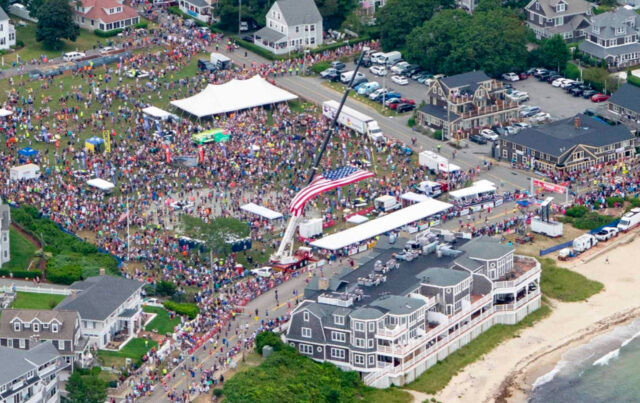
Flanagan now joins an exclusive group of six runners to successfully defended their titles at Falmouth. The group of six features: Alberto Salazar (‘81 and ‘82), Frank Shorter (’75 and ’76), and David Murphy (‘84 and ‘85). Next year, he will have the chance to join Kenya’s Gilbert Okari as the only men to win three straight (2004-06)
The American women’s marathon record holder, Keira D’Amato, won the women’s 11.3 km race in a nail-biting finish (36:14). She managed to hold off a surging 2017 Boston Marathon champion Edna Kiplagat (36:28) to claim the women’s title in her Falmouth debut.
This race was a quick bounce back for the 37-year-old, who placed eighth at last month’s 2022 World Athletics Championships marathon for Team USA in 2:23:34. Earlier this year at the Houston Marathon, D’Amato set the U.S. marathon record of 2:19:12.
D’Amato will take another stab at breaking her American marathon record on Sept, 25. at the Berlin Marathon.
Daniel Romanchuk won the men’s wheelchair title in 22:02, and Susannah Scaroni won the women’s division in 25:30.
by Marley Dickinson
Login to leave a comment
Falmouth Road Race
The Falmouth Road Race was established in 1973 and has become one of the premier running events of the summer season. Each year the race draws an international field of Olympians, elite runners and recreational runners out to enjoy the scenic 7-mile seaside course. The non-profit Falmouth Road Race organization is dedicated to promoting health and fitness for all in...
more...Remembering the USA Olympic Trials 10000m 50 years back
50 YEARS AGO the temps hovered near 95 degrees at the start of the 1972 Olympic Trials 10,000 meters.
That's pretty dang hot for a twenty-five lap race...but nowhere near as toasty as the pace that Frank set. His scintillating 4:25.4 first mile was nearly world record pace.
One by one, those that had tried to hang with Shorter got dropped like a bad habit beginning about 2 miles (reached in 8:58.5 by the former Yalie).
Meanwhile Florida Track Club teammates Jeff Galloway and Jack Bacheler, running their own steady-eddy tempo in arrears, began gobbling up the roadkill.
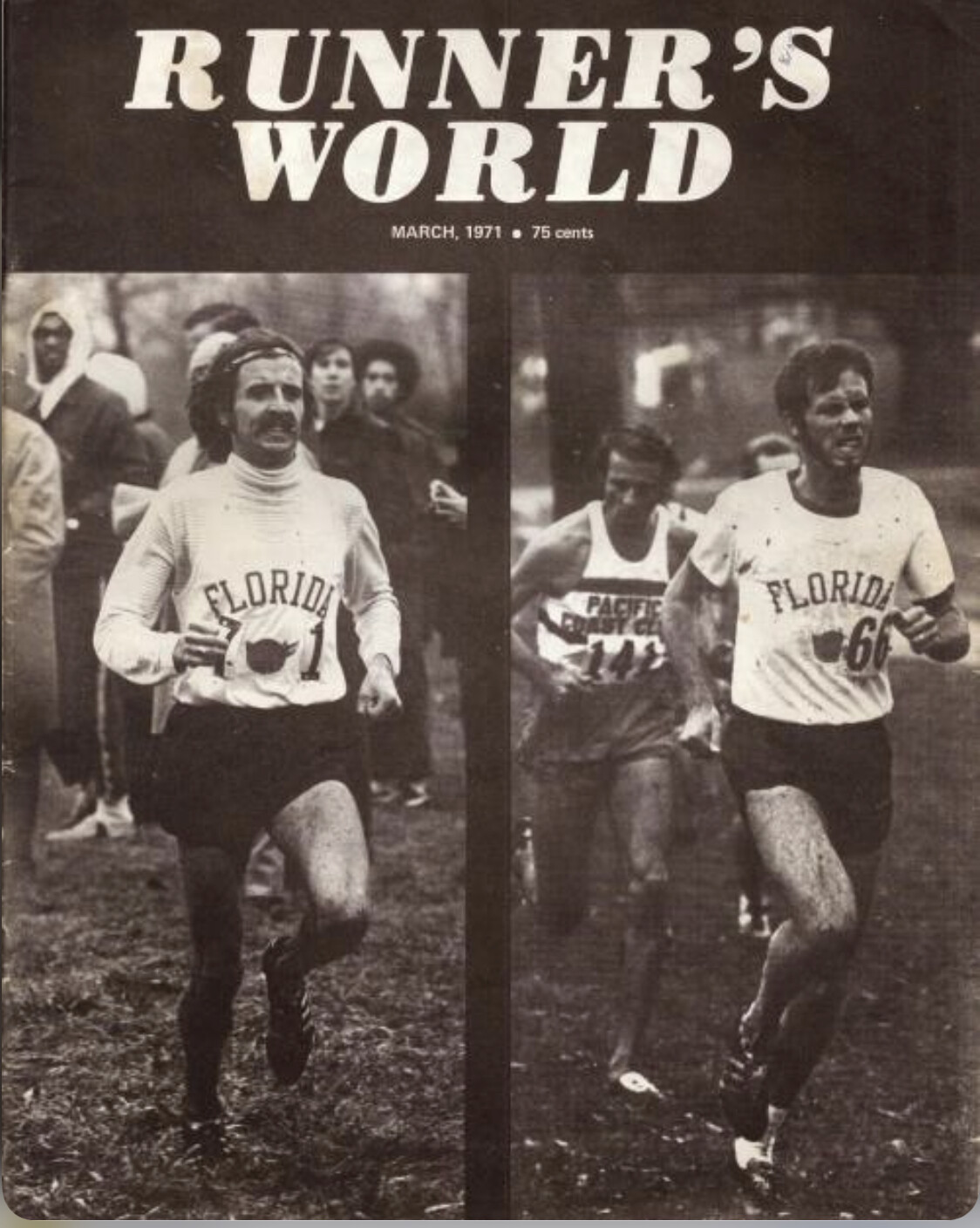
The last to fall off was homeboy Jon Anderson wearing the signature yellow and green striped Oregon TC kit (he had graduated from Eugene's Sheldon High School and at the time of these Trials, his Pop was the Mayor of TrackTown).
Anderson fell back as far as 6th place, some 60 yards out of third, while grabbing his sides as though he was battling a side stitch.
Then all of a sudden with a couple of laps to go, and much to the delight of the partisan crowd, Jon channeled his inner Lazarus, showing new signs of life.
While Frank and Jeff were just too far ahead to be 'catchable', Anderson's late charge reeled in Jack. The pair of lanky distance runners bumped shoulders coming out of the final turn. It was a collision caused by fatigue, not aggression, and drew Bacheler a disapointing DQ, while Jon sped across the finish line, up by 6/10 of a tick.
1 Frank Shorter 28.35.6
2 Jeff Galloway 28.48.8
3 Jon Anderson 29.08.2
4 Tom Laris 29.43.0
5 Bill Clark 29.57.0
6 Don Kardong 30.21.2
7 Gregory Fredericks 30.37.6
8 Dave Antognoli 30.39.6
DQ Jack Bacheler 29:08.9
SIDEBAR: Seven days later in the marathon race, Shorter and Kenny Moore would tie for first while Bacheler, chaperoned by teammate and now 10,000 meter Olympian Gentleman Jeff Galloway, would cruise home in third spot to make his second Olympic Team (Jack was also on the 1968 team at 5,000 meters). Frank finished fifth in the 10,000 meters in Munich clocking 27:51:32 an American record but not good enough for a medal. Frank a few days later won the Olympic Marathon. A feat that helped escalate the running boom in America.
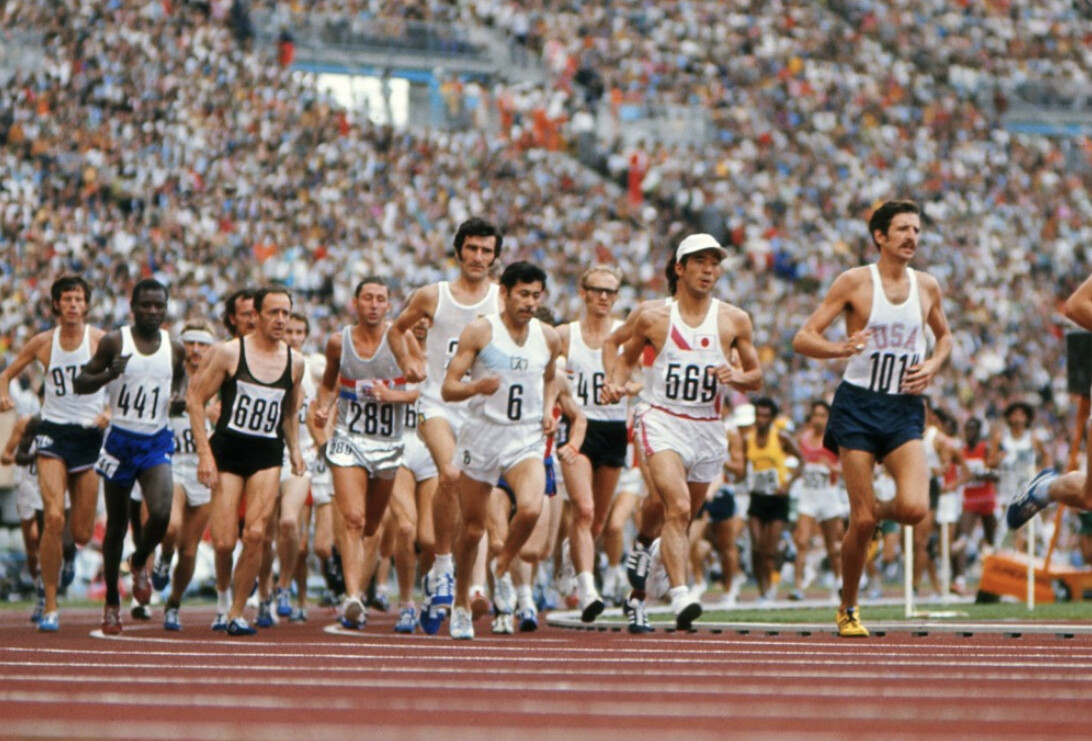
Four years later Frank added a silver medal to that gold when he finished second in the marathon at the games in Montreal.
Postscript from Pete Stein:
Tom Laris made the Olympic team in 1964, competing in the 10,000 … He missed making the team in 1969 … And was one of the favorites, along with Frank Shorter, to make the team in 1972 … For a good portion of the race, he was running with Frank Shorter, well ahead of the other competitors in the race … And then, affected by the heat, ultimately, fading back … Ultimately, he finished fourth, serving as an alternate to the team … and not running in the Olympics
I felt very bad for Tom, because I knew how hard he worked to make the team … and how bad that he wanted to make the team as he knew that it would be his last opportunity
Months later, we crossed paths and I expressed my feelings for him … And he shared some thoughts that I have never forgotten … and which have served me well.
He said, “I believe that everything happens for a reason … And that sometimes things don’t work out the way that I would liked … And at the time, I would be greatly disappointed … but I learned to look for the reason that this happened as I moved on in my life … And ultimately, I would find the reason … And realize that ‘my disappointment at that time’ was a good step in the right direction that led to better things in my life.”
As I said, I never forgot what he said to me … And it served me well in my life.
by Mike Fanelli
Login to leave a comment
2022 BolderBoulder is on again after a two-year absence
One of Colorado’s traditions will return when the BolderBoulder 10K run resumes this Memorial Day after a two-year absence caused by the COVID-19 pandemic.
The first BolderBoulder in three years and the 42nd running of the event is cause for celebration, says Race Director Cliff Bosley.
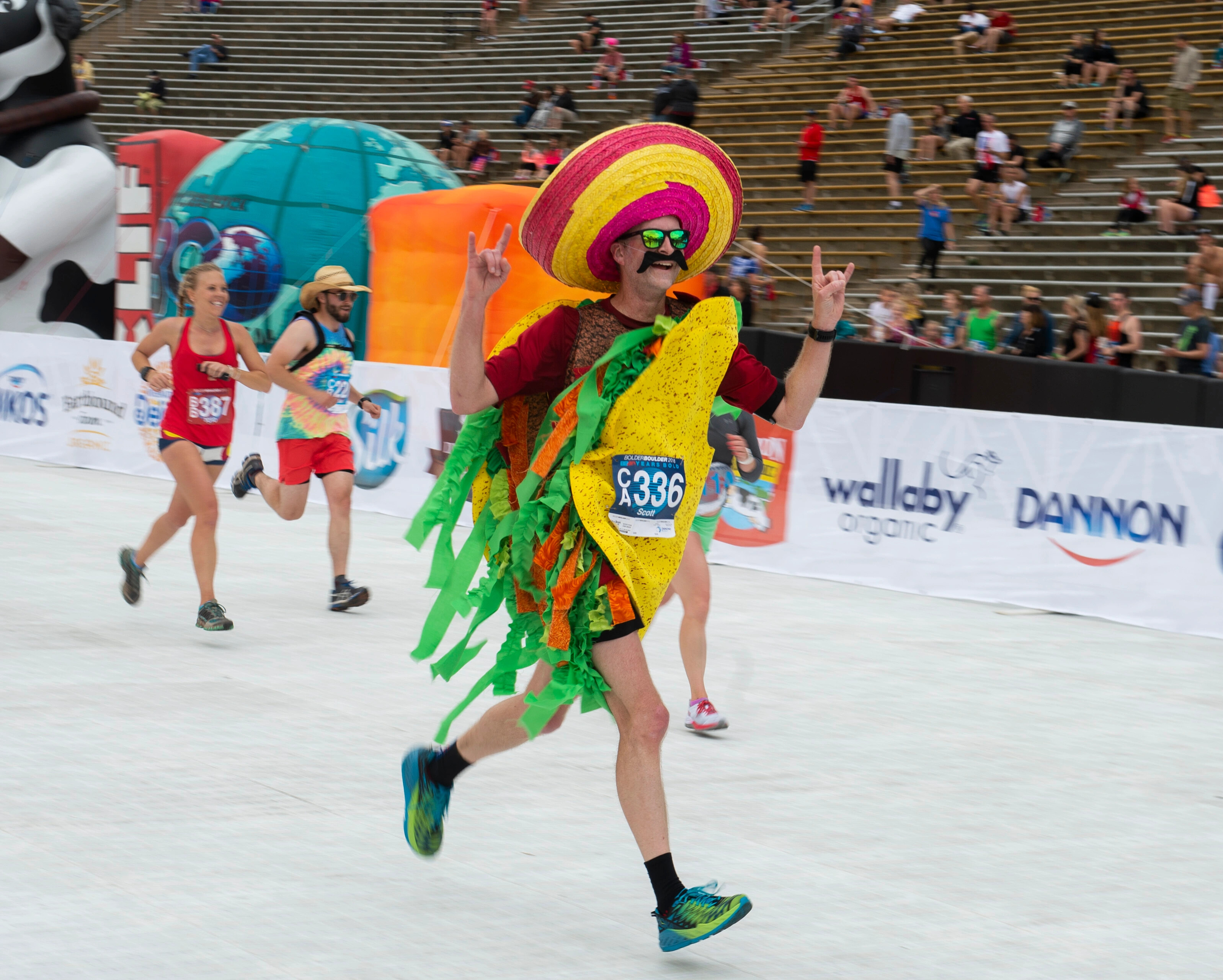
“We couldn’t be more excited to bring back this great tradition that is embraced by so many in our community, the state and beyond,” Bosley said. “We’ve missed our participants and our spectators and we know they’ve missed us. It’s great to be back with this fantastic outdoor community event.”
Bosley said the race’s return is testament to the hard work, collaboration and coordination of the BolderBoulder, the City of Boulder, CU Boulder and many additional partners and entities.
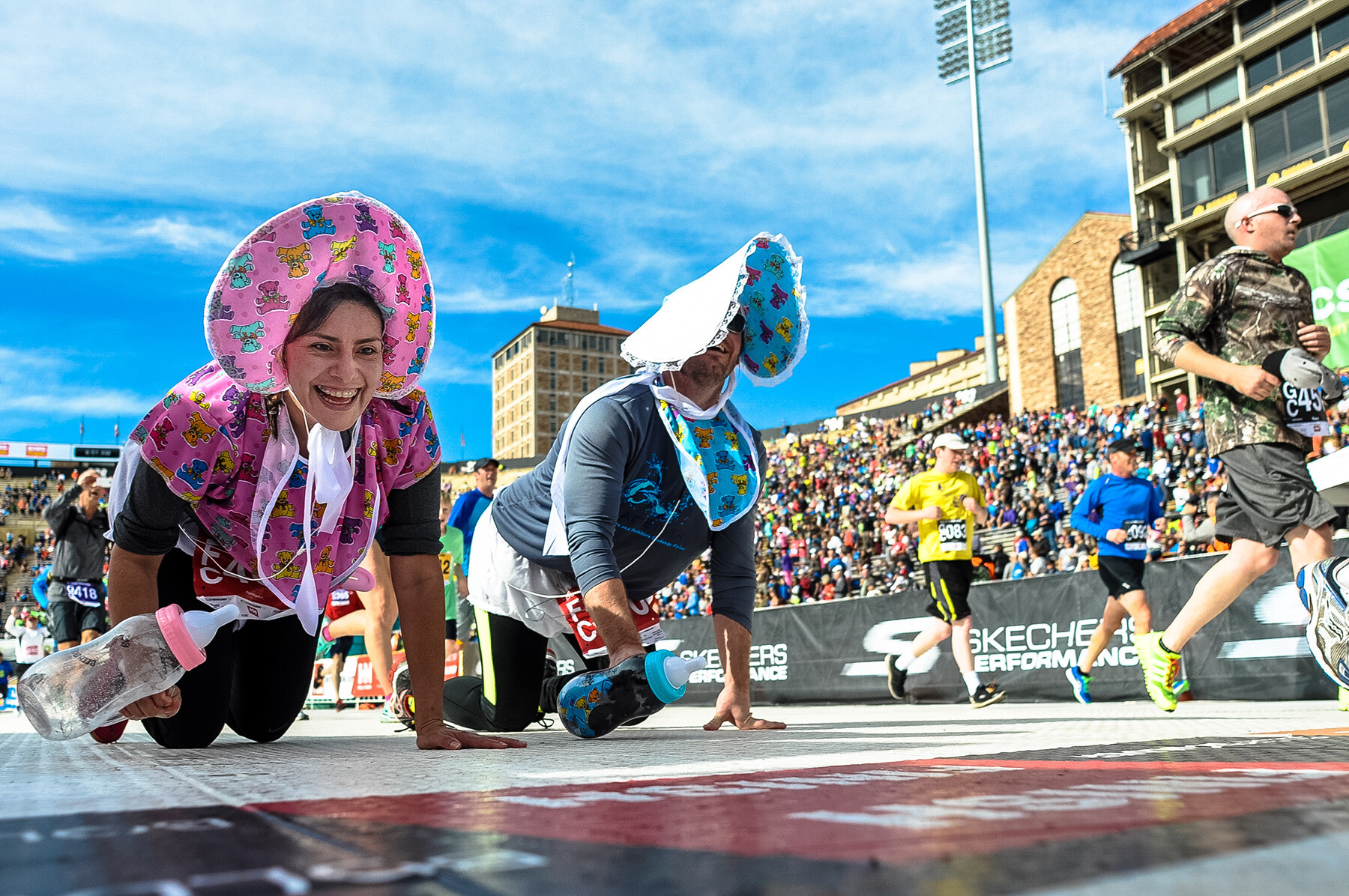
“Having to cancel the race the past two years gave us important perspective on just how much the BolderBoulder means to our participants, our spectators and the community,” Bosley said. “It’s like reconnecting with a great friend you haven’t seen lately.”
In addition to the 10K event, the Bolder Boulder is a remembrance of the more than 1.3 million men and women in the Armed Forces who made the supreme sacrifice in defending America’s freedoms. It also celebrates veterans and those now serving in the Armed Forces. It provides one of the largest Memorial Day tributes in the country.
This year’s race will also honor the 50th anniversary of Frank Shorter’s Olympic gold medal-winning run in the marathon at the Olympics in Munich in 1972. Shorter has been named the Official Starter of the 2022 BolderBoulder. He will launch more than 80 waves of competitors.
In 1981, Shorter won the race, becoming the first of 1,381,060 participants (over 40 years) to cross the finish line at Folsom Field on the University of Colorado campus. The event first finished in the stadium in 1981 and has done so ever since.
Bosley said the wave start, created and pioneered by the BolderBoulder, spaces out participants by design, adding to the safety of the outdoor event. The A wave (the first to start) is scheduled to begin at 6:55 a.m. and the final wave is expected to start around 9:30 a.m.
We felt this event’s absence due to COVID-19 and are delighted to welcome locals and visitors back to Boulder,”, said Boulder City Manager Nuria Rivera-Vandermyde. “The BOLDERBoulder is a Memorial Day tradition, a rite of passage from spring to summer and a community-defining event that brings us together to showcase the best of Boulder and the University of Colorado.”
CU Boulder Chancellor Phil DiStefano said CU Boulder is excited to see the event’s return. “CU Boulder and the BolderBoulder have been great partners for several decades on this community-wide race and celebration,” he said. “We are as delighted as anyone to see it return and we’re thrilled to have it once again finish on our campus.”
About BOLDERBoulder
The BOLDERBoulder, named America’s All-Time Best 10K by Runner’s World magazine, is the 5th largest running race in the United States and the 7th largest in the world.
The race attracts 48,000-52,000 runners, joggers, walkers, wheelchair racers and professional athletes from around the world to compete in one of the most unique pro race team formats in road racing.
The race course winds through Boulder neighborhoods with live music and entertainment at every corner. The race finishes at the University of Colorado’s Folsom Field and attracts over 100,000 runners and spectators.
Login to leave a comment
BOLDER BOULDER
In 1979 we dreamt of attracting a few hundred of our friends to race though the streets of Boulder, Colorado to celebrate Memorial Day with our families. Fast forward almost 40 years and the Bolder BOULDER has grown to become one of the largest and most highly acclaimed 10K’s in the world. Almost 1.2 million runners, joggers, walkers and spectators...
more...Kenny Moore one of the great story tellers of American sport for decades has died
Kenny Moore, a former University of Oregon distance runner, two-time Olympian, journalist and author, died Wednesday in Kailua, Hawaii. He was 78.
Kenny's wife, Connie Johnston Moore, would like to share this message with you and with others, written from their long-time Hawaiian home:
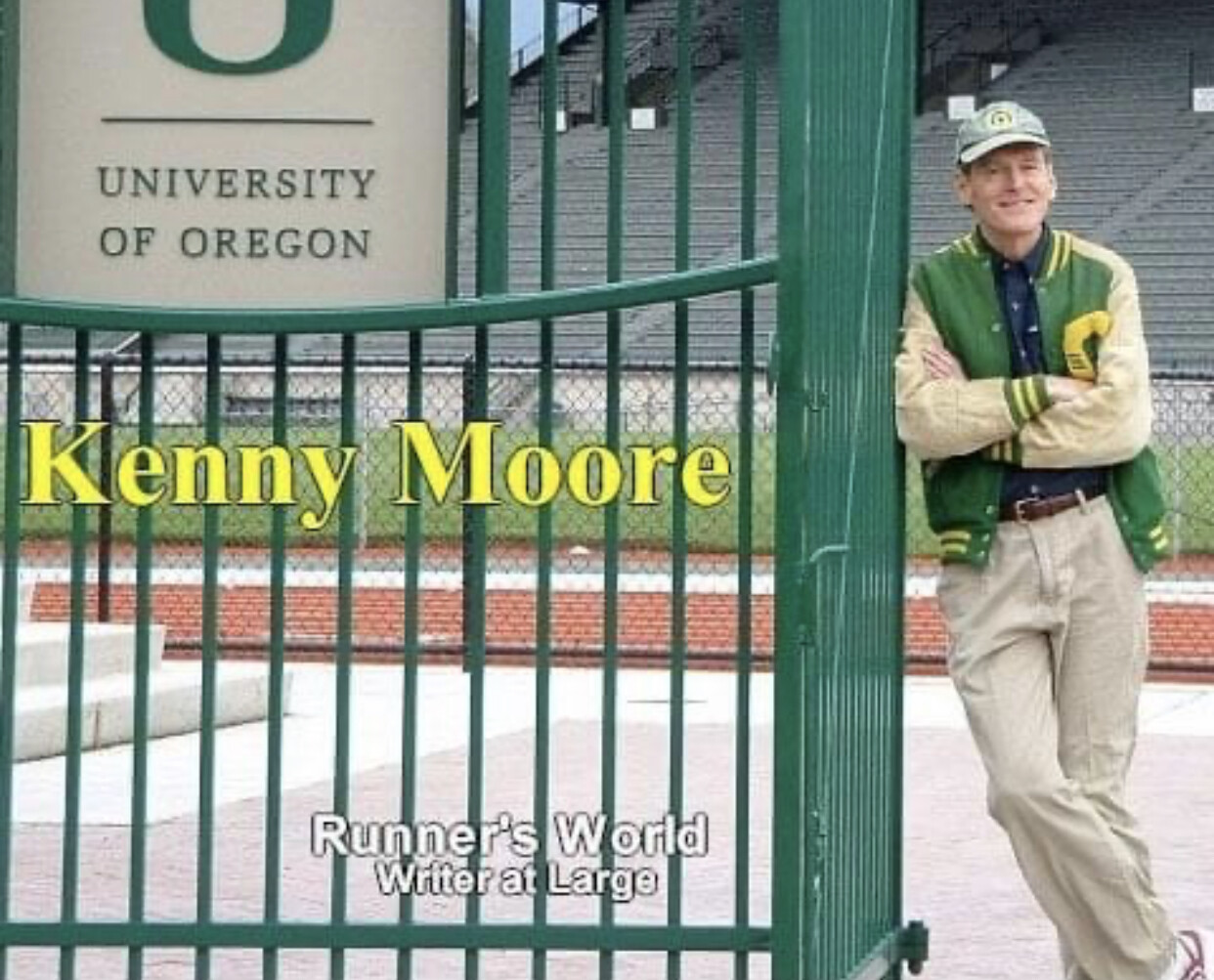
"Kenny found his opening this morning. It was about 7. He was already pretty distant and peaceful and then his breathing stopped. It was a very loving time for me with him. I think he knew he could leave with this morning being our last sunrise. I know you are sad but be grateful for him. It was his time and it was a relatively easy letting go I think for him. I hope you can spread the word for me. Take your time. Just love Kenny, love love love him. We were all privileged to know him and have him in our life. Peace and Love to you and everyone in Eugene."
From his 2019 Induction into the Oregon Sports Hall of Fame and Museum
As an athlete, Kenny Moore found himself right in the middle of some of those great stories while putting his own stamp on running and track and field greatness.
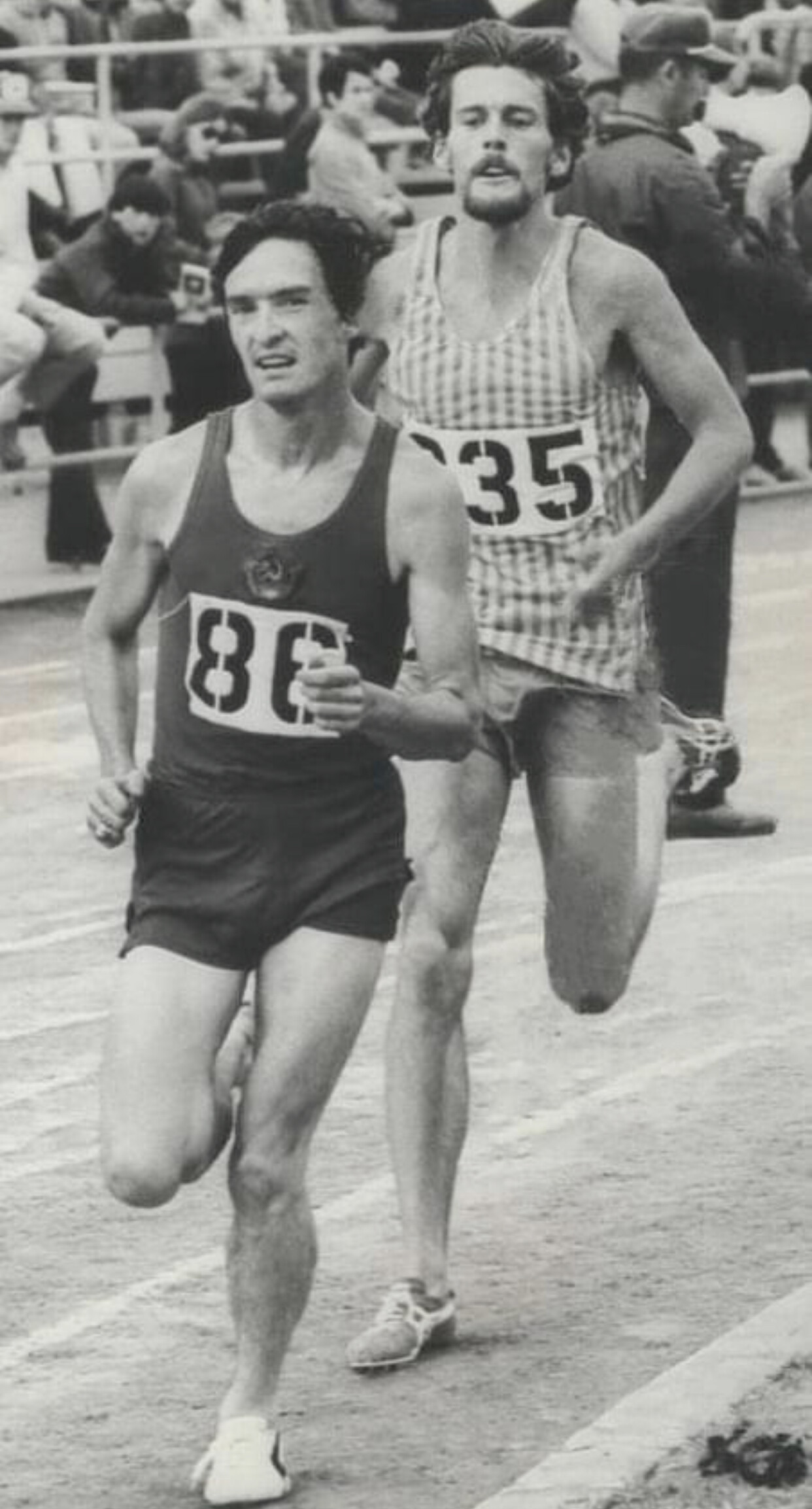
He was known as ‘Ken’ Moore when he graduated North Eugene high school and arrived at the University of Oregon. He would letter three years each in track and cross country.
Always a versatile distance runner, Ken was a three time All-American on the track, with three more top national finishes in the 3-mile, 5,000 meters and the steeplechase. Moore was a 1963 cross country All-American and was part of back-to-back teams that finished 2nd in the nation.
As a post-collegiate racer, he flexed his muscle at greater distances, winning the 1967 US Cross Country Championship and dominating the demanding Bay to Breakers road race in San Francisco. Ken won the 12K monster six consecutive years from 1968-1973.
In 1970, Moore placed second in the prestigious Fukuoka International Marathon with a loop-course American record and personal best time of 2:11.36.
Moore competed on the biggest stage of all twice. He finished 14th in the marathon at the Mexico City Olympics then qualified again in 1972, finishing dead even with training partner Frank Shorter. Shorter would take the gold and glory on the final day of the Munich games in the shadow of the terrorist attacks. Moore just missed the podium, finishing 4th.
These experiences and these times provided extensive material for the writer who would become known as Kenny Moore. In 25 years at Sports Illustrated, Moore told the big stories, championed the protection of amateur athletes and co-wrote the definitive biography of the enigmatic Steve Prefontaine that inspired the film “Without Limits”. Moore has also written a biography of his Oregon coach, the legendary Bill Bowerman.
His activism helped win the freedom of imprisoned Ethiopian marathon champion Mamo Wolde.
KENNY MOORE - Athlete and Writer R.I.P.
(December 1, 1943 to May 4, 2022)
Login to leave a comment
What would Jerome Drayton’s marathon time be with today’s shoe technology?
At Japan’s Fukuoka Marathon in 1975, Canada’s Jerome Drayton smashed his Canadian record from 1969 to win the marathon in 2:10:09 – a record that stood for 43 years until Cam Levins broke it at the 2018 Toronto Waterfront Marathon (2:09:25). When Levins set the record, he ran in the Hoka Carbon Rocket X, a shoe with carbon-plated technology Drayton did not have 43 years prior. Both times are remarkable, but it brings into question what Drayton’s time would translate to today if he had had carbon-plated shoes.
In the 70s, the Fukuoka Marathon had the reputation as the unofficial world championship, as organizers would invite the best marathoners from around the world to Fukuoka to compete. Drayton won the race three times in seven years, beating the likes of marathon greats American Frank Shorter and Japan’s Shigeru So (who held the world record from 1978 to 1980).
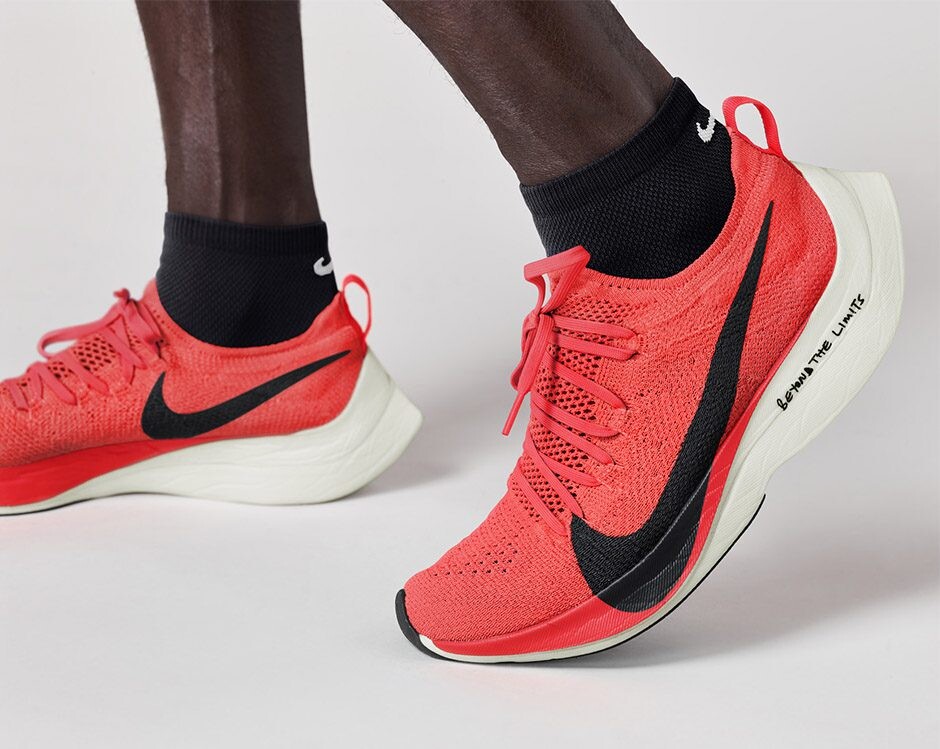
When Drayton set his record he wasn’t wearing the Adidas Adizero Pro or Nike Vaporfly. He had the Adidas SL76 on his feet, which was described as ‘the shoes for all seasons,’ built for pounding the roads in the marathon and jogging around the block. The shoe featured super-light technology, a ghillie loop lacing system and an EVA midsole – in short, a lightweight, flat running shoe.
In a 2021 video from Brigham Young University student Easton Allred, he discussed the development of carbon-plated shoes with a professor of biomechanics, Dr. Iain Hunter, who studies how people can run faster by the way they move. The two discussed whether carbon-plated shoes affect athletic performance and how much time they could take off each kilometre.
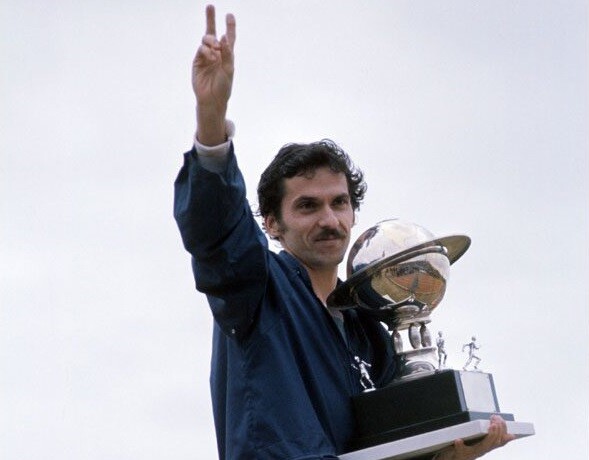
Hunter found that the top carbon plated shoes can take off two to three seconds per kilometer.
If you take Drayton’s time of 2:10:09 and take two seconds off each kilometre, it correlates to approximately 84 seconds off his time (2:08:45). Again, this calculation is hypothetical, but that time would be a record and untouched by any Canadian runner to this day.
by Marley Dickinson
Login to leave a comment
Fukuoka Marathon
The Fukuoka International Open Marathon Championship is one of the longest running races in Japan, it is alsoan international men’s marathon race established in 1947. The course record is held by Tsegaye Kebede of Ethiopia, running 2:05:18 in 2009. Frank Shorter won first straight years from 1971 to 1974. Derek Clayton set the World Record here in 1967 running 2:09:37. ...
more...How to hill train without a hill, you can still prepare for a hilly race, even if you live somewhere flat
We talk a lot about the benefits of hill running, but if you live in a flat area, what are you supposed to do? Not every neighbourhood has its own version of heartbreak hill, but that doesn’t mean runners who live there can’t still simulate the benefits of hill training.
If you’ve got a hilly race coming up on the calendar and nowhere to train for it, use these alternatives to be ready for it.

You may not have any big hills nearby, but if you have a good set of stairs at your disposal, they make an excellent alternative. This one’s easy if you live in an apartment building, but if you have a stadium nearby with bleachers, that works too. Depending on the size of the staircase, you can simply run to the top, jog (carefully) back down and repeat, but if the staircase is particularly long, you could break it up however you like (for example: 2 minutes hard, 1 minute easy).
One of the big benefits of hill training is it improves your strength and power so you can run faster and stronger on the flats. You can make similar gains in the gym as well. Mimic hill training indoors with explosive movements like box jumps, jump lunges and jump squats, and improve your ability to handle the pounding associated with downhill running by doing lots of eccentric contractions, where you’re slowing down the movement while you lengthen the muscle (as you lower yourself into a squat, as you’re jumping back down off of the box, etc.).

Add some surges to your run
Olympic gold medal winner Frank Shorter once said “hills are speedwork in disguise,” so if you don’t have a hill nearby, try adding some one-minute or 30-second surges every three or four minutes during a tempo run. This forces you to change up your gait in a similar way as if you were tackling a hill in the middle of your run.
Hop on the ‘mill
Love it or hate it, the treadmill is an excellent tool to train hills when you don’t have a hill nearby. All you have to do is crank up the incline, and you’ve got a great hill workout without going anywhere.
by Brittany Hambleton
Login to leave a comment
Githae wins final edition of Fukuoka Marathon
Michael Githae was victorious at the 75th and final edition of Fukuoka International Marathon on Sunday (5), winning the World Athletics Elite Label road race in 2:07:51.
Githae, who runs for Suzuki track team, improved his previous best of 2:08:17, which he set when finishing fourth at last year’s Fukuoka Marathon. Japan’s Kyohei Hosoya finished second, 25 seconds adrift of Githae.
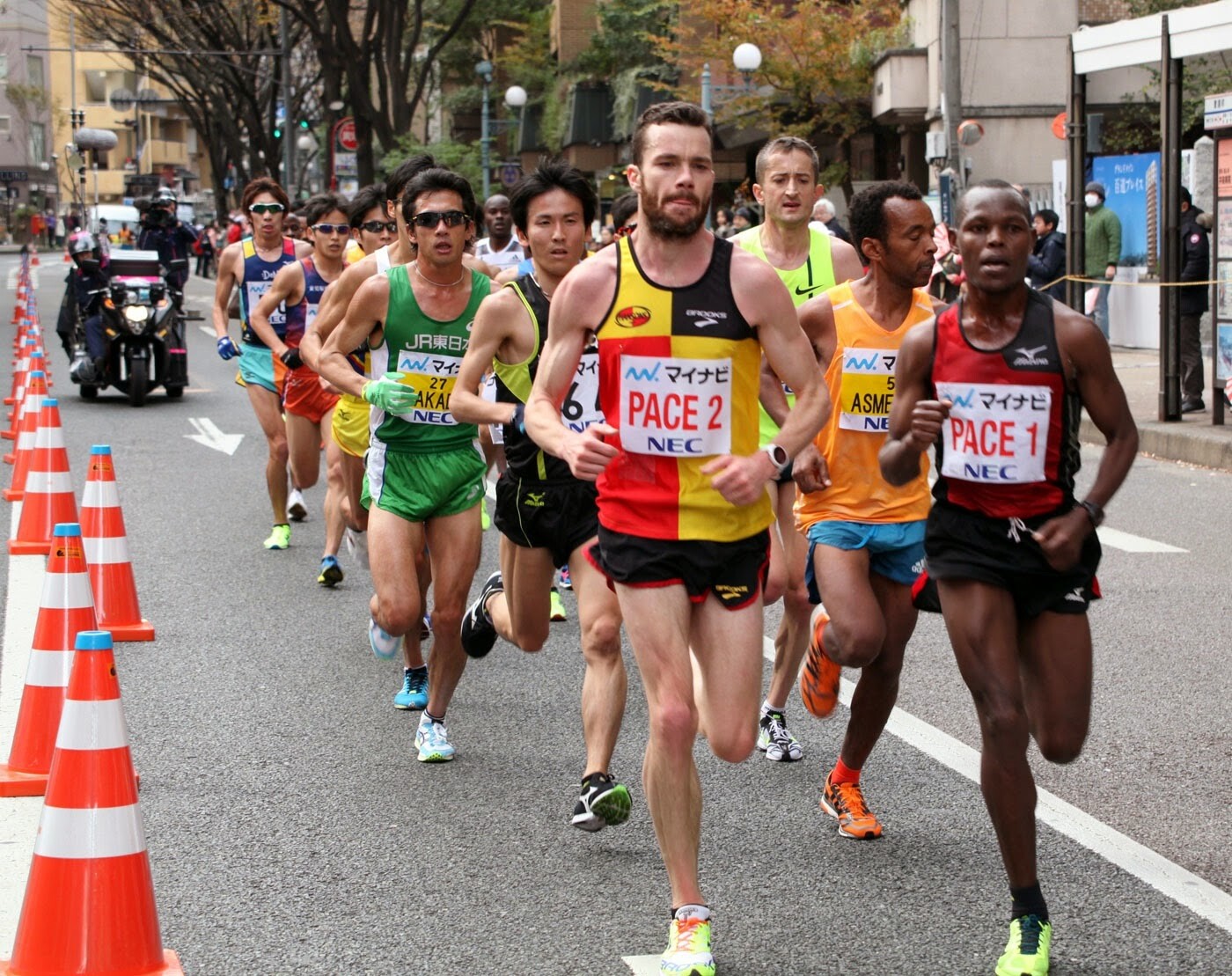
The pacers, led by 2012 Olympian Yuki Sato, directed the huge lead pack through 5km (14:47), 10km (29:39), 15km (44:30) and 20km (59:24) in what turned out to be something of a race of attrition. Yuta Shitara was one of the athletes to fall out of contention before the half-way stage; the former national marathon record-holder dropped out at 20km.
The half-way point was reached in 1:02:41, meaning an attack on the 2:05:18 course record was not out of the question. Simon Kariuki and Charles Wanjiku kept the pace going at the start of the second half, and 30km was reached in 1:29:08. But the pacemakers dropped out soon after, and the pace dramatically slowed down.
Nevertheless, the pack became strung out to almost a single file, and by 34km just Githae, James Rungaru, Hosoya and Ryu Takaku remained in contention. Soon after, Githae surged and Hosoya made a valiant effort to stay close but Githae gradually pulled away to win by 25 seconds in 2:07:51.
In third, Rungaru set a PB of 2:08:25, while fourth-placed Shohei Otsuka and Ryu Takaku and Daisuke Uekado in fifth and sixth respectively were just outside their PBs. Yuki Kawauchi, running his 12th Fukuoka Marathon, fittingly finished 12th in 2:11:33. He is planning on running the Hofu Marathon in two weeks’ time.
Looking back at Fukuoka's history
The Fukuoka International Marathon – which was awarded a World Athletics Heritage Plaque in 2019 – started in 1947 and is the second oldest marathon in Japan behind the now defunct Lake Biwa Marathon.
In its 75-year history, the world record was broken twice there – first in 1967 when Derek Clayton became the first runner to break 2:10 with 2:09:37, and then in 1981 when fellow Australian Rob de Castella ran 2:08:18.
De Castella isn’t the only global marathon champion to have contested the race over the years. Frank Shorter, the 1972 Olympic champion, notched up four consecutive Fukuoka Marathon victories between 1971 and 1974. 2000 Olympic champion Gezahegn Abera won in 1999, 2001 and 2002, while 1996 Olympic champion Josiah Thugwane won in 1997. The late Samuel Wanjiru, winner of the 2008 Olympic title, made a remarkable marathon debut in Fukuoka in 2007, winning in 2:06:39. And two-time world champion Jaoud Gharib won in 2010.
Numerous world record-holders have also competed in Fukuoka, including Haile Gebrselassie (winner in 2006), Belayneh Dinsamo (1990 winner) and Patrick Makau (2014 and 2015 champion).
Japanese runners have also enjoyed moments of victory in Fukuoka. Toshihiko Seko won four times (1978-1980 and 1983), and Takeyuki Nakayama won twice (1984 and 1987). During his 1987 run, Nakayama was on world record pace through 20km (58:37) and 35km until a heavy downpour in the closing stages slowed him down, and he eventually finished in 2:08:18.
When asked about the end of the Fukuoka Marathon, four-time winner Seko said: “It is like part of my history is being erased.”
Japan Running News, a leading authority on the sport in Japan, has produced a docu-film on the Fukuoka Marathon, entitled ‘Inside the Outside – When the World Came to Fukuoka’.
Leading results
1 Michael Githae (KEN) 2:07:512 Kyohei Hosoya (JPN) 2:08:163 James Rungaru (KEN) 2:08:254 Shohei Otsuka (JPN) 2:08:335 Ryu Takaku (JPN) 2:08:386 Daisuke Uekado (JPN) 2:08:567 Kohei Futaoka (JPN) 2:09:148 Masaya Taguchi (JPN) 2:09:359 Toshiki Sadakata (JPN) 2:10:3110 Takuma Kumagai (JPN) 2:10:4111 Ryota Komori (JPN) 2:11:3212 Yuki Kawauchi (JPN) 2:11:33
Login to leave a comment
Canadian releases Fukuoka Marathon documentary
Brett Larner of the Japan Running News website released his documentary on the iconic Fukuoka International Marathon, which saw its final running (open to locals only) on Dec. 6. Inside the Outside: When the World Came to Fukuoka tells the story of the non-Japanese runners, who, over the race’s long history, turned it into the unofficial world men’s marathon championship.
The film, which is introduced by Larner (and which he produced), does not focus on the 24 Japanese athletes who pushed each other to victory at Fukuoka over the race’s 75-year history, but on the foreigners who came to race there, giving the race an international profile and contributing significantly to its mystique. (Larner himself ran it in 2007 – the year that Sammy Wanjiru of Kenya, who would go on to win Olympic gold the following year, set a course record in his marathon debut.)

The first outsider to be interviewed is Pavel Kantorek of the former Czechoslovakia, who won Fukuoka in 1961. He raced there six times in all and never performed worse than fifth; he also ran in the Olympic marathon in 1956, 1960 and 1964. Kantorek, who was married at the time, comments that he kept getting invited to return because of his exemplary behaviour, unlike some of the runners, who were “more interested in the Japanese geisha than in racing.”
Other notable athletes interviewed include Amby Burfoot, who won the Boston Marathon in 1968 and was fifth at Fukuoka the same year, finishing just shy of the American record; double Olympic medallist Frank Shorter, who won Fukuoka every year from 1971 to 1974, who says “Fukuoka is where I was born as a marathon runner”; and Canada’s own Jerome Drayton, a two-time Olympian who won the Boston Marathon in 1977 and the Fukuoka Marathon in 1969, 1975 and 1976 (and his 1975 winning time, 2:10:09, was the Canadian marathon record for 43 years). Four-time Boston Marathon and NYC Marathon champion Bill Rodgers, who ran in the 1976 Olympics, won Fukuoka in 1977 and was third in 1975.
For many of the early Fukuoka runners, it was the first time they’d been invited to compete at an international marathon, and it became very prestigious on that basis. The meaning the race holds for them is obvious in their words, many of which were delivered via iPhone, thanks to the constraints of pandemic-style filmmaking. Fans of the marathon’s history will find a great deal of value in the film.
by Running magazine
Login to leave a comment
World Championships Oregon22 marathon course revealed
The marathon course for the World Athletics Championships Oregon22 has been revealed by the local organising committee (LOC) for the event. Spectators will be able to line the course and experience the world-class competition for free.
The men’s and women’s marathons, taking place on 17 and 18 July 2022, will be contested on a mostly flat 14km looped course that will run through Eugene and Springfield. Athletes will start and finish in front of the University of Oregon’s Autzen Stadium.
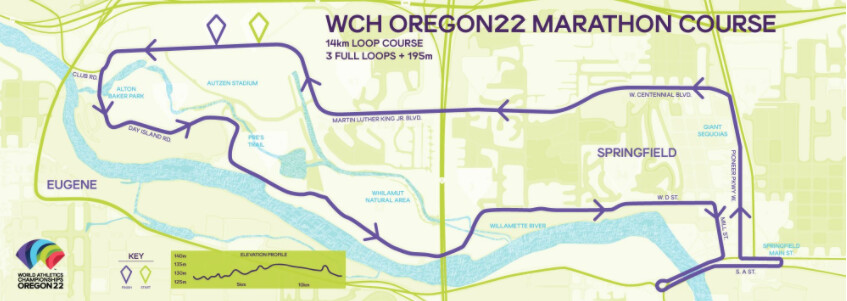
“The opportunity to run a marathon at a World Athletics Championships right here on US soil would be an experience of a lifetime,” said Emma Bates, second place finisher and top US woman at the 2021 Chicago Marathon. “The looped course gives runners the ability to learn and adapt as the race develops, and I think that will result in some fantastic, strategic competition.”
The course follows long sections of the marathon route used for the 1972 and 1976 US Olympic Trials, while also showcasing the beauty and history of Oregon through the landmarks and landscapes of Eugene and Springfield.
“Our objective was to design a course that prioritises the athlete experience while honouring Oregon’s natural landscape, indigenous people, and long-held passion for running,” said WCH Oregon22 Road Events Course Manager Ian Dobson.
“As members of this community, we're proud to give the world’s best runners the opportunity to compete on a course that holds so much history and potential. These marathons will write a new chapter in Oregon’s running story, creating new legends in the footsteps of Frank Shorter, Jacqueline Hansen, Kenny Moore, Joan Benoit and countless others who raced these roads as they helped inspire and redefine what road racing could be – not only in the US, but globally.”
The loop begins on Martin Luther King, Jr. Boulevard, named after the American civil rights leader. From there, it moves into Alton Baker Park, a 413-acre natural area in Eugene.
While on Day Island Road within Alton Baker Park, the route will follow alongside Pre’s Trail. Designated as a City of Eugene historic landmark in 2019, Pre’s Trail is a bark running trail that celebrates University of Oregon track and field legend Steve Prefontaine.
Another feature of this part of the course are the Kalapuya Talking Stones. Showcased in the Whilamut Natural Area of Alton Baker Park, these 15 basalt stones are carved with Kalapuya words and their English translations.
The course will cross over the stunning Willamette River, considered the lifeblood of the Willamette Valley, and then move into the City of Springfield. Competitors will traverse Main Street before running beneath the canopy of a stretch of incredible giant sequoia trees.
The World Athletics Championships Oregon22 will be taking place 15–24 July 2022.
by World Athletics
Login to leave a comment
Markus Ryffel donates 1984 Olympic shoes to Heritage Collection
Markus Ryffel has generously donated to the World Athletics Heritage Collection one of the running spikes he wore when earning the 5000m silver medal at the 1984 Olympic Games.
The Swiss distance runner donated his left shoe to the collection in June and it is now on permanent view in glorious 360Ëš 3D in the Olympic Athletics Collection room of the Museum of World Athletics (MOWA), the world’s first virtual sports museum.
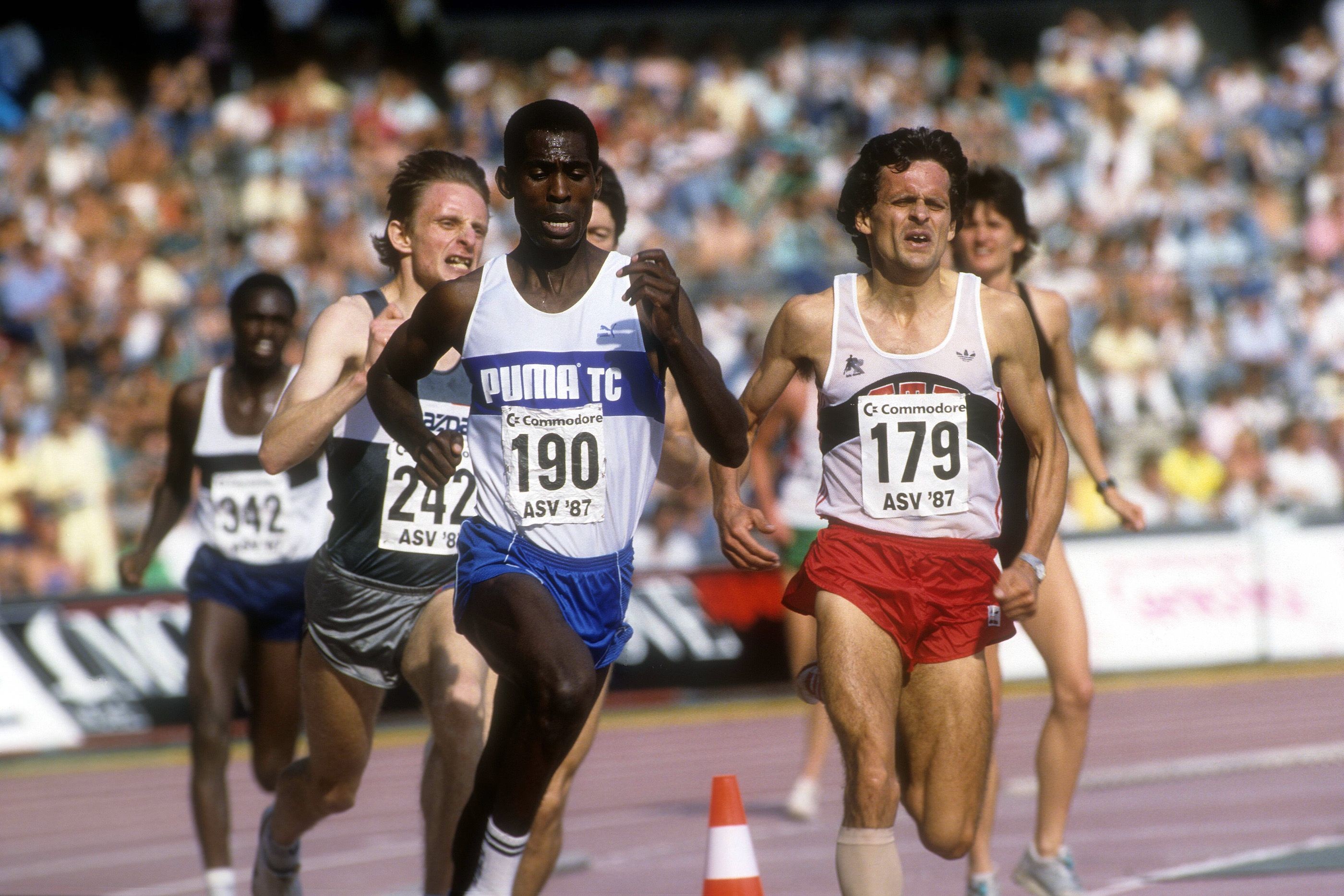
This evening at the Weltklasse Zürich Heritage Night, Ryffel was able to officially hand over the spike in person to his friend and racing contemporary, World Athletics President Sebastian Coe, who won his second 1500m title in Los Angeles in 1984.
Still the Swiss 5000m record

The final day of the 1984 Olympic athletics programme was hot and damp. The Swiss spectators among the 90,000 crowd in the Memorial Coliseum started to sweat even more as Ryffel geared up for his final sprint, 300 metres from the finish line of the 5000m final.
Portugal’s Antonio Leitao, pre-race favourite Said Aouita of Morocco, and Ryffel were neck and neck in lanes one, two and three. For a moment, even a Swiss Olympic victory seemed possible.
Aouita, however, showed himself unimpressed by Ryffel’s efforts and ran the last 400m in an unheard-of 54.7 seconds. He became the victor of a memorable race: then the third-best time in history for the Moroccan (13:05.59), with fifth place on the world all-time list for Ryffel.
Ryffel’s 13:07.54 still stands as the Swiss record 37 years later. Aouita’s Olympic record was only improved in Beijing in 2008 by Kenenisa Bekele.
Calf injury
While Aouita became the first man to run 5000m within 13 minutes in Rome, 11 months after his triumph in Los Angeles, for Ryffel the silver medal from Los Angeles remained the highlight of an illustrious career.
At the European Championships two years later, he was in a promising position but had to withdraw with an injury, which ended up requiring surgery. His calf muscles – including varicose veins inherited from his father – also thwarted his efforts at his last great aim, the marathon. He made several attempts at completing races, but time and again he had to give up some time after 30 kilometres with calf pain. He never made it to a fourth Olympics and retired from elite sport in late 1991.
New York comes to Uster
Ryffel was by no means bitter; quite the contrary. He had planned ahead during his active years. As a young man he had been a fan of Frank Shorter, the 1972 Olympic marathon champion. So it was not surprising that, aged 22, he accompanied his older brother Urs, himself a fairly successful cyclist, to the 1977 New York Marathon. He finished 16th, just ahead of four-time Olympic champion Lasse Viren.
Both of them were impressed by the “amazing atmosphere” of this mass event.
“We wanted to start something similar in our home-town Uster,” said Ryffel. And so, they established the race around the idyllic Greifensee near Zürich which has been running since 1980, initially 19km long, and over the half marathon distance since 1992. In 1998, Uster even hosted the World Half Marathon Championships, where Paul Koech and Tegla Loroupe from Kenya were the winners.
Running weeks
By the end of the 1970s, Ryffel began organising running weeks in St Moritz and trips to the New York Marathon, alongside his friends and training partners Dietmar Millonig of Austria and Thomas Wessinghage of West Germany.
The trio of runners still work together. Although the goal of the original ‘running weeks’ was to help participants achieve a 3:30 marathon time, the events have now morphed into more general running and fitness holidays in St Moritz and other alpine destinations.
Around the same time, Ryffel opened his first Ryffel Running Shop in Bern together with his brother Urs and business partner Markus Bill. A second shop in Uster followed shortly after, and the business later employed up to 28 people.
“It started in a cow shed next to my parents’ restaurant,” remembers Ryffel. He has since sold the shops to a larger company, and now organises running events, active holidays, trips to marathon races and private coaching.
‘The bike really shaped me’
Ryffel learned early that it was important to be decisive and work hard towards one’s aims. “My parents had a restaurant and a butcher shop, and we had a delivery service. Without it, I would never have become such a good runner. The kilometres on the bike really shaped me because the heart does not distinguish between cycling and running.
“Even in primary school, I did 20 or 30 km on my bike,” he added. “I had my 17 customers to whom I delivered cordon bleu and other meats.”
Ryffel’s parents, however, were not supportive of their son’s sporting ambitions at first. So it was lucky that Ryffel moved to Bern for an apprenticeship in typesetting, where he could be near his supporter and coach Heinz Schild. There he started running in the uniform of the City of Bern gymnastics club.
Ryffel is now 66. He still runs and has calculated from his paper training log that he jogged his 200,000th kilometre in 2020. That’s five times around the earth.
“I can still run regularly – and, most importantly, without pain,” he said. “And if all goes well, I will be running my 98th marathon in Chicago this year.” Because of Covid, the usual group trip to New York cannot happen, and Ryffel wants to participate in this marathon with a group aiming at a 4:30 finish time.
Times have changed. “Just being there is everything now,” he says.
by World Athletics
Login to leave a comment
Eliud Kipchoge Wins Olympic Marathon Again, This Time In Tokyo
Eliud Kipchoge delivered a dominating performance in the Tokyo Olympics men’s marathon, pulling away from his competition after the halfway point and finishing 1 minute, 20 seconds ahead of second-place finisher Abdi Nageeye of the Netherlands on a steamy day in Sapporo, Japan.
Kipchoge of Kenya, the world record holder in the marathon, is the first men’s repeat Olympic winner since Waldemar Cierpinski of the former East Germany in 1976 and 1980. Kipchoge finished in 2 hours, eight minutes, 38 seconds.
Nageeye clocked in at 2:09:58, and Bashir Abdi of Belgium finished third, in 2:10:00.
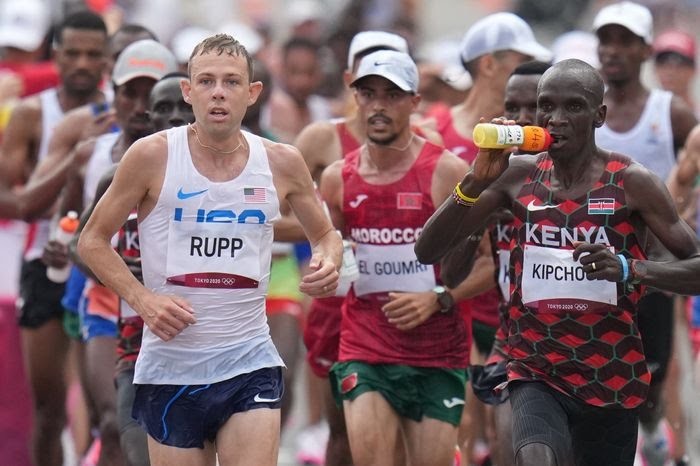
American Galen Rupp, who won bronze in the marathon at the Rio 2016 Games, finished eighth, more than three minutes back in 2:11:41.
Galen Rupp of the U.S. finished eighth in the Olympic marathon.
After the 15-mile mark, Kipchoge, in front of the lead pack, turned and looked over his shoulder at Rupp and said something to him. Shortly after that, Kipchoge took off and began building his insurmountable lead.
NBC commentators said that Kipchoge seemed irritated with Rupp in the encounter.
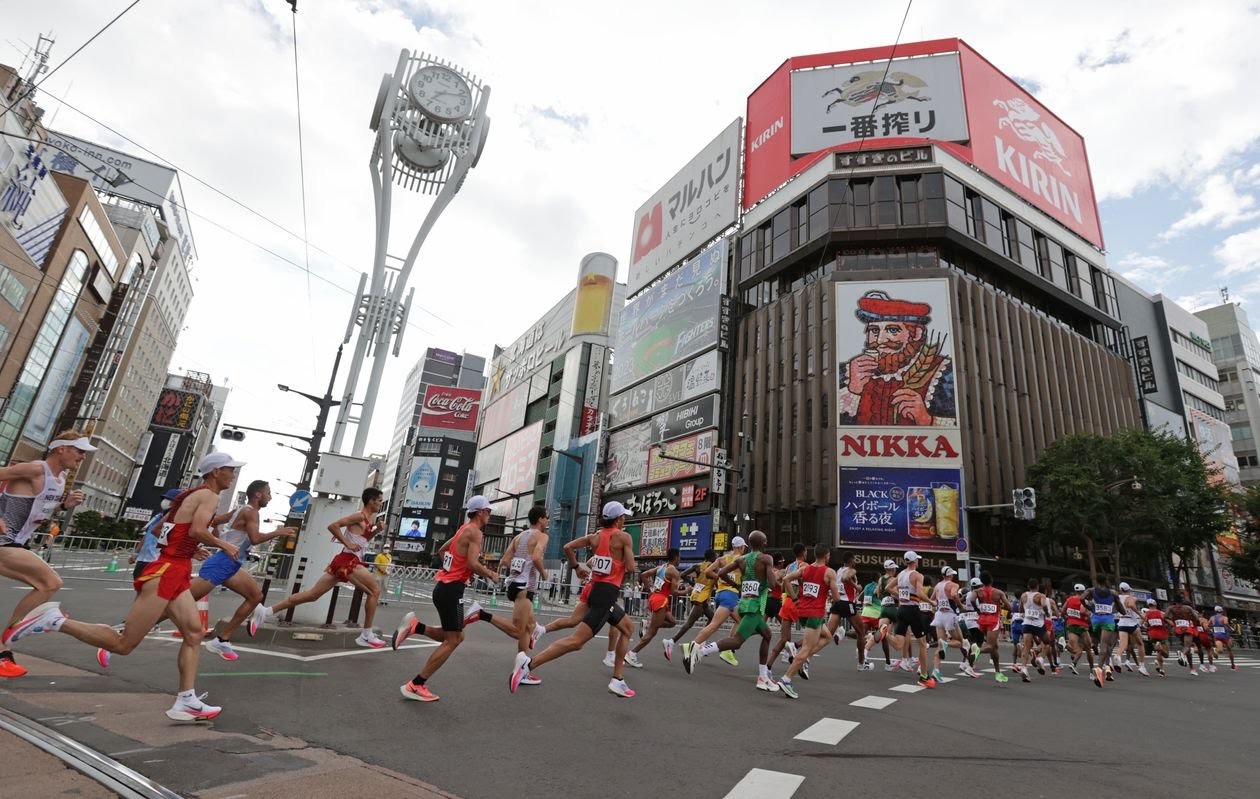
“We saw Kipchoge get annoyed, which is so, so rare,” NBC commentator Kara Goucher said.
Rupp won the U.S. Olympic marathon trials in February 2020 and had targeted gold in Sunday’s race. He won silver in the 10,000 meters in London 2012 and bronze in the Rio 2016 marathon.
American Jacob Riley finished 29th, in 2:16:26, and American Abdi Abdirahman 41st in 2:18:27. Abdirahman, 44 years old and competing in his fifth Games, is the oldest U.S. runner to ever make the U.S. Olympic team.
The 36-year-old Kipchoge, competing in his fourth Olympics, entered the race with three medals: a bronze in the 5,000 meters in Athens 2004, silver in the 5,000 in Beijing 2008 and gold in the marathon in Rio 2016. He failed to qualify for Kenya’s team for London 2012.
Kipchoge famously broke the two-hour marathon barrier on a closed-course race in Vienna in October 2019, part of a years-long effort by Nike that included a new type of shoes. The thick-soled shoes with superlight cushioning and a carbon-fiber plate have spawned copycats, lowered finishing times and taken over the sport.
Kipchoge was so in command of the race that more than 10 miles in, he appeared to fist-bump with Brazil’s Daniel Do Nascimento.
Do Nascimento, in fourth place at the half-marathon mark, soon dropped out then crumpled onto the road.
It was over 80 degrees with humidity over 70%. Runners shoved bags of ice down the backs of their singlets or tucked cooling packs under hats. More than two dozen runners didn’t finish the race.
Runners move past the Susukino district while competing in the men’s marathon.
Frank Shorter was the last American man to win the Olympic marathon, in 1972.
Since then, the gold has been won twice by the East German, three times by Kenyans (including twice by Kipchoge), twice by Italians, and once by an Ethiopian, a South African, a Korean, a Portugese and a Ugandan.
U.S. runner Molly Seidel was a surprise medalist in the women’s Olympic marathon Saturday, finishing in third to take the bronze.
by Wall Street Journal
Login to leave a comment
Tokyo 2020 Olympic Games
Fifty-six years after having organized the Olympic Games, the Japanese capital will be hosting a Summer edition for the second time, originally scheduled from July 24 to August 9, 2020, the games were postponed due to coronavirus outbreak, the postponed Tokyo Olympics will be held from July 23 to August 8 in 2021, according to the International Olympic Committee decision. ...
more...Over Half Of Ultrarunners Get Nauseous During Races; Here's Why
The list of issues and injuries that an ultrarunner can face while racing is lengthy. Blisters, chafing, cramps, muscle strains, knee pain, heat illnesses, and altitude sickness are just a handful of the possibilities. Perhaps none of these potential problems, however, are as prevalent and impactful during ultramarathons as nausea and vomiting. Indeed, practically every ultrarunner has their own tale of yakking on the side of a trail or into an aid station trashcan. For some, it's an unlucky one-off event, but for others, recurrent nausea consistently mars their ability to perform up to their expectations.
The reason so many ultrarunners get stricken with nausea is undoubtedly multi-faceted, and to be honest, there is not a cut-and-dry singular explanation. Still, we do have some clues as to why the prevalence of nausea and vomiting is up to 2-3 times more common in these races than much shorter distances. Let's take a look at what the research says about the possible culprits as well as some of the strategies you can try to deal with this troublesome symptom.
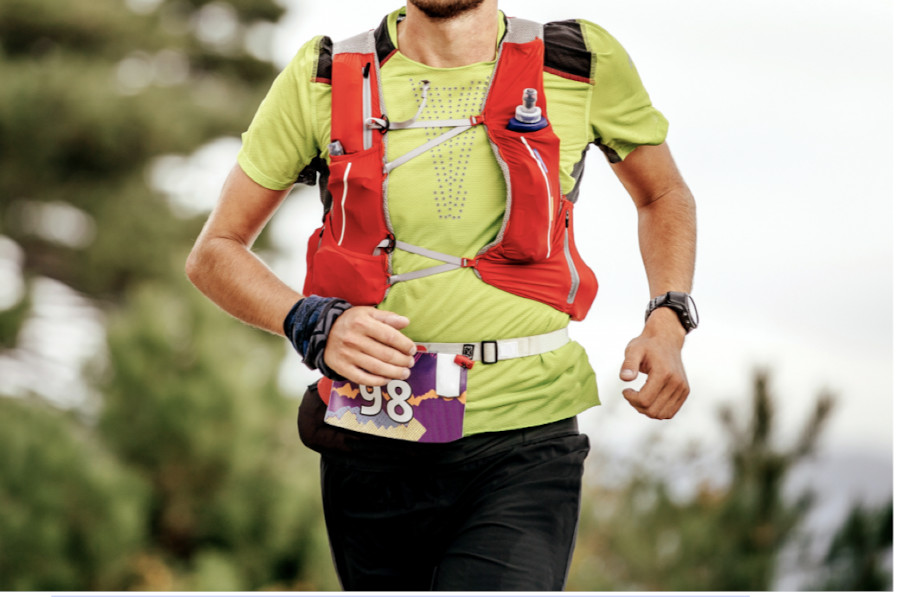
Just How Common Is Nausea?
Beyond the anecdotes, what exactly do we know about the prevalence of nausea in ultrarunners? Before we get to some data on that question, it's important to recognize that surveys used to gather this information quantify nausea differently. In addition, the occurrence of nausea is likely to vary with temperature and humidity, elevation, and the length of a race. As such, it's a bit foolhardy to throw out a single estimate of nausea and think that it applies to every ultrarunning scenario.
Caveats aside, some of the relevant data tells us that nausea incidence clearly increases with race duration. Dr. Martin Hoffman, professor emeritus in the Department of Physical Medicine and Rehabilitation at the University of California, Davis, has overseen several studies on this topic, and in some cases, up to 6 out of 10 runners experience nausea during an ultramarathon. To give you some perspective, consider that around 10% of regular marathoners typically suffer from nausea.
Now, some of these cases of nausea are quite mild or transient, meaning they won't hurt performance much. Still, up to half of cases can be severe enough to impact ultrarunning performance. In fact, one of Hoffman's investigations found that nausea or vomiting was the leading reason for racers to drop out of the Western States 100-mile Endurance Run. During a regular 26.2-mile marathon, a runner suffering from nausea near the end of the race is likely to grit their teeth and finish. In contrast, the thought of having to suffer for another 20, 30, or 50-plus miles while feeling queasy is, very understandably, too much for some ultrarunners to cope with.
Multiple Causes
The puzzle of why nausea is so common during ultrarunning is difficult to solve, in large part because there are multiple physiological changes occurring simultaneously over the course of an ultrarace. It's also incredibly tough to match the demands of an ultrarace in a laboratory, so mechanistic studies looking at the origins of nausea during super-prolonged exercise are few and far between.
Even with the scientific uncertainty, we do have some decent guesses as to what's provoking the urge to spew in so many ultrarunners. During prolonged exercise, you secrete hormones like adrenaline and glucagon into your blood that allow your body to liberate fat stores, make glucose, and maintain your blood sugar levels. Arginine vasopressin, a fluid-conserving hormone, is also released so that you can reduce urine production. Blood levels of endotoxins (sort of invader molecules that seep through your gut's walls) and inflammatory molecules can also surge. And finally, you've got muscle breakdown products, like urea and creatine kinase, spilling into your bloodstream. All these substances can stimulate what's called the chemoreceptor trigger zone in your brainstem, which communicates with another brain region called the vomiting center.
Long story short, you've got a cocktail of substances circulating in your bloodstream that act as a potent trigger for nausea. The concentrations of all these substances tend to increase over time during prolonged exercise, which may help to explain why nausea becomes much more common in the latter half of ultraraces.
A Nervous Gut
The release of stress hormones like adrenaline can also occur even before you take your first official stride during an ultra. Throughout the history of sport, many athletes have been plagued by precompetition anxiety severe enough to induce vomiting. Bill Russell, perhaps the best center of all-time in the sport of basketball, reportedly vomited before many of his big games. There's also a moment in the Steve Prefontaine biopic Without Limits that perfectly captures what prerace nerves can do to even the most elite athletes. In the scene, Prefontaine is seen puking under the grandstands before his race against other running greats like Frank Shorter and Gerry Lindgren, even as the crowd chants his name.
These anecdotal accounts are also beginning to be backed by research. Just this year, two of my colleagues and I published an investigation that found anxiety to be associated with the occurrence of nausea in endurance race competitors. The study, published in the European Journal of Sport Science, had 186 endurance-trained individuals document their life stress and anxiety as well as the gut symptoms they experienced during one of their recent races. A subset of the subjects also reported how anxious they felt on race morning. Ultimately, racers who reported higher levels of general anxiety had over three times the odds of experiencing significant levels of nausea during competition. Further, those who reported lots of anxiety on race morning had over five times the odds of experiencing substantial in-race nausea.
These are correlations, so it's hard to definitively prove that these athletes' nausea issues were completely due to anxiety. That said, other lines of evidence support the idea that this relationship is at least partially cause and effect. Plus, most of us have had our own out-of-sport run-ins with gut distress stemming from worries and anxieties, whether they be from a first date, a medical procedure, or an interview.
Sweltering Heat and Altitude
Environmental conditions also play a major role in development of nausea during ultras. Some of the most prominent ultramarathons in the world (e.g., Western States Endurance Run, Badwater Ultramarathon, Marathon des Sables) are held in sweltry conditions. When researchers ask runners to exercise in the heat, the incidence of nausea can quadruple in comparison to exercise carried out at the same intensity in more mild conditions.
Besides the heat, another environmental factor that many ultrarunners deal with is altitude. Nausea is a well-known symptom of acute mountain sickness, with written accounts going back at least several hundred years. Add exercise to the mix, and you can start to understand why nausea is a big issue for competitors at races like the Hardrock 100 and the Khardung La Challenge, which has the highest elevation of any ultrarace in the world.
Fueling: A Delicate Balance
One other notable contributing factor to nausea is in-race fueling. The nutritional demands of ultrarunners can far outpace those of other athletes competing at shorter distances. For those ultrarunners who are looking to push the boundaries of what their bodies can do, they might end up consuming carbohydrate at rates of 60-90 grams per hour. That's roughly equivalent to 3-4 sport gels per hour! Even lesser amounts of carbohydrate (30-60 grams per hour), though, can pose a significant challenge to the gut's capacity to digest and absorb fueling.
In short, fueling during an ultramarathon often takes place on a knife's edge. Too little can lead to a bonk and even nausea if your blood sugar gets too low, while too much foodstuff can also provoke the gut and induce queasiness. With that in mind, it's critical that ultrarunners practice their fueling strategies multiple times throughout the weeks leading up to a race. Ideally, at least some of these gut-training sessions would be done at a pace similar to race-pace and in similar environmental conditions that an athlete expects to compete in.
Strategies to Quell or Avoid Nausea
Given all this information, you might be wondering how to best avoid the nauseous fate of so many ultrarunners. First, you should accept the fact that there is likely no ironclad way to completely eliminate the risk of nausea during an ultra. There are just too many potential causes. That being said, you do have the power to minimize your risk of being stricken with severe nausea. And for some athletes, it will be important to take a multi-pronged approach as opposed to relying on a single strategy. Below are my top five tips for reducing the odds of tossing your cookies during your next ultra.
Acclimate to the heat and altitude if your race is held under those conditions. Likewise, employ cooling strategies (e.g., drinking cool beverages, putting some ice in your cap or shirt, dousing yourself with cool/cold water, etc.) throughout a race that's held in sweltering conditions.
If you suffer from prerace nerves, try techniques like slow deep breathing or mindfulness. Better yet, consult with a sports psychologist.
Avoid both overhydrating as well as underhydrating. During a single-stage ultramarathon, some amount of weight loss is normal (due to the loss of energy stores), so you shouldn't be drinking so much that you weigh the same or more after a race as before the race. On the other hand, large body mass losses (e.g., >5%) may be a sign that you're underhydrating.
Train your gut! If you plan to push the boundaries of food and fluid intake during the race, of course it makes sense that you should practice your nutrition plan during some of your longer training runs. Much like other organs in your body, the gut is adaptable.
Try ginger. I'm generally not a purveyor of supplements, but if the above mentioned strategies don't do the trick for you, there is at least one nutritional product that has shown some anti-nausea properties in settings outside of exercise: ginger. To be specific, these anti-queasiness effects have been most often studied in nausea occurring during pregnancy, motion sickness, and chemotherapy. No supplement is without risk, and many products sold in the U.S. are of questionable quality, so anyone looking to use ginger supplements-or any other supplement for that matter-should do their research and consult with their healthcare provider as well.
by Trail Runner Magazine
Login to leave a comment
Galen Rupp: “I want to win [the Olympic marathon]. There’s no ifs, ands or buts about it.â€
Yesterday, Kipyego mentioned her goal was to medal in Sapporo in August. Rupp went one step further.
“I want to win,” Rupp said. “There’s no ifs, ands or buts about it. That’s definitely my goal. I’ve gotten a silver medal in London, a bronze medal in Rio, and so hopefully I’ll be shooting for gold for sure in Tokyo. I know it’s not going to be an easy ask. It will be a tall task. There’s obviously a tremendous amount of great marathoners out there right now and the Olympics are always going to be a tough test. But I thrive on competition and I can’t wait to have the opportunity to go in there with the best in the world and really see what I can do.”
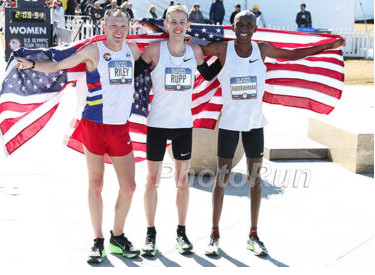
Rupp said that while gold is his aim, he wouldn’t be disappointed if he fails to win — indeed, in the last 113 years, only one American man, Frank Shorter, has accomplished the feat. Not all of his fellow Olympians shared that perspective, however.
“I’m going to be disappointed if you don’t win,” Tuliamuk joked. “No pressure.”
The one-year delay has helped Rupp more than most. Even before the pandemic, Rupp spent much of his time in his Portland home, which is equipped with a device that strips oxygen from the air to mimic the effects of high elevation. Staying home was not much of a challenge, though it did limit the amount his coach Mike Smith could visit him to oversee workouts.
From a running perspective, the extra year has given Rupp more time to adjust to Smith’s system. Under previous coach Alberto Salazar — whose appeal of his four-year ban for anti-doping violations will be heard by the Court of Arbitration for Sport next month — Rupp would hit each rep of his interval sessions “as hard as [he] could” and take a full rest before tackling the next one. Until he trained under Smith, Rupp had never run a fartlek. When Smith, the coach at Northern Arizona University, began working with Rupp in December 2019, he asked Rupp to turn over his previous training logs. The first thing he told Rupp after examining them?
“He didn’t think I was training much like a marathoner,” Rupp says. “There was still so much track stuff that I was doing.”
Now Rupp is growing accustomed to Smith’s system. He feels he works just as hard in practice, but the workouts are different: slower, with more reps and less recovery.
“Having some new stimulus, having some different workouts that I’ve been doing, it’s been a challenge, but it’s been really fun for me at the same time,” Rupp said. “…I couldn’t be happier with the way that things have worked out and where things are going.”
The delay has also allowed Rupp’s body extra time to heal. The Trials was just the second race Rupp finished following Achilles surgery in October 2018, and though Rupp estimated he was 90-95% healthy by the time of the Trials, he had not been able to string together a significant amount of pain-free running. Rupp admitted that, even after the Trials, “it hasn’t always been pretty,” but he feels he’s in a better spot now than he was a year ago.
“I’m optimistic about where I’m at physically and I couldn’t have said that over the last year,” Rupp said. “But I was really pleased with the way the Trials went and I think that I’ve grown a lot since then.”
The one annoying thing for Rupp has been the inability to race. Since the Trials, he has run just one: 60:22 for a low-key half marathon in October on an Oregon bike path. In years past, Rupp could at least gauge his fitness by comparing workouts splits to what he’d done before, but with a whole new set of workouts under Smith, even that is impossible. So Rupp is itching to race, but exactly where and when that will happen remains uncertain.
Rupp was hoping to do a marathon this month, but that proved untenable due to COVID travel restrictions. He is considering racing some shorter distances in the leadup to the Games. Given the flat course in Sapporo, Rupp believes it is important to improve is speed, which has been a recent emphasis in training.
"We want to get back into the swing of racing again,” Rupp said. “I think it’s important.”
by Let’s Run
Login to leave a comment
Asics The New Title Sponsor of Falmouth Road Race
ASICS has committed to a multi-year title sponsorship of the Falmouth Road Race, one of America's most iconic summer running events. The 7-mile road race, held each August on a coastal route from Woods Hole to Falmouth Heights on Cape Cod, had New Balance as its title sponsor from 2011 through 2019. The event was not held as an in-person road race in 2020 due to the pandemic.
"This partnership represents so much more than a sponsorship," explained ASICS Fitness Apps' general manager Alex Vander Hoeven through a statement. "It is a true example of how a world class event such as the Falmouth Road Race can collaborate with ASICS's global suite of products and digital services. We look forward to being on the course come race day and are honored to be part of the greater Falmouth Road Race community."
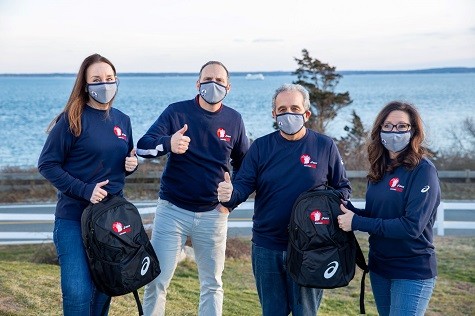
The Falmouth Road Race was founded in 1973 by the late Tommy Leonard, a bartender at the old Eliot Lounge in Boston. About 100 runners started that year in front of the Captain Kidd restaurant in Woods Hole and finished at old the Brothers 4 club in Falmouth Heights adjacent to Falmouth Heights Beach. Organizers use the same course today.
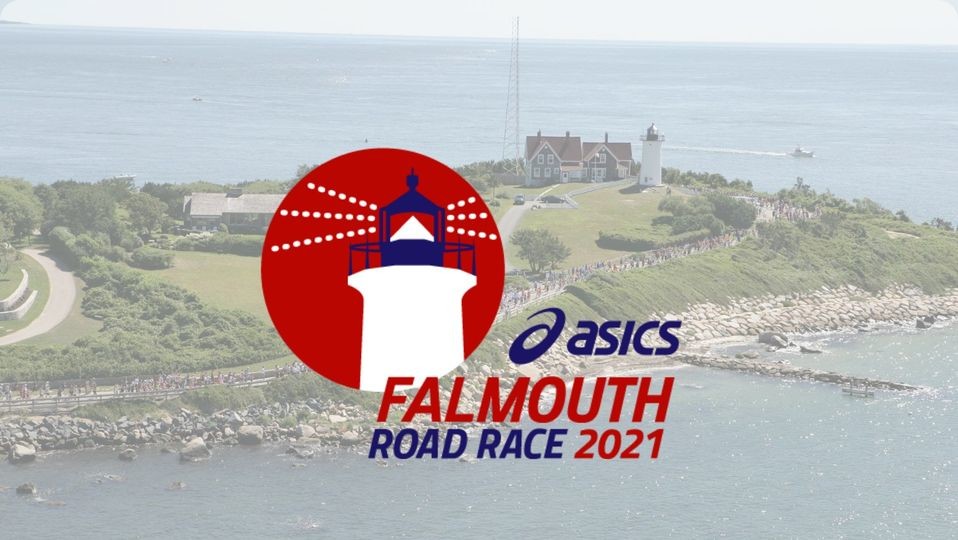
Some of the greatest distance runners in history have won the Falmouth Road Race including Khalid Khannouchi, Catherine Ndereba, Lynn Jennings, Benson Masya, Joan Samuelson, Bill Rodgers, Frank Shorter, and Grete Waitz. The 2019 champions were Leonard Korir of Colorado Springs, Colo., and Sharon Lokedi of Kenya. The 2019 race had 11,534 finishers.
"Our partnership is new, but we have long played host to ASICS athletes who have added much to our events," added Scott Ghelfi, president of the Falmouth Road Race, Inc., board of directors. "We look forward to having ASICS as a title partner that shares our commitment to health, wellness, and giving back to our community."
The 2021 ASICS Falmouth Road Race is scheduled for Sunday, August 15, pending approval from the Town of Falmouth.
by David Monti
Login to leave a comment
Falmouth Road Race
The Falmouth Road Race was established in 1973 and has become one of the premier running events of the summer season. Each year the race draws an international field of Olympians, elite runners and recreational runners out to enjoy the scenic 7-mile seaside course. The non-profit Falmouth Road Race organization is dedicated to promoting health and fitness for all in...
more...The Runner Statue-COVID-19 Mask Movement
Over the weekend, famous runner statues from Boston to Boulder donned a new look to support solidarity in slowing the coronavirus.
Runners are among the healthiest people. We prize and appreciate our good fortune, and want to encourage the same in others. We’d like everyone to be health—to follow federal guidelines, both for exercise and for disease prevention.
That was the thinking behind the Runner Statue-COVID-19 Mask movement. It began Saturday morning in Mystic, CT. By Sunday afternoon, it had spread to Cape Elizabeth, Maine, Hopkinton, Massachusetts, Central Park in New York City, Davenport, Iowa, and Boulder, Colorado.
In each location, a well-known runner statue is now wearing a low-tech protective face mask. The message: Do your part to prevent the spread of COVID-19.
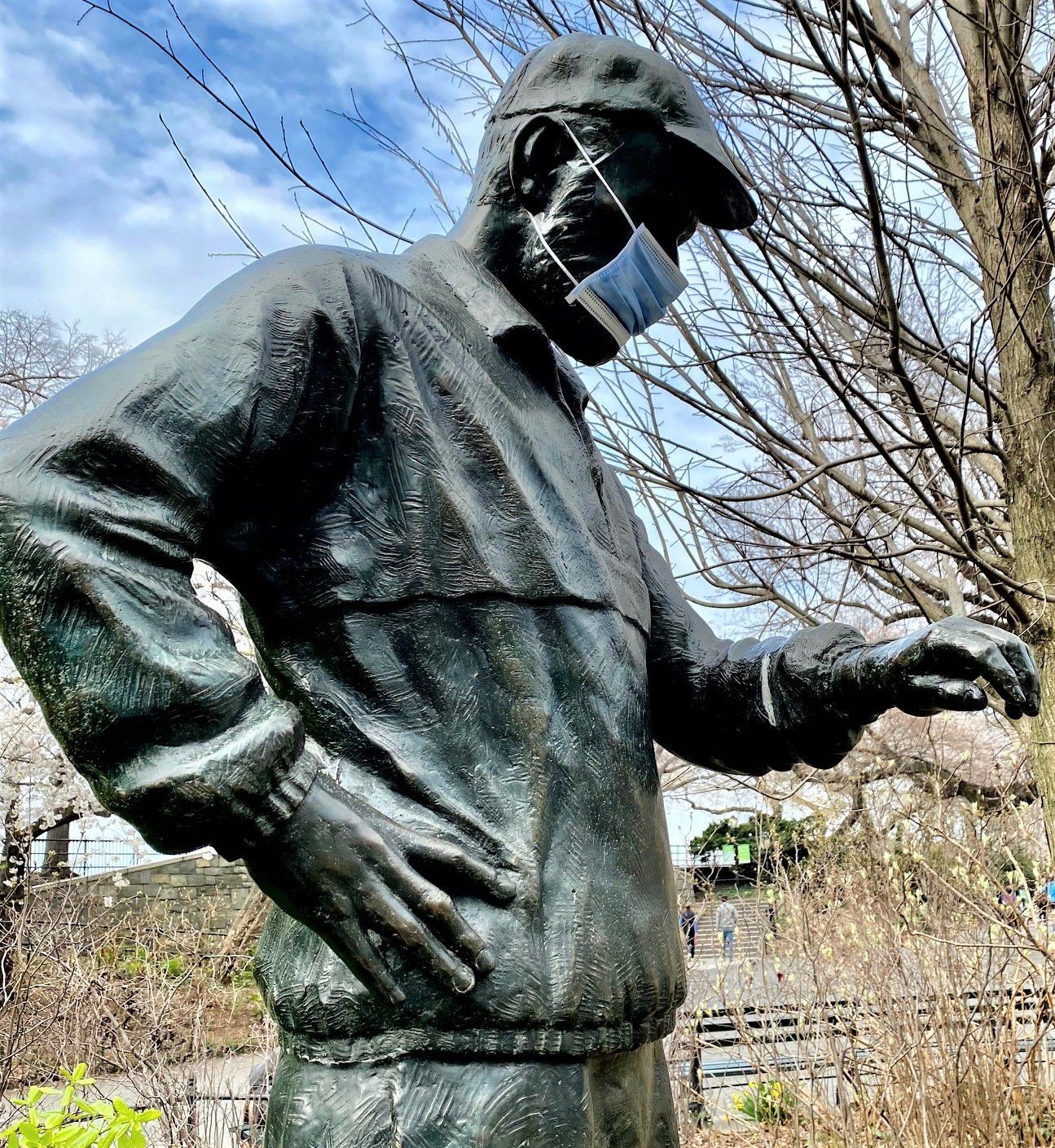
The Boston Marathon course has three such mask-wearing statues. In Hopkinton, “The Starter” George V. Brown wears a mask immediately adjacent to the Boston Marathon start line. Nearby, the statue of Rick and Dick Hoyt shows off their colorful masks.
Near the Marathon’s 19-mile mark in Newton, the double statue of “Old John” Kelley and his younger self shows them both wearing bandanna masks. These were fashioned by Ray Charbonneau from recycled road race t-shirts.
Born on a Morning Run
The story starts, like many, with a morning run. On Saturday morning, my wife, Cristina, and I met my brother, Gary, for an easy 3-mile jog on the banks of the meandering Mystic River in Connecticut. We had barely begun when Gary said, “You know what might be cool—to put a COVID mask on the Kelley statue.”
Mystics’s statue of John J. Kelley, 1957 Boston Marathon winner, has been a favorite local landmark for about five years now. It has a sparkling location in a tiny parklet that overlooks Mystic Pizza, made famous by the 1988 Julia Roberts movie. Before our biggest annual road races, Kelley is often attired in that’s year’s t-shirt.
Gary’s idea seemed so perfect that Cristina and I rushed home post-run to complete the mask project. To be honest, I merely “supervised,” since I have no sewing or crafting skills. Fortunately, Cristina is one of those creative types. She was even smart enough to realize that a statue mask would have to be larger than the bright masks she had already turned out for family members. Most statues are literally larger than life.
We rushed back to downtown Mystic to give Kel’ his new facemask. It was made of green shamrock material to honor his Irish roots. No one asked what we were doing, though several families strolled by and gave us an enthusiastic “thumbs up.”
Back home a few minutes later, I was ready for a nap. Then it hit me. I knew of a half-dozen other runner statues, and I knew runners who lived in those communities. What if I could get all those statues to wear covid masks?
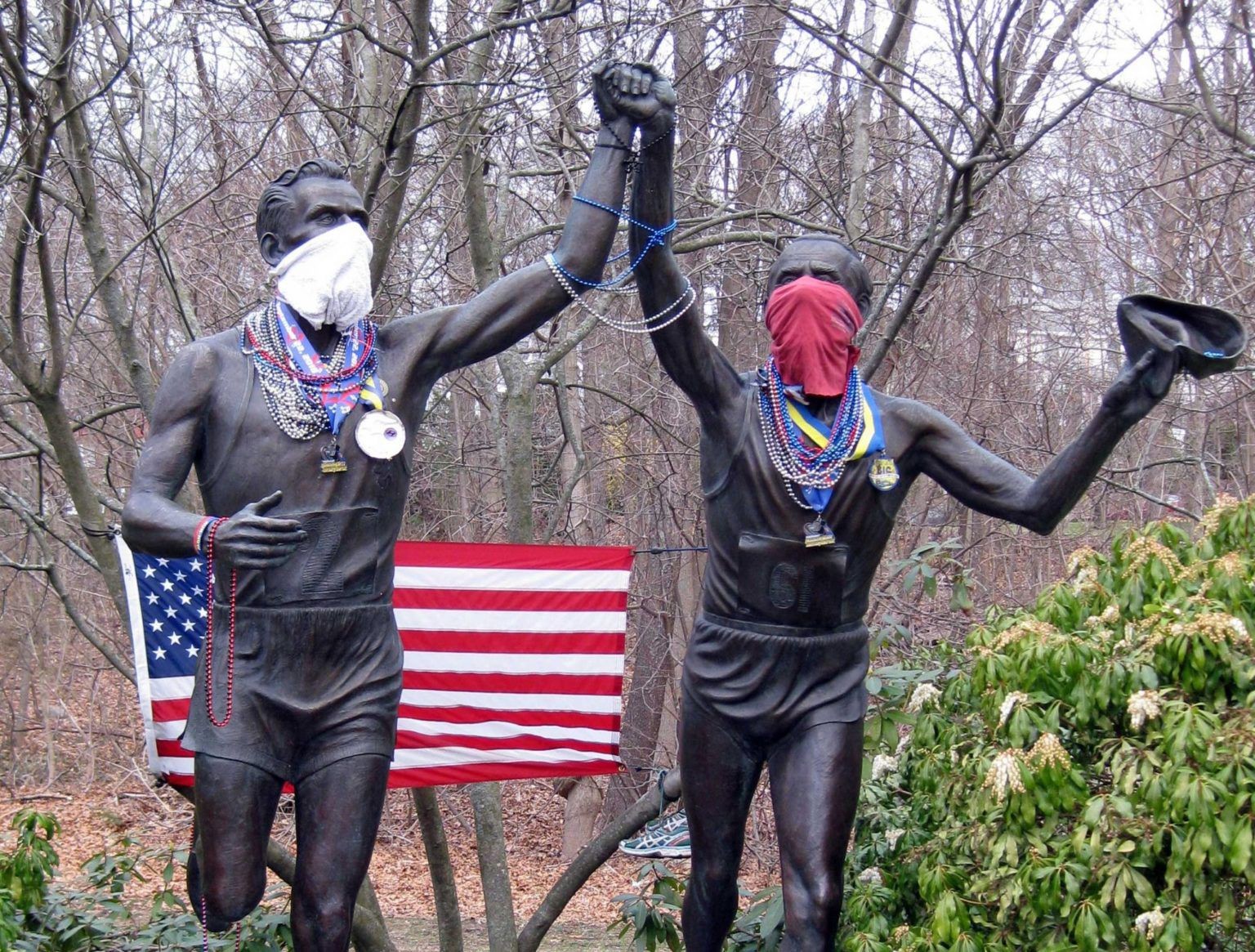
Idea Runs Across the Country
Honestly, it took little effort on my part. A handful of friends, both new and old, “ran” with the suggestion. In Central Park and Cape Elizabeth, police quickly descended on my mask-placing co-conspirators. Moments later, having heard an explanation for the masks, the very same officers volunteered to help.
My buddy in Cape Elizabeth needed it. Marty Clark was struggling on crutches to give Joan Benoit Samuelson a facelift. Now we’ll let you in on one of Joanie’s secrets: She has no ears. (Makes you more aerodynamic.) Or maybe she just has hair over her ears. In both Cape Elizabeth and Davenport, IA, where the Bix-7 has erected statues of Samuelson and Bill Rodgers, my friends had trouble keeping the mask in place.
But Bix race director Michelle Juehring persisted until she achieved success. “I love the solidarity of this project—the way it says we’re all in this together,” she observed.
Rodgers was a big fan from the get-go. “I’m so glad to be wearing a mask next to Joan Samuelson in Davenport,” he said. “If others see us, and then they wear a mask also, we’re going to beat this disease in America.
At Central Park’s reservoir, thronged with walkers and runners, a socially-distanced crowd gathered around the Fred Lebow statue. When the onlookers realized what was going on, they broke into applause. “I was stunned,” said Scott Lange, who once worked for Lebow at New York Road Runners.
In Boulder, Rich Castro got a mask onto Frank Shorter only a couple of hours after we began with Kelley in Connecticut. Castro had already worn a mask around town on his morning errands. “I hope more people help us spread the message,” he said. “There are too many nonbelievers around.”
Shorter concurred. “Any and all expressions of solidarity are a good thing,” he said.
In Hopkinton, where the Boston Marathon begins, Tim Kilduff found a talented high schooler, Emily Karp, to make masks and corralled a Hopkinton Board of Selectmen member (John Coutinho) and photographer (Bruce MacDonald) for the effort. Today, Monday April 6, this team plans to mask 1946 Boston winner Stylianos Kyriakides at the marathon’s 1-mile mark. (Look hereto see why this requires a special effort.)
“This has been fun,” Kilduff said. “It’s a good thing. I think it might really catch on.”
by Amby Burfoot (Podium Runner)
Login to leave a comment
Wayne Christopherson was the first Michigan runner to complete a renowned series of grueling 100-mile races
With his induction into the Alpena Sports Hall of Fame, Christopherson will become the first marathoner to be enshrined. He’ll be inducted as part of the Hall of Fame’s Class of 2018.
“I’m thankful that the sport of running is being recognized in and of itself. I’m not a multi-sport kind of a person; I run and I’m glad that’s being recognized,”Christopherson said. “I’m proud and honored to be recognized by peers and the community for the accomplishments I’ve had.”
Though he prefers to keep a low profile, Christopherson has gained a reputation as one of Alpena’s best distance runners during his long career.
He was the first Alpena (Michigan) runner to compete in the Boston Marathon and was the first Michigander to complete a renowned series of grueling 100-mile races.
Over the course of his career, Christopherson has completed 259 marathons and ultra-marathons.
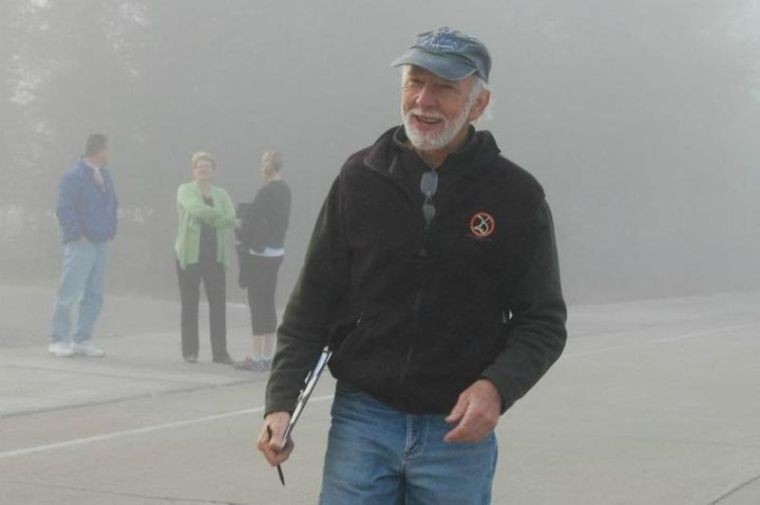
“Running, to me, has always been personal, and it was only to test myself and what limits I might have,” he said.
While many athletes develop a passion for different sports at an early age, Christopherson’s love of running was born of inspiration. He watched Frank Shorter win the gold medal in the marathon at the 1972 Summer Olympics, a moment that’s credited with igniting the running boom in the U.S.
Christopherson and other Alpena runners also followed the career of marathoner Bill Rogers, who became a Superman-like figure in the running world in the 1970s. Between 1976 and 1980, Rogers won three consecutive Boston Marathons and four straight New York City Marathons.
What stuck out to Christopherson about Rogers and Shorter, aside from their accomplishments, was that they seemed like everyday people who just happened to be good at running.
“They’re not a whole lot different than us. They’re little, skinny guys and they can run,” Wayne said. “I latched on to, ‘Wow, that’s quite a distance. I wonder if I could.’ The next thing I knew, I was running longer distances and finding out what it was all about.”
It’s something that still drives Christopherson today as he continues to compete at age 70.
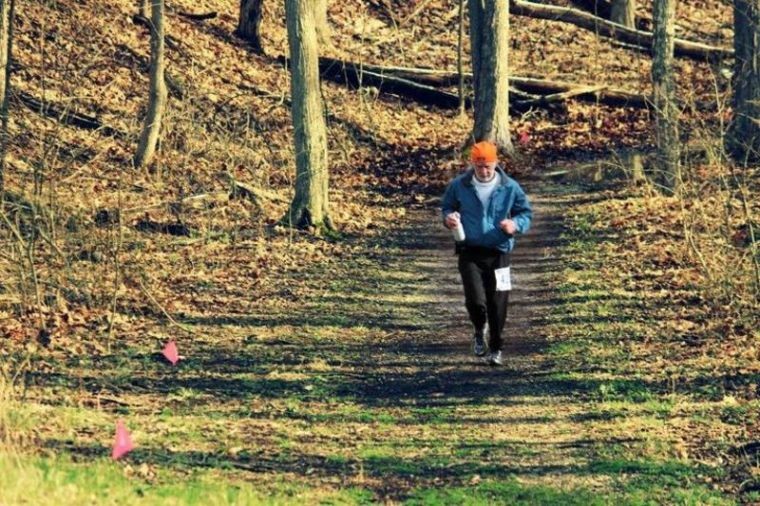
In 1986, Christopherson became Alpena’s first runner to compete in the Western States 100 in California, finishing in 23 hours, 17 minutes in his first attempt.
He completed the other three legs of the Big 4 in subsequent years–the Wasatch 100 (in Utah), the Old Dominion 100 (in Virginia) and the Leadville 100 (in Colorado). Christopherson was the first Michigander to complete all four.
Christopherson has never been afraid to challenge himself and his resume includes several other ultra-marathons, 33 Detroit Free Press Marathons, and more than 30 Bayshore Marathons in Traverse City. The Bayshore Marathon is a personal favorite, in part because it’s the site of his personal best time in a marathon: 2:45:13.
by James Andersen
Login to leave a comment
Bayshore Marathon
The Bayshore Marathon has become a “must run” for runners throughout the Midwest and beyond. Many runners return year after year to enjoy the scenic courses which run along the shores of beautiful Grand Traverse Bay. Hosted by Traverse City Track Club, Bayshore features a 10K, half marathon and full marathon. The number of runners in all three races is...
more...My Love Affair with Central Park started 40 years ago tonight - Larry Allen on Running File 5
If you want a useful guide for running in Central Park this isn’t that. There is plenty of concise information available online and all of it will do a far better job telling you exactly how to go for a run in New York City’s favorite 840 acre backyard.
If you want to know about beginning a long term relationship with New York City and running in Central Park, this is my story.
My first run in the park was on December 29, 1978. I was in college on the GI Bill and had taken my slightly unreliable but fun-to-drive MGB from Maine to Florida over Christmas break.
I didn’t want to think about the trip back north. Hitchhiking was still an option in those days if my car gave out but it surely was not what I wanted.
I was already a veteran of two marathons and was ramping up my mileage for the Boston Marathon the following April. I had a glorious couple of weeks of running in the technicolor light and warmth of south Florida and while there even managed to meet Frank Shorter.
I ran twice a day including a couple of two hour runs, went to empty beaches to bask in sunny 60 degree days while bundled up locals looked on, amused and mystified.
All in all it was a great time, went quickly and too soon I was starting the long drive back to Maine.
A couple of uneventful days on the road brought me back to the NJ turnpike two days before New Year Eve. In the fading light of a cold, clear winter afternoon I pulled into a service plaza for gas.
My plan was to continue driving on through the night for the last 500 plus miles vs. spending money I didn’t have for a roadside motel room. A “you are here” map in the foyer of the restroom surprised me with my close proximity to NYC.
The next thing I remember is rummaging through the stuff in my car for an address book with the phone number of a longtime summer friend from Maine who spent the balance of his life on upper west side of New York.
I searched between the seats for change to make a call on a pay phone and was fortunate that my friend even answered. He graciously said I could crash for the night.
I’d never even been into NYC proper and the prospects for the evening were exciting if not a little intimidating.
I finally made it safely down from the high bridge over the Hudson River into the city and found a place to park near Grant’s Tomb on Riverside Drive, a few blocks west of my friend’s apartment not far from Columbia University.
I made the wise choice to schlep all of my stuff to the apartment for fear that the patched convertible top and dodgy locks of my car wouldn’t deter anyone in 1970s NYC, from breaking in looking for anything of value.
I said a quick hello and thank you to my friend on arrival but needed a run before I could eat or do anything else. He understood and gave me directions to Central Park and showed me how to buzz myself back into his high rise building.
Running down Broadway entailed dodging and weaving along hopelessly crowded evening sidewalks, scents from all manner of ethnic food wafting as I made my way through the 20 red lights, one per block, for a mile.
Eventually a left turn, to the east for a few more blocks to enter the park around 100th St at Central Park West.
The park was dark and cold, full of energy but it oddly felt peaceful too. The air was filled with different smells; diesel bus fumes, horse manure, musty fallen leaves, street pretzels, roasted nuts and yes, adrenaline, some of it mine.
Traffic hadn’t been banned from the park drives in the evening yet so it was full of yellow cabs and giant 70s era sedans moving slowly in heavy evening traffic.
I looked around for a landmark, something to remember so I could find my way back out of the park onto the same street in hopes of finding my way back to my friend’s place through what felt like barely contained chaos on the city streets.
I took note of a broken, graffiti covered park bench in this far less than gentrified version of the city. It seemed memorable enough and I guess it was.
Inside the park there was a lane for running. Parallel were two traffic lanes around what I’d been told was a six mile loop circling the park just inside the perimeter.
In spite of the hummock and pot-hole filled streets, particularly in the nearly bankrupt version of the city at the time, I recall the park drives being remarkably smooth pavement.
I turned right, running downtown on the west side. The rolling hills also seemed more downhill than up too, something I confirmed in years and miles to come.
At first it was a gentle contained pace, working out the stiffness in my legs and back after a day long drive from North Carolina on a bad suspension and the hard seats in my car.
The grade of the rolling hills and gently winding turns in the park seemed worn-in to the landscape. It felt perfect for running, almost carved into the city like the equivalent of glacial wear but from the mass of some number of the eight million city residents using the park day after day.
Making my way down the west side for a mile offered peeks through the leafless trees and scenic overlooks of the lights and architecture of pre war apartment buildings forming what appeared to be a tall, impenetrable wall along the avenue fronting the park.
Periodically there were glimpses further downtown to the iconic skyscrapers in midtown. The Empire State Building and Chrysler Building most familiar amongst a forest of others that seemed just as big if not as well known.
I simply didn’t want to stop running, the pull was almost magnetic, my tempo gradually increasing around the next corner or over the next hill, all just to see what was ahead.
It was all a bit like a party that you didn’t want to leave for fear of missing something good that might happen.
Just before reaching a first opportunity to choose between veering left from the main park drive or continuing straight toward the high rises of midtown; I went by what, in a few years, would be renamed Strawberry Fields. It was in honor of John Lennon; murdered not far away at the entrance to his building, the Dakota, which overlooks the park here.
The park is a perfect rectangle, slightly off of an exact north to south axis extending from 110th St to 59th St., 2.5 miles on each side and slightly over .75 mile between 5th Avenue on the east side and Central Park West on the other.
Years later I learned that the cutoff (or shortcut) I had seen and gone by at 72nd St and another I hadn’t reached yet at 102nd St made for a seemingly endless variety of options for creating and running multiples of loops of 2, 4, 5 miles and of course the full 6 mile circuit.
The New York Road Runners used the counterclockwise 6+ miles of the full park four times plus the slightly less than two mile loop from the bottom of the park to 72nd St for the 26 miles 385 yards for the 55 finishers of first New York Marathon in 1970.
The marathon still uses the park, but only about half of it for part of the final three miles of the race.
I read somewhere that 20,000 people run in Central Park on an average day. There are days and seasons during the year when that number seems high but other days and times during the year when it is certainly low. I guess that’s what they mean by average.
There are over 30 races in Central Park every year. Most hosted by the New York Road Runners Club and a few by other organizations.
Nearly all have thousands of participants, racing distances ranging from a 1 mile kids race to a 60k ultra marathon. Some with top invited international and American stars, some simply very large competitive local races. Every one a variation in the options for running loops in the park.
I continued running through the park, next past a big open meadow on the left, learning later that it was the 15 acre Sheep’s Meadow.
It has been a historic spot for protests over the past 100 years, up to 30,000 sunbathers on a nice day and 150,000 for a Barbra Streisand concert in the 1960s and yes sheep, from the 1860s until the 1930s.
Adjacent to the finish line of the marathon at Tavern on the Green the meadow also was a post race staging area for a few years.
22 months after my first run in the park I was back here, finishing my first marathon in New York. My last run up the hill to that familiar finish line was 32 years later.
The buildings along the southern edge of the park loom up just a few hundred yards away from the marathon finish. Columbus Circle marks one of the four corners of the park here and is a block from where I lived for 10 years when I finally moved to the city.
Almost every day was a 15 minute walk home from work at MoMA for me, dogs out for a walk and then into the park for an evening run. Sometimes clockwise, up the westside, the opposite direction of my first run.
Often I ran the same counterclockwise direction I was running that night. Across the bottom of the park to the east side, the legendary Plaza Hotel, the Central Park Zoo and the Wollman Skating rink anchoring the corner on that side.
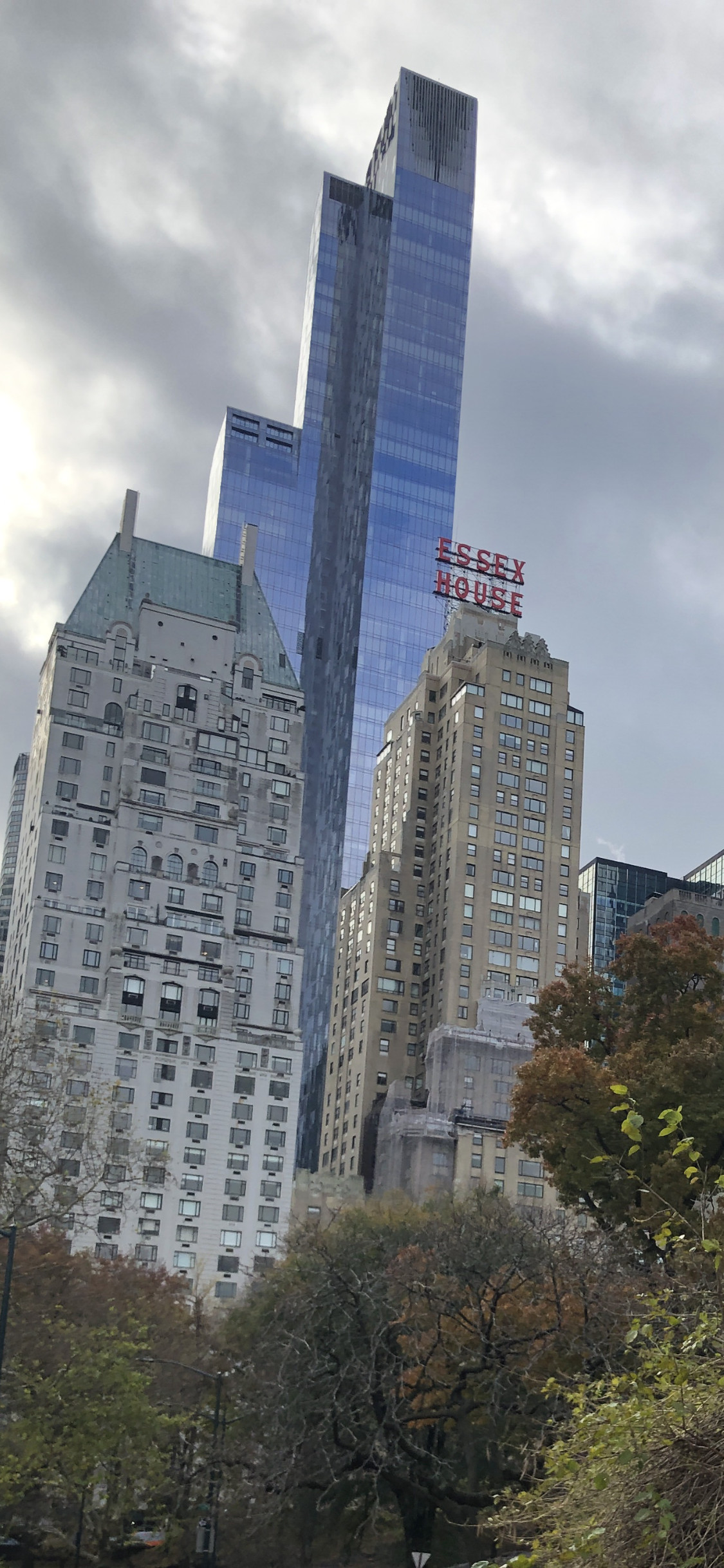
I saw the familiar sign for the Essex House hotel along the way on my first run in the park that night and invariably still take a glance up at it on every run 40 years later.
Turning back north on the east side of the park led me up a gentle hill through dramatic exposed rock outcroppings of Manhattan’s bedrock schist. Apparently something which allowed New York to more easily build foundations for it’s famous skyscrapers over the last century.
I ran past playgrounds, the 100 year old children’s carousel and about a mile beyond Columbus Circle, to the other end of the 72nd St cutoff.
In years ahead it became a familiar corner. Nearby is the start and finish for the New Years Eve 4 mile race in the park, starting at the stroke of midnight with fireworks.
The corner is also near the start of one of the bigger hills in the park, this one known among local runners as “cat hill”. Midway up the 1/4 mile climb is a sculpture of a life sized and menacing mountain lion, seemingly ready to pounce from a natural stone overhang directly over the runner’s lane.
It was too dark to see the cat that night but is familiar enough now. Cat hill is a popular place for training for some of the dozens of running clubs that meet up and use the park for weekly group training sessions.
A couple of minutes more led me past what I didn’t know at the time was the back of the massive Metropolitan Museum of Art. Around it and closer to 5th Avenue for another half mile brought me near a building I did recognize, Frank Lloyd Wright’s landmark cylindrical Guggenheim Museum.
The nearby entrance to the park would become familiar later as the place where the marathon enters the park for the last 2.5 miles of the race headed back in the direction from which I’d just come.
The summer after my first NY marathon and having entering my 2nd, there was a fundraising appeal in my race confirmation. The NYRR was trying to raise money to purchase a six story Beaux Arts townhouse just opposite the Guggenheim for one million dollars.
They were successful and for 36 years it served as headquarters, clubhouse and place to pick up bibs for their many races. It was listed for sale this past year for 25 million dollars as they apparently need something fancier and/or bigger.
Nearby is a statue of the late, charismatic leader of the NYRR, Fred Lebow. His vision arguably responsible for the explosive growth of urban marathons around the world for decades. His likeness stands looking at a stopwatch, appearing to be silently calling out time splits to runners just inside the park.
The entrance of the 1.5 mile long reservoir running path is there too, named for Jacquelin Kennedy Onassis, a nearby resident for decades, she was known to jog on the scenic cinder path and reportedly was even seen wearing long white formal evening dress gloves on cool days.
At the reservoir it felt like I had run between 5-6 miles, I knew it was six around the park but then maybe 10 minutes more to and from my friends place.
I was moving along briskly, feeling good but thinking I should get back but had reached the point where it made more sense to continue on vs. turning back. Maybe three miles to go.
Just 1/4 mile past the flat straight section along the reservoir the drive started down a hill and turned toward the center of the park from the perimeter. I felt a change. There were fewer street lights, less traffic and not as many people around. It all seemed a bit more ominous.
A half mile further brought me to the 2nd cutoff between the east side and the west. This one at 102nd St. It was very dark, narrow and almost foreboding.
In 1989 this section of the park, down the hill from the reservoir to the 102nd St cutoff became notorious as the site of a series of “wilding” gang assaults on a number of runners and pedestrians over one hour on a frightening night that April. It culminated in the vicious assault and rape of the “Central Park jogger” on the cutoff road I was passing.
Even 11 years prior to that night it felt dangerous. Today most runners and running clubs practice a buddy system when running at night in the park as a result of what happened in 1989.
There is a prominent police presence in this area and thankfully crime in the city and the park has declined precipitously too.
In all of my thousands of miles in the park over the years, many at night, I’ve never personally experienced a threat or even witnessed one and I’m grateful for that.
The almost kaleidoscopic park quickly changes again at the far north end. The park drive quickly snakes through a steep S shaped descent with high bluffs overhead on one side and an open high view of Harlem on the other; the Meer waters and the Conservatory Gardens in the foreground.
The far north end of the park remains the most natural with unspoiled ravines, dramatic rock faces, waterfalls and streams all tucked away.
On runs here I’ve seen families of raccoons crossing the road at night and hawks swoop down for unsuspecting squirrels during the day but nothing of the sort on this particular night.
Midway down the hill brought me past a large skating rink outfitted for youth hockey. I learned later that it does double duty as a community pool in the summer.
Now at the north edge of the park I could see into Harlem. I made the turn, running to the west. Just outside the park were dilapidated tire changing shops, gas stations, boarded up windows, burned out cars and a trash can with a makeshift bonfire offering warmth to a few men huddled around.
Continuing on, anticipating a turn to the south to complete my circuit of the park it quickly became evident that I was going to climb a good hill.
Runners in NY refer to this climb with some dread as THE Harlem Hill, it climbs about 150 ft in half a mile and then just as quickly drops down again. I wasn’t far beyond where it leveled out again and suddenly on my right, there it was!
The familiar broken, graffiti covered bench that I’d decided to use as part of my trail of bread crumbs when I entered the park.
Not much had changed on the surface. Traffic had lessened somewhat as the evening rush was concluding. The smells were the same but had become permanently imprinted in my brain vs. something new to experience.
I slowed my pace for the few blocks back toward Broadway and a final right turn north for the last mile up toward Columbia.
After less than an hour on foot I felt like I understood New York to some extent....and I liked it. The prospects for the evening seemed exciting enough when I decided to spend the night but I had no idea.
Even before I finished the run one big thing had changed. I knew or at least hoped that I’d spend part of my life in the city.
My wife, step daughter and I have been fortunate to have lived the last 21 years of our life together in New York and adjacent to Central Park, 10 years on one corner of the park and the last 11 years a few blocks from the far opposite corner. In part, all due to one unforgettable run around Central Park on a cold December night 40 years ago tonight.
(Larry Allen on Running is an exclusive My Best Runs Running News Daily feature. Additionally Larry is doing the Run The World Challenge for the third time.)
by Larry Allen
Login to leave a comment
He hopes to be the only man on earth to run a sub three hour marathon in six consecutive decades - Marathon Man Gary Allen introduction
Gary Allen is going to sharing his thoughts and knowledge here in MBR’s Running News Daily under the banner “Marathon Man Gary Allen.”
In his first column I sent him some questions so we all could get a flavor of what makes this incredibly creative and talented man tick. I know I am looking forward to his writings here and I hope you are too!
So Gary, how did you discover running?
”I wanted to be a hockey player,” wrote Gary “but there weren’t enough kids on the small Maine Island I am from for a team. Then in 1972 I saw a skinny guy named Frank Shorter run into a stadium in Munich and I was like cool, you can win a gold medal just for running.”
How important is running to you?
“I have been involved with running for my entire life so assigning importance to who and what I am is like trying to describe how big the universe is to an ant. It is impossible for me to adequately portray how all encompassing running is to me as a part of my life,” says Gary.
Does being an accomplished runner help you put on first class events?
“Absolutely! The races I direct are direct reflections of what and how I expect races to be run. I would never ask anyone to do something I haven’t done so I merely apply my expectations and my creativity to every race I help to organize.”
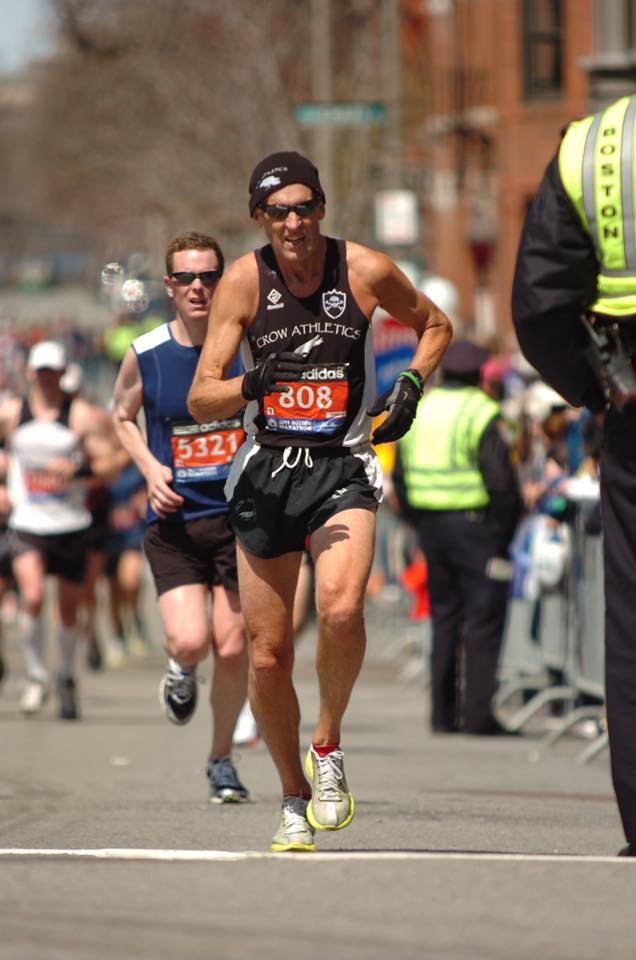
What one race you have run stands out as number one?
“Ahhhhh I can’t narrow it down to one race. However, Boston is always high on every list. I have one more to run to make a quarter century of unicorn chasing. The Burning Man ultra (photo) is a race I love beyond words. It helped change my thinking about how races run.
“A combination of an other worldly environment and no entry fee helped to expand my thinking. NYC (19 finishes) is where I was inspired to become a race director after watching Fred Lebow in action in 1980. It is reality true, if you can make it there you can make it anywhere!
Tell us about your coaching?
“I have coached at the HS level and coached many individuals over the years but my current team is at Mount Desert Elementary School where I have been the XC coach for the past 12 years.
“My philosophy is pretty simple, make running fun and kids will want to run more and the more they run the better they get at running which is of course even more fun for them!
“One of of our key workouts is called, zombie tag. We run in the surrounding Maine woods and trails and I assign a few zombies and the rest of the team tries to run away and not get caught.
“I also love to hide pizzas in the woods and have the kids run around and find them! Apparently my methods work cause in the past decade plus we have won almost every meet we’ve run!”
What are your personal goals as a runner?
“As a race director: I want to leave our sport better than I found it.
”As a coach: I want to inspire the next generations of runners to think about running for their entire lives. Rather they run or not matters little, but I want them to always remember and to love running knowing some will go on and be involved in our sport as competitors, coaches or even as race directors.
”As a competitor: I have accomplished pretty much every goal I’ve set for myself. Of late I struggle some with the naturally selfish nature of being a long distance runner.
“The single dimensional, ‘I’m training for,’ ‘Look at me’ has become less and less appealing to me over the years.
“As you know one of my proudest achievements is joining the five decades Sub 3 hour marathon club. At this point nobody on earth has run a sub 3 hr marathon in six consecutive decades so maybe it’ll give it a shot in 2020!
“Incidentally Joan Benoit Samuelson is the only other Mainer on the list and the only woman who has done this and I wouldn’t count out Joanie to run a sub 3 for her 6th decade.
Can you give us some background info?
“For Work: Lobsterman, Boat Builder, Carpenter, Yacht captain, Farmer, Auctioneer, Coach, Inspirational speaker.”
”Some Personal Records: Marathon 2:39:10, Half Marathon 1:13:20, 50 miles 6:21.
”My family settled on Great Cranberry Island in the 1670s. I am 12th generation. It’s a small offshore Island off the coast of Maine. It’s probably the most unlikely place to become a runner as the main road is only two miles long. I built my own house by hand from trees growing on my land. I dug my well with a shovel figuring they used to do it that way so why couldn’t I?”
by Bob Anderson
Login to leave a comment
How Boulder Colorado became the Mecca for elite distance runners and runners of all abilities
DID YOU KNOW: Frank Shorter helped turn Boulder into the mecca for elite distance runners and hotbed for recreational athletes that it is today.
The two-time medalist, gold in 1972, silver in 1976, came to Boulder for the first time after graduating from Yale. Raised in New York, Shorter became an early believer in the benefits of altitude training.
In setting his course for Olympic glory, he chose Boulder because the University of Colorado had the only indoor track above 5,000 feet in the United States. He remembers only a couple of other post-collegiate runners in town at the time, including a hotel dishwasher who ran a crash pad for hippies.
Two years after his first training stint in Boulder, Shorter became the first American in 64 years to win an Olympic marathon.
Shorter’s historic breakthrough at the Munich Olympics, coupled with his silver medal four years later in Montreal, helped ignite the recreational running boom of the late 1970s, and inspired subsequent Olympic hopefuls to move to Boulder for the same reasons he did.
Then-exceptional international runners, including three world-record holders, arrived in the ’80s. After that came the world-class cyclists and triathletes. Meanwhile, CU emerged as a power in cross country running, producing six individual national champions and seven team titles.
Today, Boulder teems with world-class endurance athletes and some of the country’s fastest recreational runners, and it all traces back to Shorter’s hunch about altitude training. Runners of that era didn’t know why it worked — scientific explanations would come later — they just knew if they trained at altitude, they ran faster when they raced at sea level.
“I sensed it,” Shorter said. “There was no real science you could look at. I didn’t know your blood volume increased. All I knew was that I was getting better, more on an exponential curve than even a straight line. I knew that there was something about doing it that didn’t just have to do with my increased training intensity.”
by John Meyer/ The Denver Post
Login to leave a comment
Shalane Flanagan’s Mother once held the World Record in the Marathon
DID YOU KNOW: Cheryl Bridges, now Cheryl Treworgy, once held the American and world record in the marathon. Cheryl Bridges was born December 25, 1947 in Indiana.
She began her running career as a sophomore at North Central High School in Indianapolis. In her senior year in high school, she competed in the national cross-country championships. In 1966, she became the first female athlete in the U.S. to receive an athletic scholarship to a public university — Indiana State University. She graduated in three years with a degree in physical education.
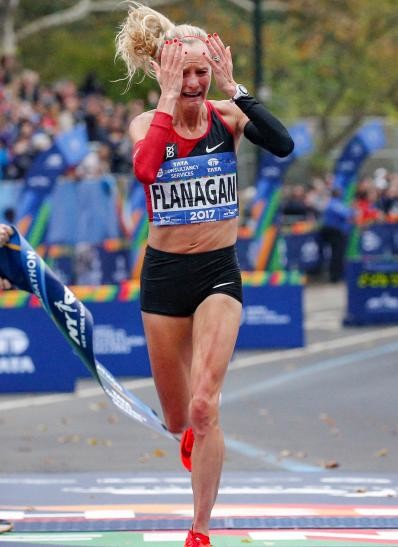
In 1969, she finished fourth in the World Cross Country Championships in Scotland. She set the American records in the 3 mile and 5,000 meter distances. On December 7, 1971, Bridges ran her first marathon, finishing the Culver City Marathon in a world record time of 2:49:40.
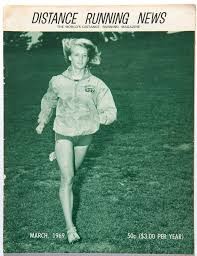
She had a lot of ideas and ambitions. She was the holder of a patent on utility sports bras and was the former buyer and part-owner of Frank Shorter Sports stores.
Cheryl, now 70, is a professional photographer for her own company, Pretty Sporty, and was recognized in 2010 as Track and Field Writers of America Photographer of the year.
Cheryl is the mother of Shalane Flanagan, who among other achievements set an American record in the 2008 Summer Olympics Beijing in the 10,000m and won the New York City marathon on November 5, 2017.
Shalane is going after a dream on Monday. This dream is to win the Boston Marathon. Her mom would be proud.
Cheryl Bridges appeared on the March 1969 cover of Distance Running News.
Login to leave a comment
Boston narrated by Matt Damon on the big screen April 12-19 in Boston
Login to leave a comment


